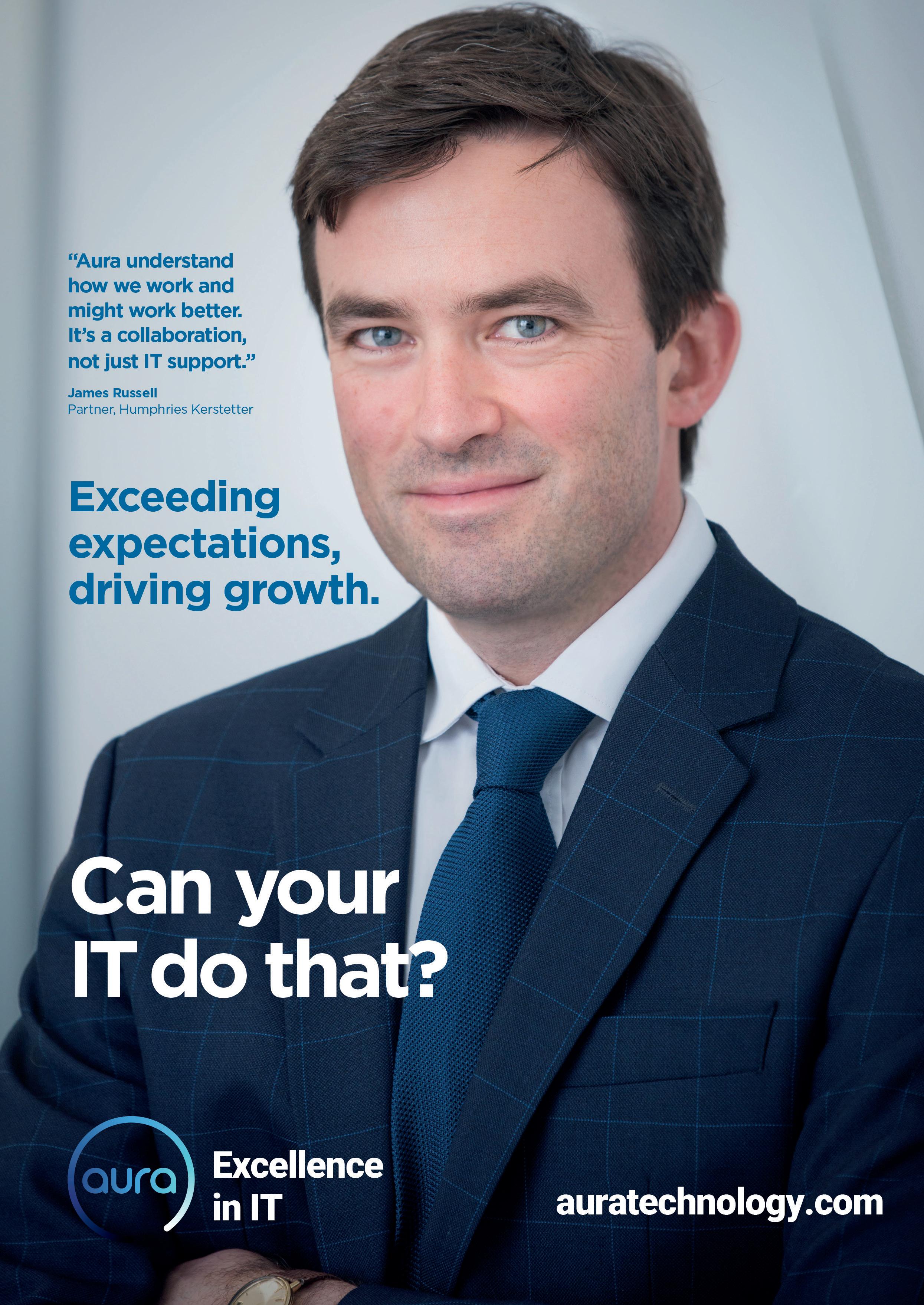POWERHOUSES



I am fortunate enough to chair some of the many roundtable discussions that The Business Magazine organises each year and every one offers up fascinating insights.
It is an excellent litmus test for the south east economy as we gain an understanding of how business leaders think, how confident they are of their prospects now, and what they think the future holds.
Over the past six months we have held two roundtables on Employee Ownership, in partnership with Fieldfisher and Shawbrook Bank, which are covered in this magazine alongside a guide on the intricacies of leaving your employees in charge once you exit the business.
There was, from the many founders that attended, a real emotional attachment to the businesses they had built up and a desire to protect their employees and keep their business in its current location.
We also held another round table in partnership with Herrington Carmichael which focused on hospitality. It demonstrated how robust and up for a fight this industry is as stories

of pandemic business survival were recounted.
The sector isn’t out of the woods yet as labour shortages and rising costs continue to bite, however the resounding message from the discussion was that the industry must adapt if it is to survive.
In this issue we also speak to John Phillipou of Paragon Bank about the early lessons learned in his banking career, including noticing the small details and building up a big picture, which continue to serve him well to this day.
We also speak to Dominique Tillen of Brush-Baby about her child friendly toothbrushes that are now sold around the world.
The Business Magazine Property Podcast launched earlier this year and is aimed at people working with the industry.
It can be found on all readily available podcast channels and covers topics from sustainability to auctions.
Please do give it a listen and let us know what you like, dislike or want to see more of.
Stephen Emerson Managing Editor stephen.emerson@thebusinessmagazine.co.uk
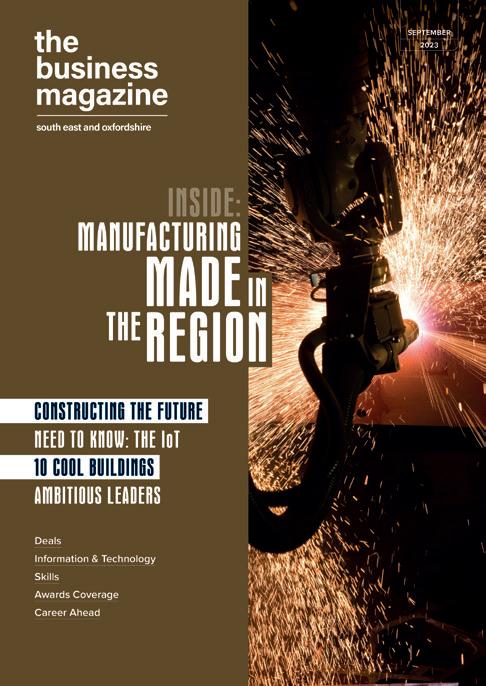
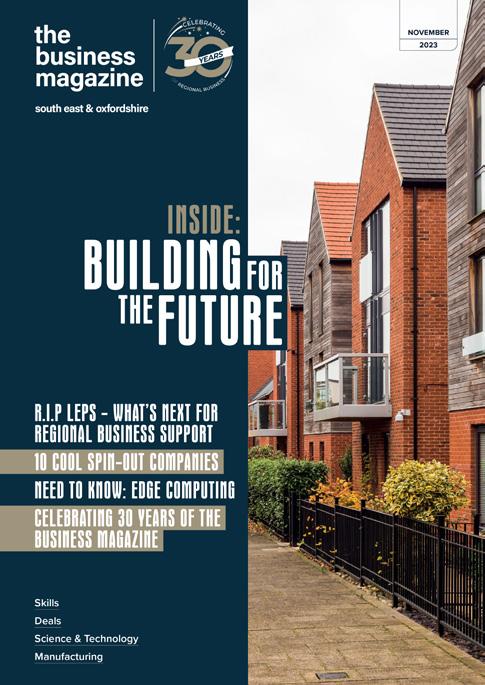

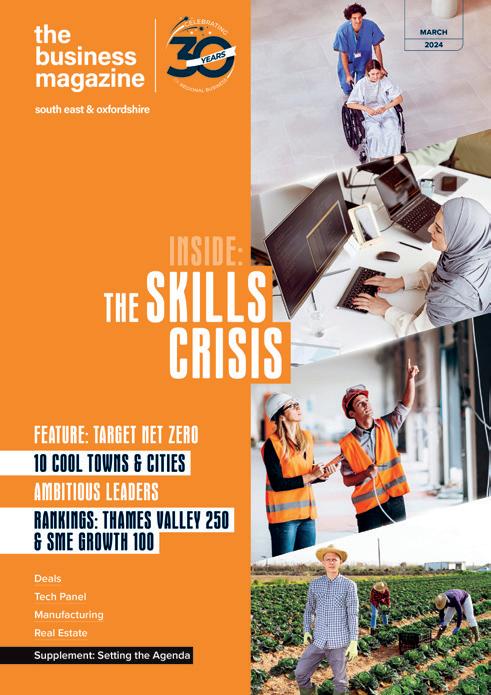



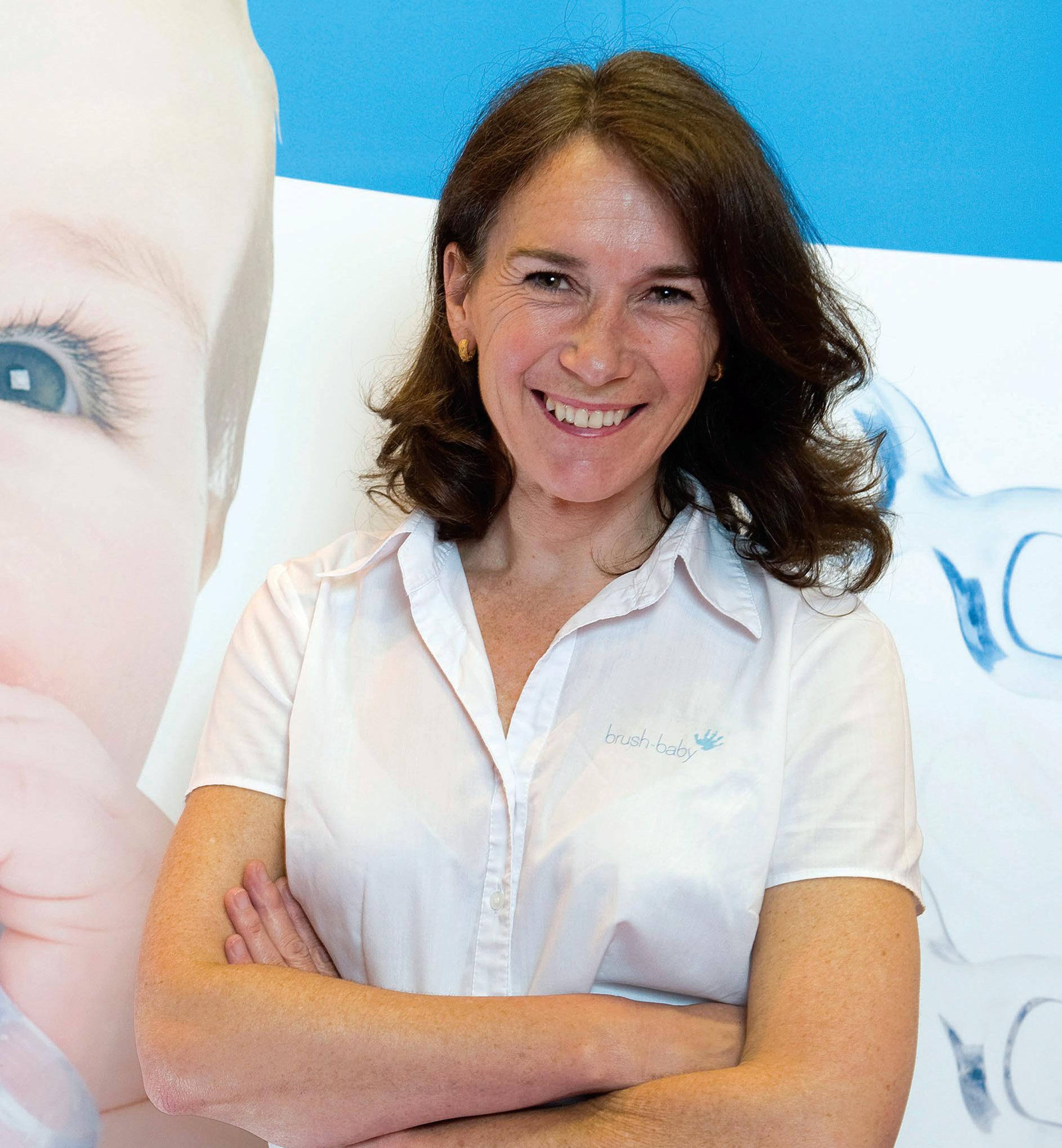
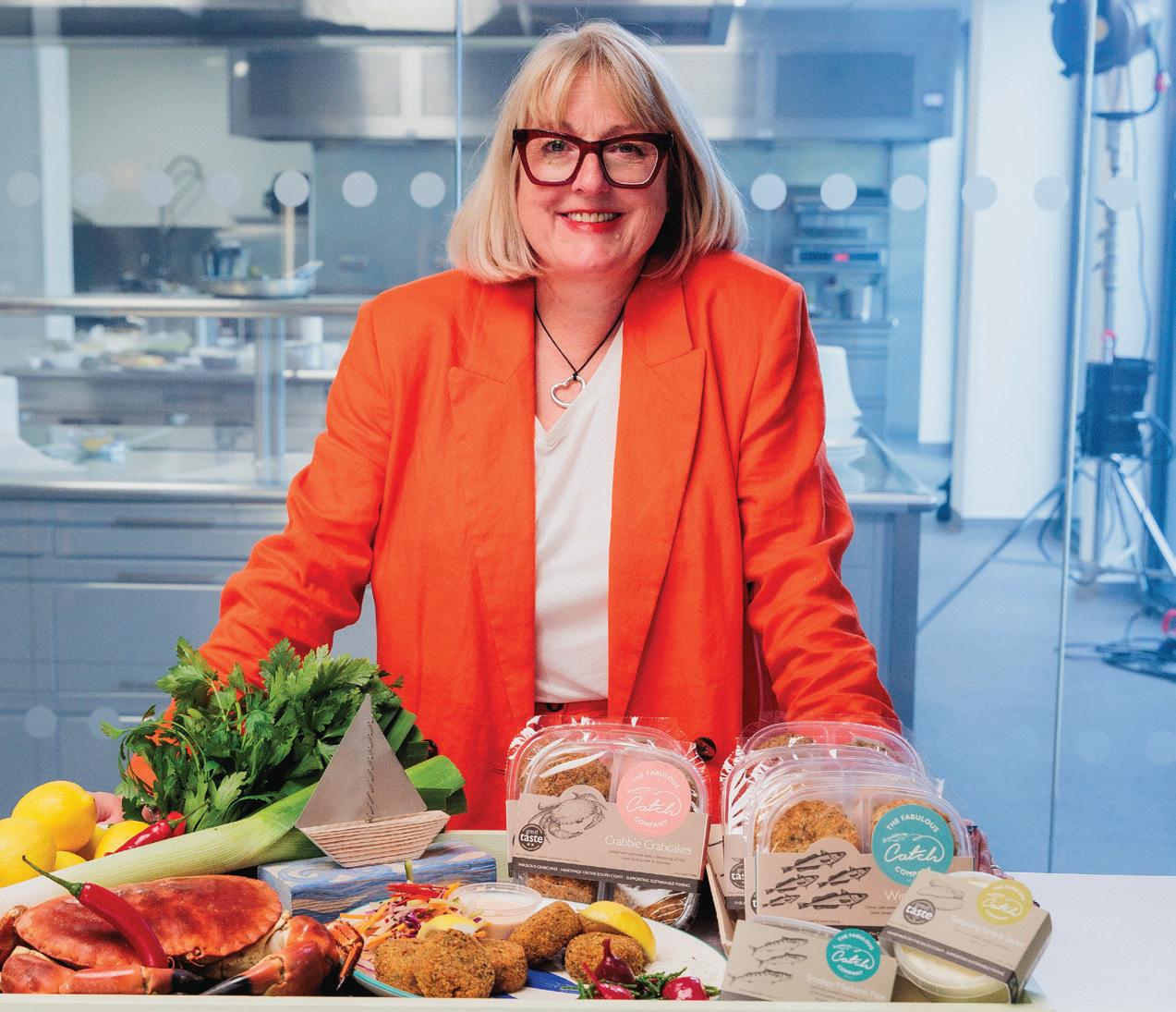

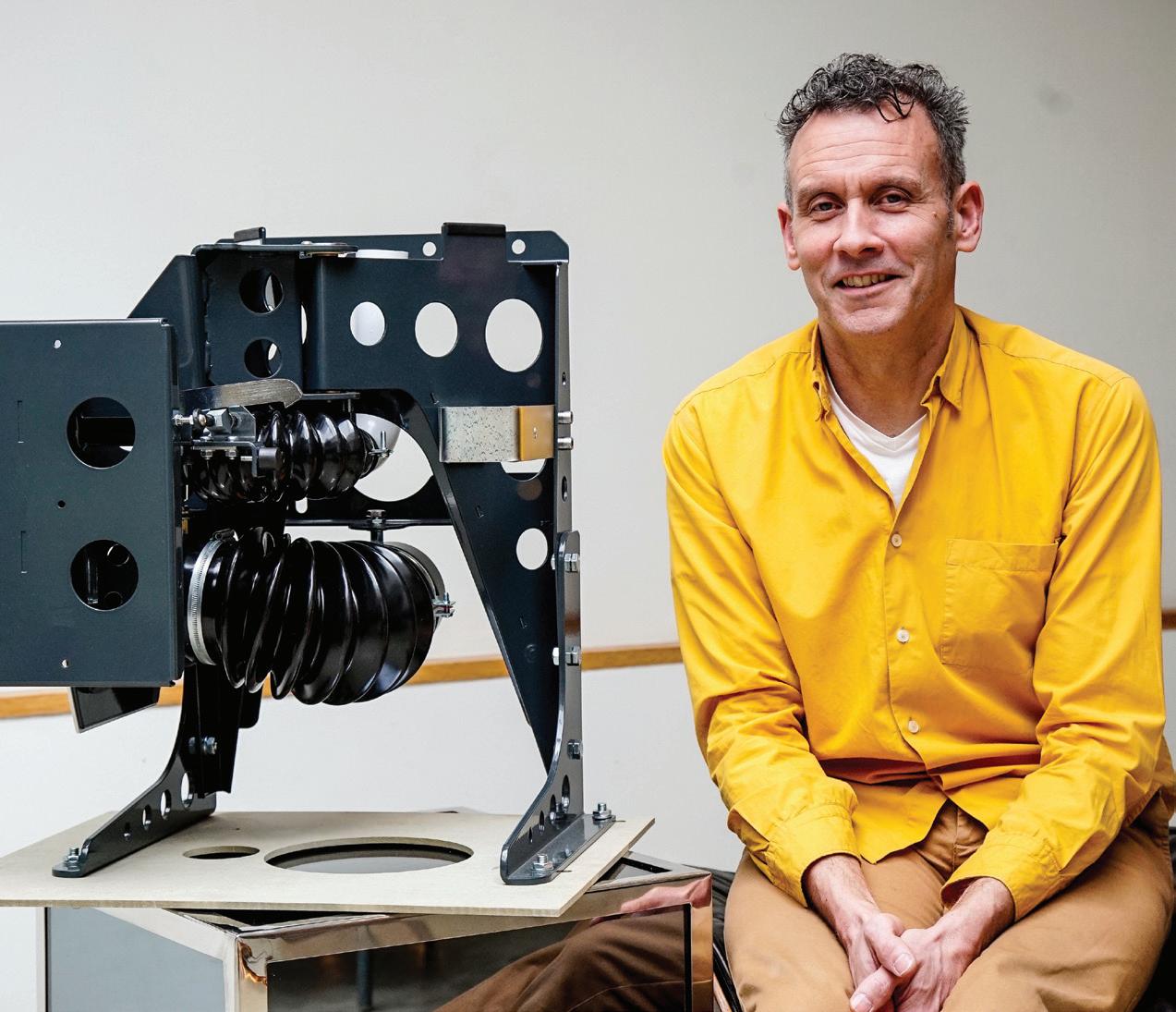

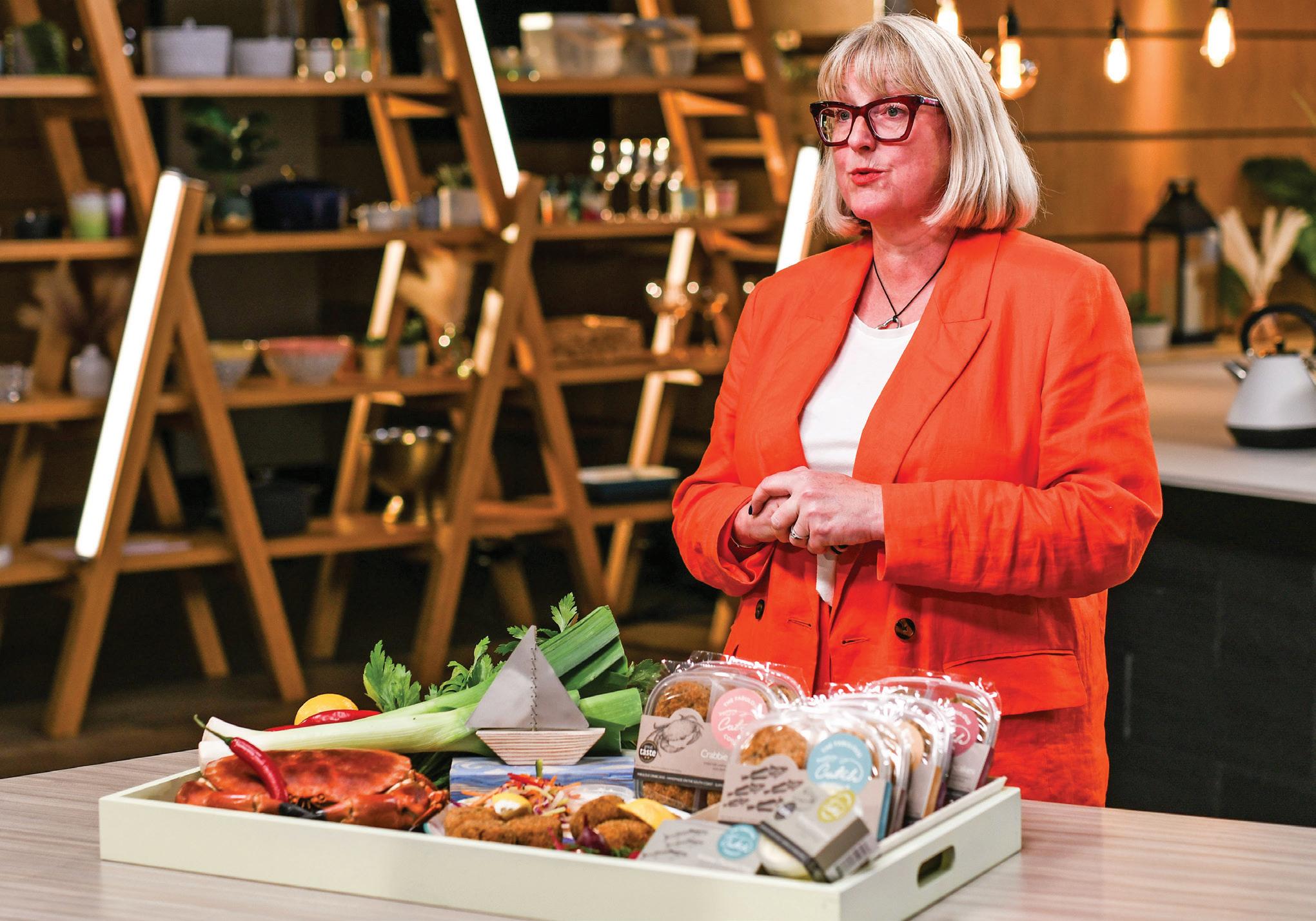
The power of TV was evident for an independent fishcake business producing sustainable British fish products.
Hayley Elston’s business, The Fabulous Catch Company, based in the New Forest, landed a contract with supermarket Aldi after it picked her award-winning Crabulous Crabcakes to stock as a “specialbuy” in stores nationwide.
Aldi selected Hayley’s zero waste crabcakes as part of the Channel 4 series Aldi’s Next Big Thing, now in its second season. Hayley was one of hundreds of applicants competing to stock Aldi stores nationwide.
Each episode sees hopeful suppliers compete for shelf space before Julie Ashfield, Managing Director of Buying at Aldi UK, decides on a winner which will appear as a Specialbuy in more than 1,000 stores.
The Fabulous Catch Company’s Crabulous Crabcakes beat five other hopefuls, including a gourmet mac and cheese by Stormzy’s private chef.
Hayley’s fishcakes use brown crab meat, and she adds leeks, chilli, fresh parsley and lemon juice.
Julie loved the taste, but as a four-pack weighing less than Aldi’s twin variety (and at double the price of its gastro version), Hayley was told she needed to scale up her product, not lose consistency and deliver in volume to win the order.
Hayley finally secured an order to supply Aldi with 50,000, which the judges said tasted even better than the first batch.
Hayley saw a business opportunity in 2012. She wanted to help fishermen on the Isle of Wight sell their brown crab waste. Brown crab meat is found in the body of the crab and with a pate-like
texture, is often treated as a by-product, with the white meat favoured for its texture. She set up her fish company, using this surplus element to give her fishcakes their fabulous flavour.
Hayley’s New Forest fish factory has 12 employees, and supplies local farmer’s markets, farm shops – and now Aldi.
Hayley said: “What started out as helping a group of fishermen deal with their crab waste has led to our products landing in stores across the country – I am utterly delighted to have won.”
Aldi’s Julie Ashfield added: “Not only did Hayley impress with her crabcakes, which are absolutely delicious, but also with her commitment to reducing food waste.
“I was impressed at how she took on our feedback, whilst keeping the nuance of what they were to start with. We’ve ended up with a great product, that our shoppers will love.”

The skies above Oxfordshire could look rather different later this year.
Skyports, which is developing vertiport infrastructure for the advanced air mobility (AAM) industry, is to develop the UK’s first vertiport testbed at Bicester Motion, the 444-acre estate dedicated to celebrating historic aviation, automotive achievements and pioneering new mobility technology.
The new vertiport, which will include a compact 160 sq m passenger terminal, will provide a testing ground infrastructure and flight operations, and plans to play a significant role in enabling the next generation of electric, low noise aviation in the UK.
The vertiport will sit next to Bicester Motion’s existing general aviation grass runways.
Backed by Innovate UK’s Future Flight Challenge, the vertiport will be a key site for early vertiport network planning and demonstrations, as well as for the consortium’s wider testing programme alongside public and stakeholder engagement.
Bristol-based Vertical Aerospace, the company developing one of the world’s most advanced electric aircraft, will conduct demonstration flights and test key procedures at Bicester ahead of its commercial launch.
Skyports will aim to open the doors to the vertiport by the end of the year.
The vertiport design, which has been submitted to Cherwell District Council, has drawn inspiration from Skyports’ existing testbeds in Paris and California.
The location of Skyports’ Bicester Motion vertiport, which is less than two hours’ drive from central London, and close to Oxford and the Cotswolds, will demonstrate how air taxi services could provide a vital link between urban centres, regional, tourism and retail hubs.

Final preparations are being made at a new multi-million pound football arena at Landsec’s Bluewater Shopping Centre in Kent.
Covering 30,000 sq ft and with capacity for up to 500 people, the Ballerz all-weather dome features a 5G pitch, stadium-style seating, players’ tunnel and changing rooms, along with realtime pitch technology to provide action replays on the sidelines.
Ballerz is a new immersive and innovative football entertainment concept. And it’s got the support of some A list players including Mark Noble, Bobby Zamora, Roberto Carlos and Rio Ferdinand.
Rio said: “Ballerz brings the thrill of the game to life. It’s designed to provide entertainment in a competitive space and to inspire the next football generation to have fun, get active and enjoy developing their skills.”
Nick Weir, co-founder of Ballerz and managing partner of leisure property consultants Shelley Sandzer, is hoping to build “the UK’s most immersive competitive socialising space”.
He said: “We’ve brought together a passion for the game and teamed it with a premier all-day entertainment venue and the latest technology to create a new concept for both kids and adults”, he said.
“There’s been a significant move towards competitive socialising in the hospitality industry – yet there remains a gap in the market when it comes to football.
“The trend is expected to grow further over the next five years, and we have plans to expand the Ballerz brand to other areas of the UK and internationally.”
Nick is joined on the operational team by Matt Hobbs, former managing director at the Groucho Club; Sam Hubert, onetime development coach at Chelsea FC and Ben Childs, formerly of Puttshack.
Launching this month, Ballerz expects to attract 250,000 visitors in its first year and has already created 50 new jobs for catering, coaching, tech and events staff.
The south east’s film industry has seen a surge of investment over the last few years, which has triggered a studio construction boom.
And with more studios, goes more opportunities for young people wanting to train to work in the industry.
Seizing the initiative, Basingstoke College of Technology is investing £500,000 in a new production suite.
The new facility will feature technology used by directors such as James Cameron and Jon Favreau.
This includes motion tracked cameras, an advanced greenscreen and lighting set up, high-spec video editing, colour grading hardware and software, and real time rendering equipment allowing filmmakers to see digital environments live on set.

It will open in September for the first cohort of students taking the college’s new media, broadcast and production T-Level and advanced games development HND course.
But students taking any course in the Creative Industries Department will have access to the studio.
Peter Gordon, Course Director for Games, Media and Art & Design, said:
“All our creative industries students will have access to some of the highest specification equipment being used in the industry today for example the Red
Komodo 6k camera that was used on Transformers: Rise of the Beasts.
“We have also consulted with leading companies such as Mo-Sys Engineering and Epic Games to ensure the equipment chosen for the new facility is the best.
“Our students will have real hands-on experience of working as a production team, which is exactly what employers want and need.
“This project has been years in the making, so we are all very excited to see construction work starting in the studio space, and we cannot wait for it to open for the next academic year.”
Berkshire IT distributor Westcoast has acquired rival firm Spire Technology.
Headquartered in Verwood, Dorset, Spire has supplied laptops, tablets, computers, PC components and peripherals to the IT industry for more than 30 years.
Alex Tatham, executive director of Westcoast, said: “There are so many benefits to the combination of Spire and Westcoast for companies, vendors, UK resellers and employees.
“It will add significantly to Westcoast’s components portfolio. Spire will become the group’s main components
pillar with full access to all the customers, finance and tools that make Westcoast such a strong distributor in the UK and Europe.
“Both businesses emphasise their agility and flexibility when it comes to speed of decision making and performance as well as a strong customer intimacy.
“This cultural fit will help realise immediate mutual opportunities.”
Spire CEO John Appleton added: “Westcoast can only help grow our business. In return, we can bring a range of accretive components
vendors to Westcoast’s significant and diverse customer base.
“We’re delighted that we can form part of Britain’s largest privately owned technology group and can use its considerable resources to accelerate our growth.”
Westcoast was founded in 1983 by entrepreneur Joe Hemani to distribute global IT brands to resellers, retailers and other organisations across the UK and Europe. It provides creative credit, marketing and logistics services to more than 5,000 customers. It’s also Britain’s biggest IT distributor, and employs more than 1,000 people.

With local enterprise partnerships now a fond memory, our regions should look at the bigger pictureBy Nicky Godding, Editor
Over the years the government has struggled to understand what individual regions need to grow their economy. And that’s not surprising if the regions don’t even know themselves.
But policy-makers have long acknowledged that co-ordinated regional development is essential to grow the UK economy.
In 1998, the (Labour-led) government established Regional Development Agencies (RDAs) to drive economic regeneration through regional investment
in infrastructure, people, business and skills.
Even though “levelling up” was introduced much later (a phrase coined in the 2019 Conservative manifesto), this was a primary objective of the RDAs. The trouble was it was driven from the top down by government, rather than locally.
But some of the RDA regions were so big and unwieldy that one end often had completely different priorities from the other (Buckinghamshire and Kent were both in the South East RDA, but they’re
miles away from each other on different sides of the capital).
Over 12 years, RDAs did achieve some notable successes in local regeneration projects, but increasingly attracted criticism for being unelected quangos. In 2010, the government announced that they would be abolished, citing the need for government to cut costs.
But growing regional economies is a longterm endeavour, what could fill the void?
Enter Local Enterprise Partnerships (LEPs), also established by the government. While their objectives were largely the same, LEPs differed from RDAs in that they were supposed to be private sector led and there were more of them (38 rather than nine), representing smaller regions.
LEPs engaged with local businesspeople to ensure their views were considered when planning local economic growth strategies. Each LEP set up sector working groups which included local people and businesses.
For the longer-term strategic work that was being done by LEPs, there’s a new plan – pan-regional partnerships.... These subnational bodies want to become regional powerhouses to drive economic growth
The LEPs also set up Growth Hubs – a network of physical business support centres which had funding to support ambitious start-ups, scale-ups and entrepreneurs. These (sort of) replaced the government’s Business Link network, established in 1992 and abolished in 2012.
Local Enterprise Partnerships also secured millions of pounds in government funding for major strategic and infrastructure projects such as colleges, roads and technology hubs.
And the more successful ones rallied the business community around their causes. They, too, have now met the same fate as the erstwhile regional development agencies.
What comes next, from government anyway, is patchier. In some areas, much of the day-to-day work local enterprise partnerships were doing has been integrated into local councils, while other local enterprise partnerships will continue (for now), having won local support.
But we’ve not mentioned other UK-wide business organisations such as the CBI (currently sorting out its own problems) and Chambers of Commerce.
Should these private sector-led organisations be supporting the businesses they represent to government in the national conversation for economic growth and investment?
The British Chambers of Commerce would argue that it already does, but each local chamber is autonomous, so it’s more difficult for the national chamber to fairly represent each region.
Some regions, such as the Thames Valley Chamber of Commerce, has a strong chamber supported by thousands of members and can confidently say that it truly represents its members and engages regularly with local MPs and the government.
Others, such as Kent’s Invicta Chamber of Commerce, are determined to represent their members, but with fewer than half than those in the Thames Valley, will have less clout. Kent was previously part of the South East Local Enterprise Partnership, which covered East Sussex, Essex, Kent, Medway, Southend and Thurrock.
So for the longer-term strategic work that was being done by LEPs, there’s a new plan – pan-regional partnerships.
These are subnational bodies and there are two sorts – economic partnerships and transport partnerships (which support each other).
The most established economic partnerships are the Northern Powerhouse and the Midlands Engine. Others are emerging such as the Western Gateway (which is unique in that it straddles two countries, stretching from Wiltshire in the East across to Bristol, Cardiff and right across to Pembrokeshire in the west) and the Oxford Cambridge Partnership.
These subnational bodies want to become regional powerhouses to drive economic growth from the ground up.
The more established ones – such as the Midlands Engine which has been in existence since 2017, are doing a good job, drawing together all partners (businesses, local authorities, colleges, universities and other organisations), and looking at its region’s particular strengths before identifying where investment has to occur to drive a long-term growth strategy.
Roger Mendonca, Chief Executive of the Midlands Engine, said: “The Midlands Engine is a partnership built up from the region, rather than top down from government, and that makes a difference. Our local authorities are good to work with, as are all our partners.
“From time to time there will inevitably be issues between areas within the Midlands Engine, but because we focus on working to achieve something beyond what they’re doing individually, they largely see the partnership as a force for good.”
After a slow start the Western Gateway now has a clear set of objectives, but Oxford Cambridge Partnership is still in development. Elsewhere, particularly across the south east, there is still discussion and debate within the business and local government community as to what support they need – or indeed what their region is. Should the Thames Valley be a pan-regional partnership? If so where does it begin and end? What about Kent and the South Coast? Should they be the same region?
It’s all a bit ad hoc, and this could come back to bite the government in a few years.
Another issue for pan-regional partnerships is that they don’t have much money. The existing Midlands Engine, Oxford Cambridge Partnerships and Western Gateway’s government funding runs out next year.
It is likely, given the pending election, that funding will roll forward another year while a new government decides how it is going to deliver vital regional support. But that’s not certain.
Talking to the key players for this feature it’s likely that, whatever the government decides, the regions know that they can’t rely on central funding, especially when national coffers are so empty, and they must drive growth themselves.
Local business ecosystems will have to step up. Regional powerhouses are the future, and those areas which haven’t yet embraced the concept risk being left behind.

A tight cluster of five counties sitting snugly in between London and the West Midlands is planning global domination.
OK – that’s a journalistic overstatement, but the geographical area covering Oxfordshire, Buckinghamshire, Northamptonshire, Bedfordshire and Cambridgeshire has long been recognised by government as a globally significant area of the country and a net contributor to UK GDP – so why not invest and capitalise on it for the benefit of the nation?
While on the face of it, they might not seem a logical grouping, take a look at a map of the UK and it becomes clear why they should work together as a regional powerhouse.
With two world-leading universities buffering both ends (and a multi-billion pound investment in an east-west rail link currently being constructed to link the areas between them), a population of around 3.9 million people (the size of a small country) and a commitment by the region’s political and industry leaders to make the most of the region’s substantial science, technology
and business expertise, great things could happen for UK PLC thanks to the Oxfordshire to Cambridge Pan-Regional Partnership.
This isn’t the first time the region has tried to work together. Its previous reincarnation was the Oxford-Cambridge Arc, drawn up by government in 2017 but abandoned by the Johnson administration to apparently prioritise levelling-up spend in the North of England. There was also some dispute across the Arc as to the location of a potential one million new homes and the route of a new link road envisaged for the region.
via rail
But that’s all in the past. In January last year, the government confirmed its support for an Oxford to Cambridge Pan-Regional Partnership after new proposals were submitted by leaders from local councils alongside the universities and the area’s transport body.
While plans for a new trunk road, the Oxford to Cambridge expressway proposed in the Arc’s plans were abandoned, the east-west rail link has backing from every quarter and is making progress. In March, the East West Rail Company connected Oxford and Bletchley for the first time in 50 years, and the Spring budget brought promises of more government investment to accelerate the Oxford to Bedford service.
The new Partnership will champion the region as a world leader in science, technology and innovation, and work with investors, real estate, developers, government and local authorities to secure investment for high quality sustainable development for the region.
Managing Director of the new Partnership is Richard Hutchins. He has excellent credentials for the role, which include being a former Chief Operating Officer at the West Midlands Growth Company, Deputy Chief Executive for Advantage West Midlands and a director of Jaguar Land Rover Programmes at the University of Warwick.
“To get this right we must ensure that

“Making a success of the OxfordCambridge Pan-Regional Partnerships is a coalition for the willing”

we have the right identity to present our region’s investment and distinctive business offer to the world,” he says.
“It took years for the Northern Powerhouse and Midlands Engine to be acknowledged as regions. We must create a vision and narrative for the region which business, universities and democratic leadership all buy into.”
And while it’s easy to point to Oxford and Cambridge, two of the world’s most prestigious universities as being at the heart of the project, there is great diversity in the region’s universities, including The Open University in Milton Keynes (which has more students than any other UK university), Cranfield – a world leader in management training and research and a new University Campus in Peterborough.
Luckily, there is an overarching organisation which brings all these universities together. The Oxford-Cambridge Arc Universities
Group is backing the regional collaboration alongside the region’s local and county councils and Mayoral Combined Authority
Alistair Lomax is the Arc Universities Group’s director. He said: “The Arc Universities Group has been working on bringing the region’s research and expertise together for years, along with England’s Economic Heartland, the sub-national transport body advising government on the region stretching from Swindon to Cambridgeshire, the Oxford-Cambridge Supercluster Board and East West Rail.
The Supercluster is private sector-led and dedicated to harnessing the immense potential of the Oxford-Cambridge region to become a science superpower. It facilitates access to international finance and global investors, helped by its immense networks and expertise.
“Making a success of the Oxford-Cambridge Pan-Regional Partnership is a coalition for the willing,” Alistair continued. “We have a disparate region which is currently disconnected within it, but well connected into London. However, with the new rail transport plans, this is changing.”
Alistair added: “We have all welcomed the Pan Regional Partnership. Collaboration is in the DNA of universities and we are working well with the team who can draw on years of work that we have all already put into building a cohesive region.”
“The government doesn’t have to do much, but I would ask for all the country’s six panregional partnerships to receive funding for five to 10 years, separating them from the electoral cycle so that businesses and institutions can build a sense of stability.”
Richard’s team at the Oxford and Cambridge Pan-Regional Partnership is pursuing two main priorities. The first is to develop a strategy and identity to make the most of the region’s strong economy and innovation. The second is to look at enhancing and connecting the region’s extensive natural capital.
“Those who don’t know the region well might not be aware that it’s incredibly rural, and largely defined by farming and woodland, but also has quite low levels of biodiversity,” said Richard.
“We need to improve the biodiversity of the region for the environment and the people who live here. We are a major producer of food for the nation and that needs to be appreciated too.
“In fact, the only government agency that recognises this region and maps resources directly on to it is the Environment Agency.
“One of the things that we’re short of as a region is joined up data and intelligence so we’re building a data observatory which will corral all existing data across the region into one place.
“This will help us develop programmes, alongside promoting the region, so we can talk about it in a coherent way.”
All that takes time, but it’s important to get the basics right to give regional projects the greatest chance of success.
Richard said: “Businesses and investors look for a great place to live for them and their employees, good transport connectivity, highly skilled people and premises with the right services, such as lab space.
“We’ve got all of that except the connectivity, and we are investing in that.”
The Partnership is also looking at key infrastructure issues such as water and energy supply, working alongside local authorities and other bodies such as Water Resources East
“Working collaboratively among local authorities is very important,” said Richard. “We don’t have a direct role in planning or housing, that’s local authority territory, but where there are cross cutting issues like bringing investment into the region, or challenges around infrastructure, or being a voice into government and selling the region to the world, that’s our added value and what we will focus on.
“Very soon we will have a name and narrative for the region that will be recognised nationally and internationally. People will understand what the Oxford to Cambridge region has to offer and will want to invest even more here in our world leading clusters.”
What do Hampshire, Surrey and Dorset have in common? It’s not a trick question. There are a growing number of stakeholders in these counties who are considering the possible answers themselves.
Business leaders, organisations and local authorities are trying to work out how a pan-regional partnership, as seen in other parts of the country, could bring these counties together, alongside the major cites of Southampton and Portsmouth and towns including Bournemouth, Christchurch, Poole and Chichester (just over the border in West Sussex) to help power the regional economy and attract more inward investment.
Peter Taylor is Senior Partner at South Coast law firm Paris Smith, and also President of Hampshire Chamber of Commerce. He can certainly see the benefits of such an approach.
“Hampshire has a centuries old geographical boundary, but people move across counties to live and work. There is a growing sense of unanimity among business leaders in Dorset, Hampshire and Surrey –an area which has been commonly defined as the Central South.”
For some, Central South is already a recognised region, though it has a way to go before it’s formally established in the same way as the Midlands Engine and the OxfordCambridge Pan-Regional partnership.
Stuart Baker is executive director of The Solent Cluster, managing director at Maritime UK Solent and executive director of Solent Partners. He said: “Historically, policy makers have carved the south simplistically between the south east and south west. This has resulted in the central south of England, anchored around the major cities of Southampton and Portsmouth being peripheral and overlooked. Yet the area - particularly the coastal strip - is of

Portsmouth is the home of the Royal Navy, and has global companies such as BAE Systems, Lockheed Martin and Airbus based there. The region also has six universities, two national parks and the acknowledged technology triangle of Portsmouth, Southampton and Surrey, which includes worldleading AI research and space technology
strategic importance to the UK, with major infrastructure assets critical to supply chains and economic performance. These include the ExxonMobil refinery at Fawley, and the Ports of Southampton and Portsmouth, as well as university excellence.”
Peter added: “Portsmouth is the home of the Royal Navy, and has global companies such as BAE Systems, Lockheed Martin and Airbus. The region also has six universities, two national parks and the acknowledged technology triangle of Portsmouth, Southampton and Surrey including worldleading AI research and space technology.”
Alastair Welsh, director at AB Ports, is also in favour of working together. He added:
“Too often Hampshire has been overlooked for investment as part of a perceived affluent south east or has missed out as infrastructure development has focussed in London. We need to articulate the clear and compelling case for investment in Hampshire and if doing this as part of a wider Central South helps in this aim, I welcome it.”
Last year Associated British Ports, which owns Southampton Port, handled more than half a million vehicles through the port, 2.75

million passenger movements, more than 450 cruise calls, two million containers and 1.2 million tonnes of bulk.
Arbinder Chatwal, Partner at BDO points out what has been achieved even without a regional strategy, and what more could be achieved with one.
“In the last few years, we have had one of the UK’s largest listings on the US Stock Market, RD innovation at Southampton Science Park that has attracted investment from Microsoft and advanced manufacturing in Dorset that has secured investment from the largest of the Asian private equity houses.
“All this is despite no cohesive regional identity. Imagine the potential if we went to market as a regional powerhouse on the global stage? If we don’t put aside historic divisions and pull together to really
capitalise on what we have, I fear the Central South will never fulfil its potential.”
Julian Gray, Senior Partner and South East Market Leader at PwC, highlighted the diversity of the region.
“Each area boasts its own unique strengths such as thriving tech hubs, renowned universities, a concentration of young talent, coastal access and much more.
“By effectively identifying, leveraging and pooling these features and strengths, the region can attract investment, enhance productivity, and establish a stronger national presence. It is also crucial for businesses across the region to collaborate with policymakers, working towards a common goal of fostering key industries and inclusive growth. Through strategic partnerships and coordinated efforts, the south east can unlock its full potential and drive sustainable economic development.”
Business South, an independent organisation made up of businesses, public bodies and the education sector across the Central South region, is promoting the region on the world stage – most recently at MIPIM, the huge commercial real-estate fair in the South of France, which attracts around 23,000 delegates every March.
Business South covers a population of nearly 950,000 people and around 495,000 jobs, but the lack of a defined geographical area, straddling the south east and south west has blocked the collective promotion of the region.
In Southampton, a Renaissance Board launched last year by the local council and private sector is aiming to shape the city’s future. But if everyone joined together across the three counties, the population would be almost three million, and there’s strength in numbers.
Freeport status awarded by government to rhe Solent Freeport last year, is another strategic economic initiative which offers immense global opportunities. It aims to boost the UK’s international trade, attract significant investment, and promote employment in the Solent region, particularly in maritime, logistics and technology sectors.
By offering favourable trading conditions such as tax reliefs, simplified customs
procedures, and government support, the £2 billion freeport freeport could bring 16,000 jobs to the Solent.
Farnborough Airport, arguably in the Central South region, is not only home to one of the UK’s major airshows (which takes place this year from July 22-26), it has an international conference centre and is home to more than 70 tenants on the airfield, many in the aerospace and aviation sector.
It is currently undergoing a £55 million investment programme to expand its facilities and infrastructure.
Net zero, investment in skills, better transport systems and sustainable growth are ambitions across the county and local authority areas, but the realisation of these ambitions is more likely by working together rather than independently, says Peter.
“The key is to inspire collaboration through a regional shared sense of purpose and compelling strategic narrative with agreed goals,” said Peter.
Ian Girling is Chief Executive of Dorset Chamber. He added: “It is essential we look to establish pan regional partnerships that connect regions and within this, a strong business voice. Many businesses in the conurbation of Bournemouth, Christchurch and Poole will naturally look towards the Central South region and we are in early discussions with our fellow chambers on how we can support and facilitate this. It’s vital we embrace this opportunity to help realise the full economic potential of the Central South region. Dorset Chamber is fully supportive.”
Leigh-Sara Timberlake, Group CEO, Business South said: “The Central South resonates with investors – we are the UK’s global gateway with our three international ports, three international airports and growing cruise industry.
“We truly advocate working collaboratively to promote our region for trade, investment and careers. We are clearly a region of opportunity for all – our lifestyle offer is second to none. We all need to work together to promote the benefits.”
“Everyone wants this region to thrive,” said Peter. “And that will only happen if we work together.”
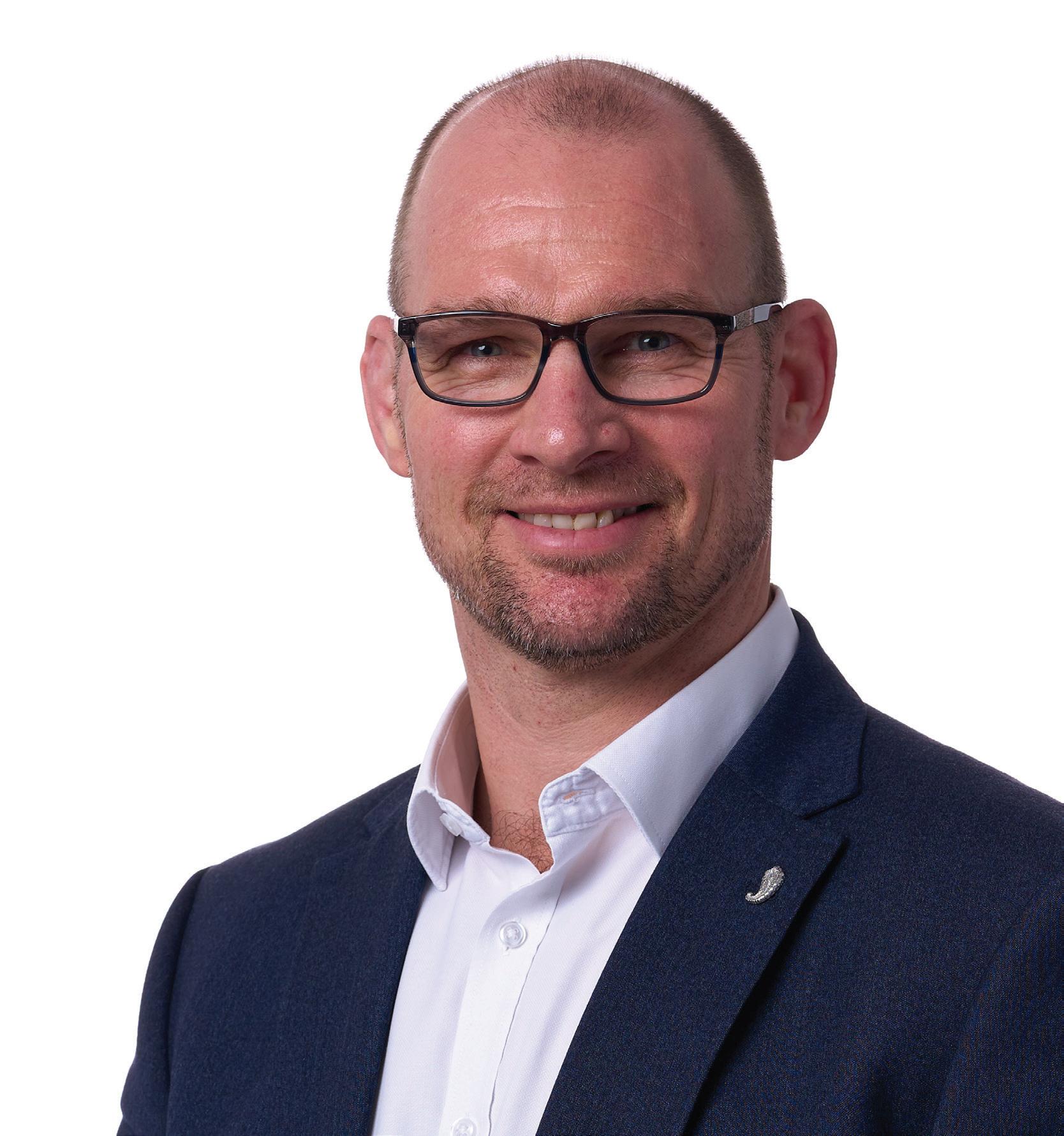
Paul Britton has been Chief Executive of Thames Valley Chamber for eight years, and before that he led on inward investment into the region.
Over the years he’s seen various regional government support organisations come and go.
So would the Thames Valley benefit from having a pan-regional partnership, such as in other areas of the country?
“What could it do that we aren’t already doing?” he asks.
“The Chamber isn’t a government creation. We are independent and can praise or challenge when our members think that things need to change for their businesses to thrive and grow.”
It certainly has the authority. The Thames Valley Chamber (which covers Berkshire, Buckinghamshire, Oxfordshire and Swindon) has more than 3,000 members and international trade customers. They include major global companies which have set up
their UK or European headquarters in the region, to SMEs which are the backbone of the UK economy.
“Our members like working as a collective,” says Paul.
“We look at the risk register for the region and the business community,” said Paul. “We ask members what they see as the greatest threats to their businesses – internal and external – and that sets the scene for how we can help.”
What are the Thames Valley’s biggest challenges? “Creating stability so companies of all sizes have the confidence to plan and invest for the longer term,” said Paul.
“Also attracting and retaining talent in key sectors where the Thames Valley is particularly strong – such as life sciences and healthcare, technology and software development.”
Paul cites the Thames Valley Chamber’s Local Skills Improvement Plan (LSIP), published last year, as an example of close collaborative working with businesses irrespective of whether they are members. The plan will contribute directly to local curriculum and workforce development planning.
The LSIP came about after chambers across the country were invited by the Department for Education to produce local skills improvement plans.
Another skills plan? Haven’t they been written many times before? Yes, but the difference this time is that it puts employers at the centre of future skills planning, rather than universities and colleges of higher education.
“The report will form part of a wider transformation in skills and training provision,” said Paul.
“The most exciting part of the work we did on the plan was the new connections we developed with the local business
community and local education providers. The chamber facilitated these new connections and found a common language to support the development of new, modular courses and curriculum to suit employers.”
Thames Valley Chamber doesn’t often take on such projects on behalf of the government, because the terms of reference are often tight.
“With the local skills improvement plan research, we made sure that everything we heard from participating members was logged. The information the government required was integrated into the plan, but we kept all the other frustrations and issues highlighted by our members around skills policy to help in our wider lobbying to government.
“Businesses recognise skills can’t just be a problem for the state, we need to play our part. Depending on which region you are in, there will be different skills gaps and issues. That’s where we, as a chamber, can offer real value if we help keep the energy and engagement of SMEs into the system.”
“Facilitating growth and investment is another priority area,” said Paul. “Promoting the region on the world stage is very important, because it raises overall confidence in the region.”
The Thames Valley is one of 53 chambers across the UK affiliated to the British Chambers of Commerce. Each one is independent and they vary in size and strength. It is fair to say that The Thames Valley Chamber is probably one of the strongest and most vocal on behalf of its members.
“We are the voice of our members, and we are also the voice of the local economy,” said Paul.
As the region hasn’t got a governmentbacked pan-regional partnership, or one in the planning, the Thames Valley Chamber is filling the vacuum.
“We continually engage with policy makers, particularly highlighting the value of our SMEs, and local exporters, and emphasising

that the issues they face should be given greater consideration as they are a fundamental part of the region’s supply chain,” added Paul.
“Our members are also encouraging us to look at more strategic issues for the region.
“We have all got a key part to play in creating a regional economy where companies and industry sectors can thrive and grow. This is a key reason for them moving or expanding here and becoming part of the chamber. They are willing get around the table, identify the issues, pick up on the actions and deliver on them.”
That’s the thing about local chambers of commerce. They have a direct relationship with their members who expect them to achieve successful outcomes.
But the Thames Valley Chamber doesn’t operate in a vacuum. “We discuss common challenges with chambers across the country, such as in Birmingham and Liverpool,” said Paul. “We are also working more closely with our region’s universities. These are anchor institutions and the closer we can work with them, the better.”
“Together with local civic leaders we can identify key issues and make the case for transformational projects and investment in transport (such as the proposed Western Rail link) and infrastructure across the region. To be successful we need the business community on board to fund and help co-develop them.”
The proposed Western Rail link is a major project which would reduce rail journey times between Reading and Heathrow by delivering a faste and more frequent direct train service.
This collaborative working has grown over the last few years, according to Paul. “We are here to listen to our members and lead on their priority issues. And most of those aren’t dissimilar to the priorities that the government has set out, but getting real world on-the-ground solutions is another matter.”
While the Thames Valley isn’t a pan-regional partnership, it is increasingly playing the role of one, but with the added benefit of the direct support of its members.
“We get out and about a lot. We know what the issues are,” said Paul.
“One of the things I’m most proud of during my tenure is that we have made enormous strides in terms of welcoming, influencing and challenging our MPs. We offer wellinformed comment and they recognise that. They know that when they hear from us it’s unfiltered and apolitical.
“The Thames Valley has got fundamental challenges to tackle that 10 years ago would have been dealt with by the civic purse.
“This year there will be a new government. Whatever colour it is we will work with it, alongside listening to the concerns of our members and the wider business community. This gives us the knowledge to have a constructive conversation and deliver on some of the required solutions.”
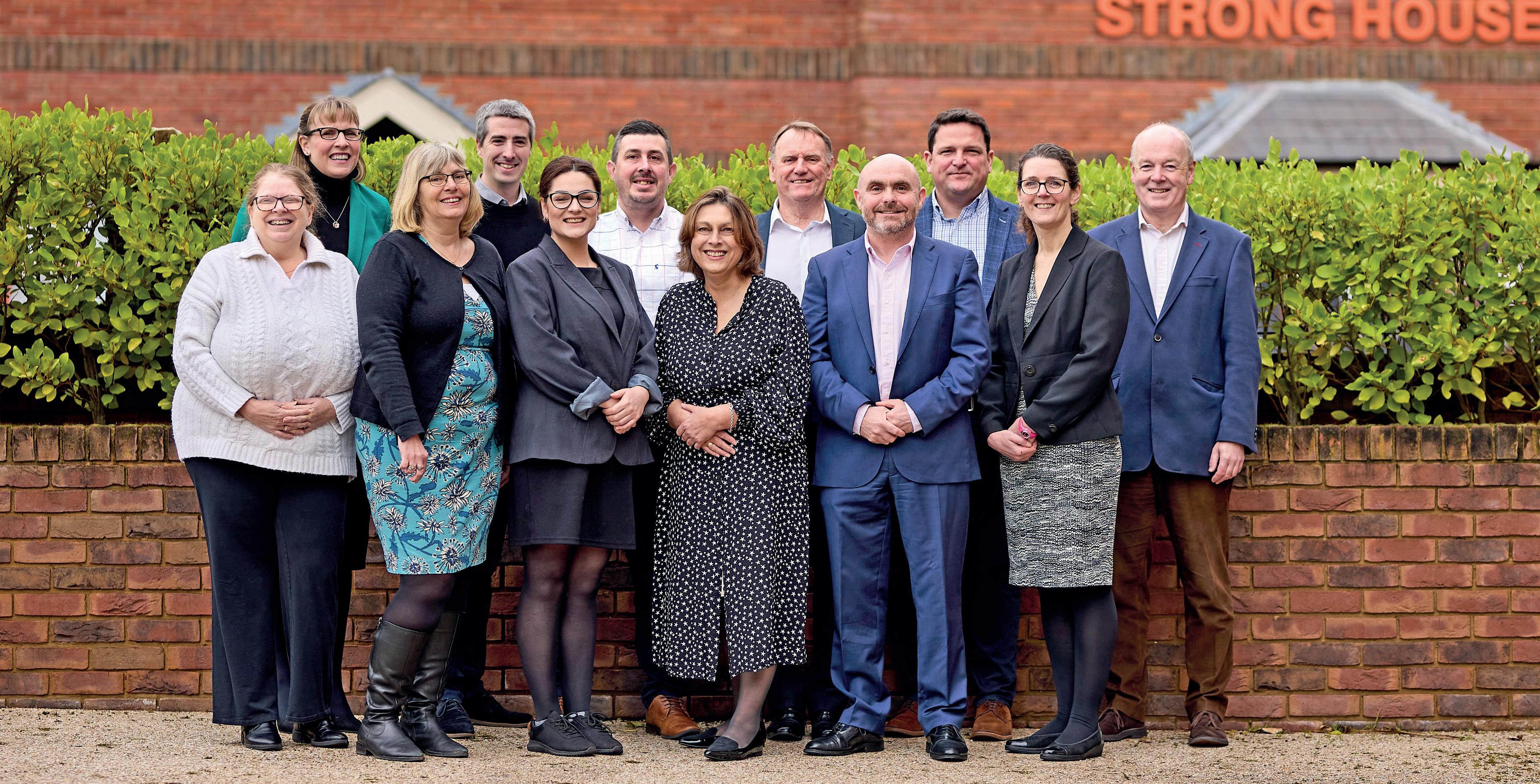
Two leading law firms with offices in Romsey are thrilled to announce their merger, reinforcing both firms’ presence in the legal landscape across the South. On 1st May 2024, Parker Bullen LLP, a highly respected legal practice who have made a real mark in Romsey since opening in 2021, merged with Kirklands Solicitors LLP, a well-established firm boasting an impeccable reputation with over 40 years in Romsey and Totton.
While Parker Bullen LLP have been a well-recognised organisation across Hampshire and Wiltshire for many decades, the firm quickly gained recognition for their exceptional legal services and commitment to client satisfaction following the opening of its Romsey office three years ago. Following a rapid expansion with an additional office in Witney launching just 18 months later, the firm has established itself as a trusted advisor for individuals, families, and businesses alike.
Since the launch of its Romsey office, the firm has been incredibly active in the local community, attending and sponsoring many initiatives including the Romsey Relay Marathon and the Romsey Mayor’s Picnic. With an enthusiasm to engage with and support the businesses, not only in the town
centre but the surrounding districts, the firm has been a proactive force in the Romsey & District Chamber of Commerce & Industry events and membership and is a proud sponsor of this year’s Test Valley Business Awards, specifically the Small Business of the Year Award.
The firm’s dedication also reaches their employees. In recent years, the firm has re-launched their extensive Employee Benefits, introduced a Charity of the Year initiative which is chosen by the employees, expanded the agile working policy, grown the Marketing and Human Resources functions, launched a new career progression platform to support employees through the firm, as well as hosting regular social events and activities to encourage engagement across the offices.
This merger brings together the collective expertise, experience and resources of two esteemed firms, creating a synergy that will benefit clients and the community ...
Kirklands Solicitors LLP boasts over four decades of experience in Romsey and Totton, earning a sterling reputation for its integrity, professionalism and dedication to delivering optimal outcomes for its clients. The merger with Parker Bullen marks a new chapter in Kirklands' storied history; one that promises to enhance the joint firm's capabilities and reach. During its time in the area, the Kirklands team has developed an enviable reputation for being friendly, approachable and professional, as well as working closely with the community in Romsey; all qualities similar to those of Parker Bullen.
This merger brings together the collective expertise, experience and resources of two esteemed firms, creating a synergy that will benefit clients and the community at large due to their commitment to excellence and client-focused values.
The current Kirklands offices at Strong House in Romsey and on Commercial Road in Totton will be known as Parker Bullen Incorporating Kirklands from 1st May 2024, with Parker Bullen retaining its current office on The Hundred in Romsey, in addition to its premises in Andover, Salisbury and Witney.
Gareth Horner, Managing Partner at Parker Bullen LLP, spoke of the merger: “As a firm we have grown significantly over the last few years; expanding from two offices at the beginning of 2021 to a firm of six offices and over 100 employees from May of this year. Our history and the reputation we built up in Andover and Salisbury served us well when opening our Romsey office in 2021 and our Witney office in 2022, and this merger with Kirklands will allow us a new exciting avenue into Totton and the wider New Forest area. Having met the Kirklands team on many occasions, we are convinced that their values align keenly with ours in relation to looking after our clients and colleagues to deliver the best legal services we can.”
Peter Slade, Managing Partner for Kirklands Solicitors LLP, commented: “We are excited to embark on this journey with Parker Bullen LLP and unite our strengths to deliver unparalleled legal advice to our clients. This merger represents a significant milestone for both firms, and we are confident that together we will continue to set new benchmarks in the legal industry. When making this important decision about which firm to collaborate with for the future of Kirklands, I was impressed with the culture of Parker Bullen and feel they align with our own ethos of unity as well as their support for one another, their clients and their surrounding communities.”

Parker Bullen Incorporating Kirklands will carry on offering legal services to individuals, families and businesses across the South with the current Partners and staff from Kirklands remaining to practise after the merger.
For commercial clients, the firm’s experienced lawyers understand the nuances of the legal environment as well as the intricacies of the corporate world. Their commitment to excellence combined with the proactivity required in such matters ensures that businesses receive the comprehensive legal support they deserve, while keeping their objectives at the centre of that advice. Whether you are a start-up business, an established company, or facing specific challenges, the Commercial departments can advise on a variety of legal queries concerning:
• Commercial Litigation
• Commercial Property
• Corporate & Commercial
• Employment Law.
For individuals and families facing potentially complex or emotionally charged
legal matters, the expert team can guide clients through every key stage of their life, offering personalised, compassionate and prompt assistance. Taking pride in their welcoming and open approach, the firm’s lawyers go above and beyond to ensure your unique needs are met in the following matters:
• Dispute Resolution
• Employment Law
• Family Law
• Moving Home
• Wills, Trusts and Estate Planning.
In addition to these areas, the firm boasts several consultants who specialise in Military Law, Criminal Law and Immigration Law.
Looking ahead, the leadership teams of both firms are committed to fostering a culture of teamwork, innovation, and continuous improvement. Through investment in technology, professional development, and client engagement initiatives, Parker Bullen Incorporating Kirklands aims to stay at the forefront of the legal industry and anticipate the evolving needs of their clients.
email info@parkerbullen.com or visit their website www.parkerbullen.com.

Ethical brand One Water used World Water Day in March to celebrate a £30 million fundraising milestone with its charity partner The One Foundation.
The Richmond-on-Thames brand and The One Foundation were founded by ethical entrepreneur Duncan Goose in 2004.
Since then the millions of pounds raised through the sales of bottled water, corporate partnerships and donations, has helped to change the lives of more than five million people around the globe.
“Having set out to change just one life, to have changed five million is an incredible milestone and would not have been possible had it not been for all our partners, customers and the wider public who’ve been buying One Water over the years,” said Duncan.
He launched the brand after experiencing Hurricane Mitch in Honduras in 1998 during a two-year round-the-world motorbike adventure.
Around the planet, there are still 703 million people who lack access to safe, clean drinking water, including 115 million who still collect untreated surface water from lakes, ponds, rivers and streams.
These people survive on as little as five litres for all their daily needs. The average person in the UK uses 152 litres of water per day.
One Water donates to The One Foundation on every sale made to fund its water programmes.
The Co-op have worked with The One Foundation for more than 15 years and donate three pence per litre from sales of Co-op branded water, which has significantly helped to reach the £30 million milestone.
The funds raised are invested across two key sectors in Rwanda, Ghana, Malawi and Kenya, where large scale urban water systems are being implemented and handpumps repaired in rural communities.
The One Foundation aims to fund selfsustaining water solutions, so everyone has access to clean, safe water.
Duncan added: The Co-op has particularly been such a significant part of our journey and given so much over the years, as well as Starbucks and World Duty Free and all the other partners who share our vision for a fairer world.
“My hope is that One Water is recognised for all it has done and becomes a truly global brand for change.”
One Water is currently available in Co-op stores, Holland & Barrett, NISA, Starbucks, Whole Foods Market, World Duty Free, other leading hospitality and convenience outlets and major wholesalers including Bidfood and Brakes.

Reading Football Club has confirmed that its owner, Dai Yongge, has committed to a letter of intent with a potential purchaser of the club.
The parties entered a period of exclusive negotiation to agree the final terms. The completion is expected to take up to two months, at which time the purchaser will be announced, expected at the end of May.
The transaction would include the transfer of Mr Dai’s shareholding in Reading Football Club, as well as the Select Car Leasing Stadium and Bearwood Park training ground.
The news offers a light at the end of what has been a long and protracted tunnel, with the club suffering 18 points deducted under the seven-year tenure of Dai Yongge for failure to pay staff and HMRC, with a further two points currently suspended.
Last year, Reading was relegated to League One, the third flight of English football, for the first time in 20 years, and the club was forced to part ways with a number of key staff.
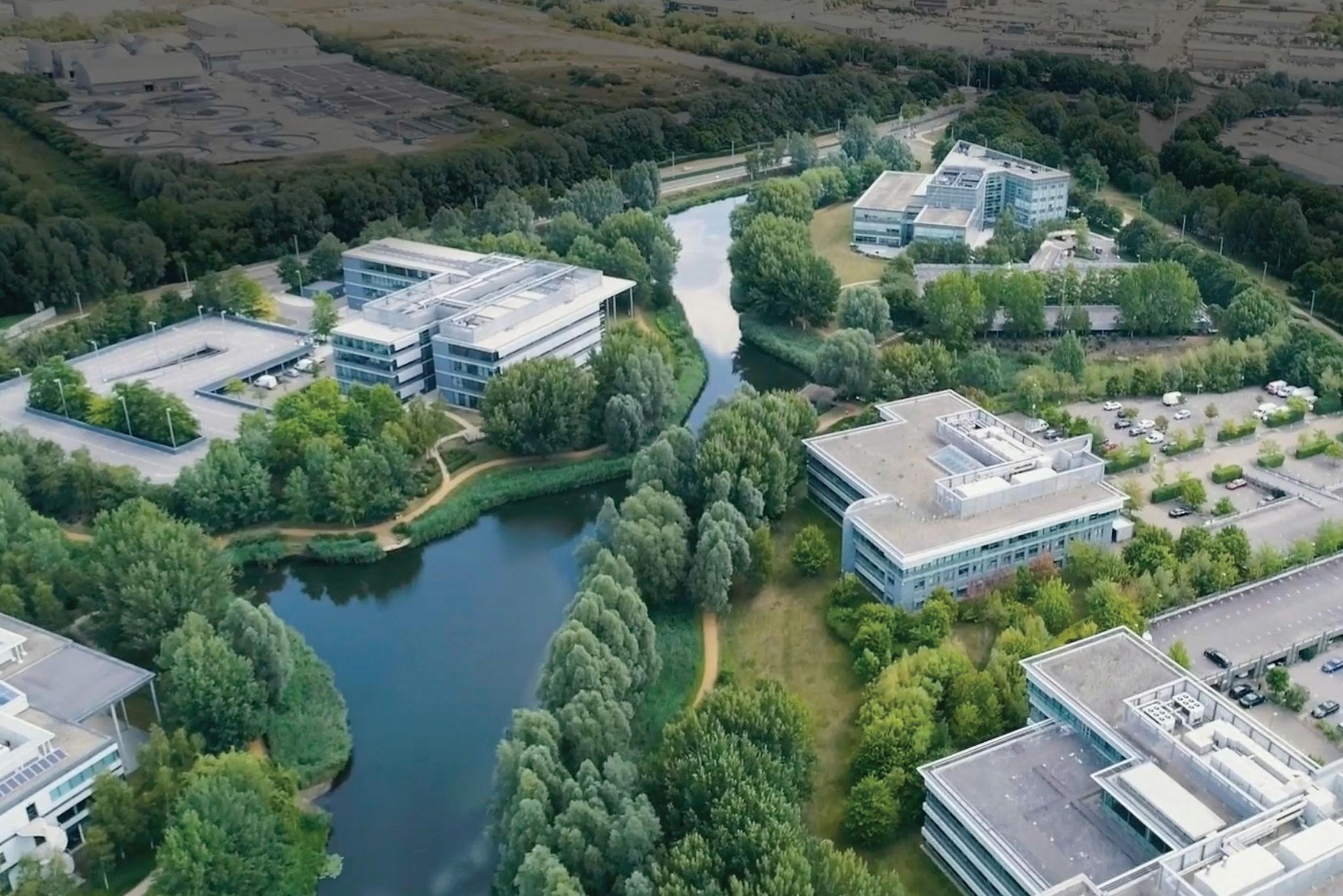
Vacancy rates for office space in Berkshire and north Hampshire are at a 20-year high, despite there being a recent spate of big deals in the prime end of the market.
The data comes from CoStar, the commercial real estate data giant, which showed that the vacancy rate in the two south east areas stood at 12.8 per cent as of late March.
That is up from below eight per cent when the coronavirus pandemic struck and nearly 500 basis points above the national office average. CoStar said this was likely to rise further in the next couple of years amid continued subdued demand.
That said, Stanley Black & Decker committed in November to 30,000 sq ft at the Tempo building in Maidenhead, while earlier this year Johnson & Johnson leased 97,000 sq ft at the same building.
In December, global engineering company Wood leased 117,000 sq ft at Green Park, Reading, in what was the south east’s biggest office letting for two years.
But CoStar noted: “Rising momentum at the prime end comes as the overall
market struggles. Firms continue to release space on to the market or consolidate into smaller spaces amid the pivot to hybrid working and stagnant economic growth.
“A high-profile example saw Chinese telecoms giant Huawei exit its 140,000 sq ft office at Green Park for just 35,000 sq ft at nearby Thames Valley Park,” it added.
“High vacancy and interest rates have deterred investment and caused prices to fall.
“Last year was the weakest year for office investment in Berkshire and north Hampshire for 11 years and it remains quiet in 2024, with only a handful of transactions over £10 million since the beginning of 2023,” CoStar also noted.
As an example of the fall in prices, last December Aprirose bought the Pearce building in Maidenhead for £13.5 million, with the price reflecting a lofty 9.7 per cent yield.
But seller M&G Real Estate acquired the 51,000 sq ft building two years earlier for £26 million, a 6.9 per cent yield and nearly double the recent sale price, noted CoStar.
Jakes Indoor Playworld, which trades as Jakes Indoor Soft Play and Mini Farm, has been sold for an undisclosed sum.
The Sandhurst venue is now owned by Yarmouth-based Adventure Farms Limited – a new company founded by Bean Chapman and Tom HoneymanBrown, owners of Chobham Adventure Farm in Surrey and Tapnell Farm on the Isle of Wight.
Jakes has been family owned and operated for the last 14 years, during which time the vendors invested in the site to develop the successful business operating today.
The site comprises an activity centre with indoor soft play facilities and mini farm, as well as outdoor adventure park.
With the vendors now looking to retire, they sought a sale with legal representation from Cheltenhambased Hughes Paddison Solicitors. The buyers were represented by Cradley Heath firm George Green LLP.
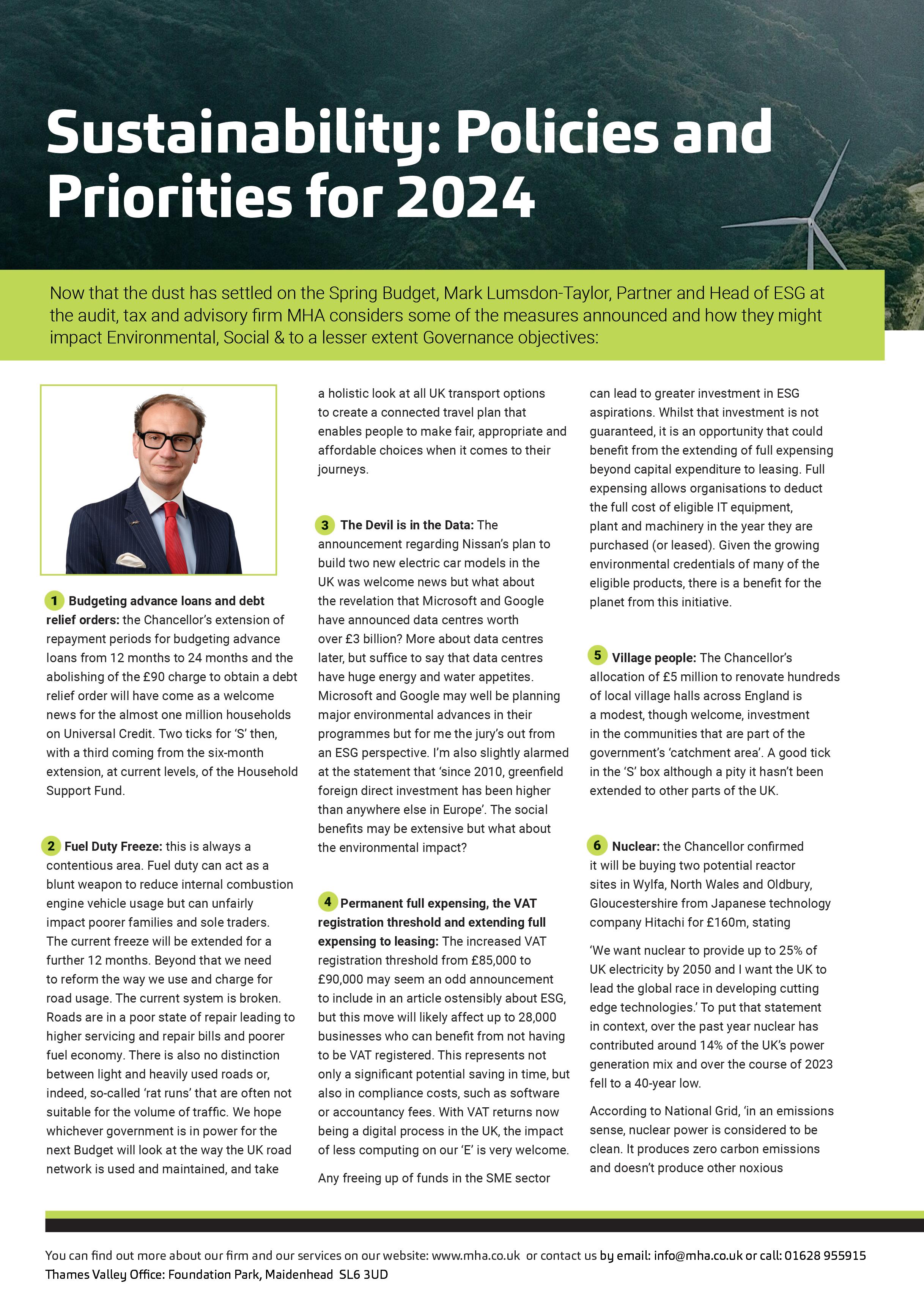
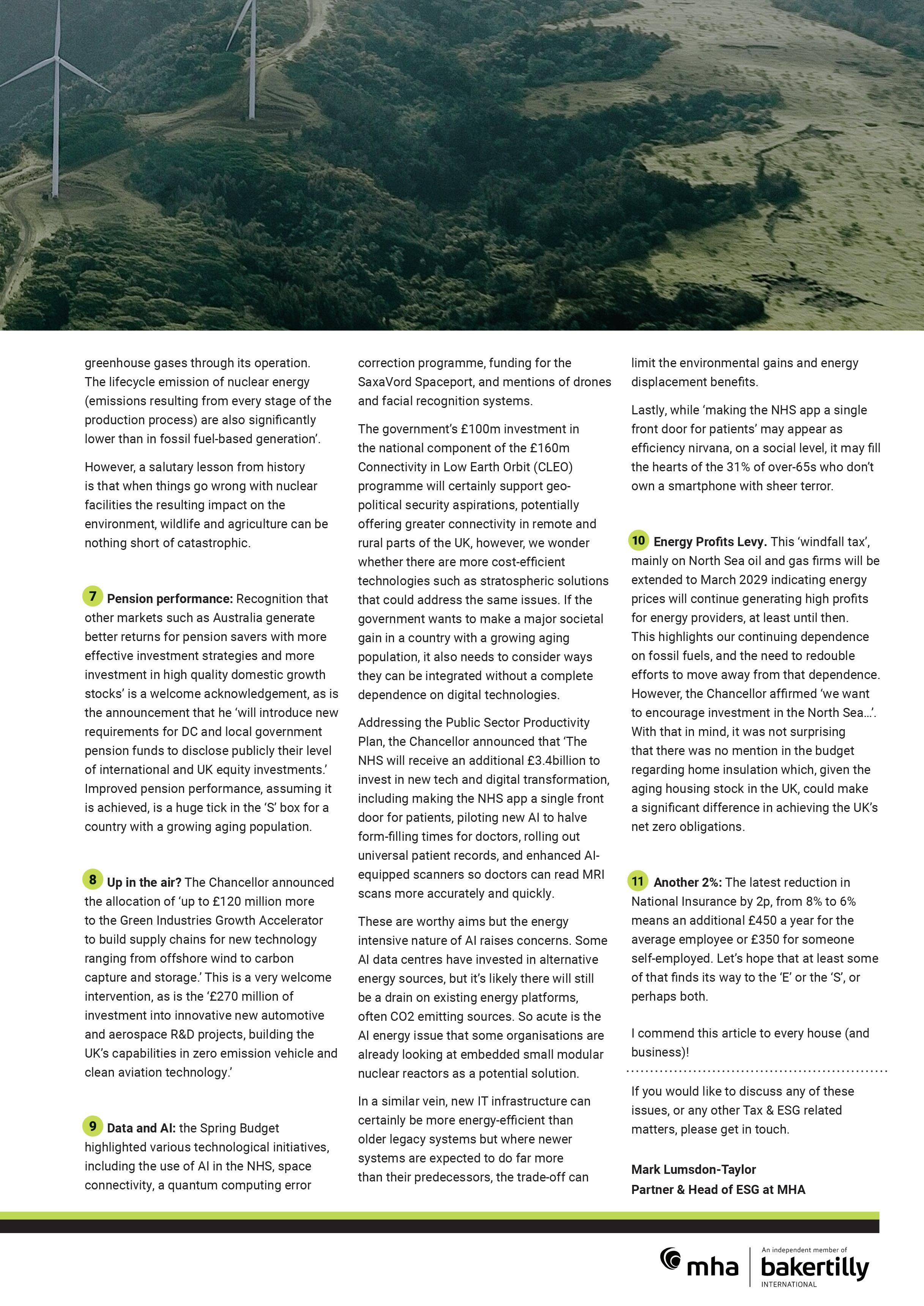
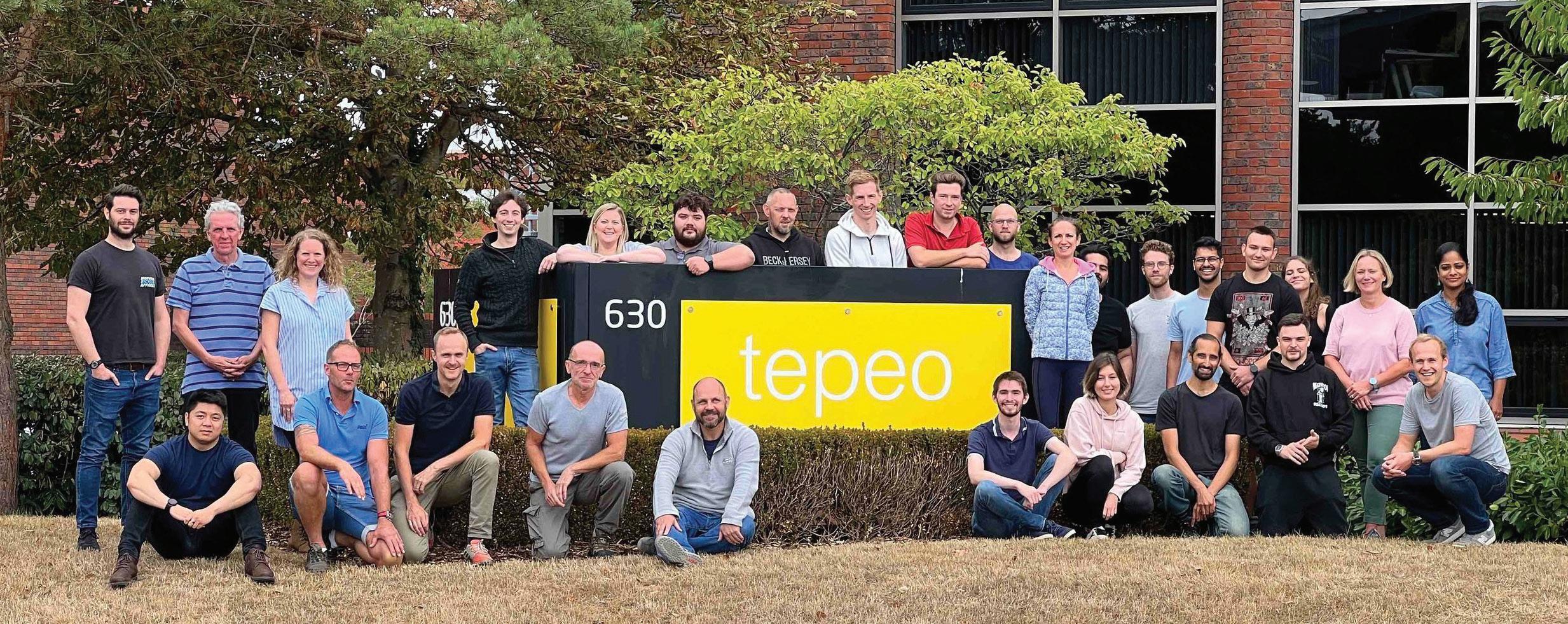
Tepeo has opened a new facility in Wokingham which will allow it to triple manufacturing capacity of its ZEB, a direct replacement for fossil fuel burning boilers, drive research and development.
Lord Callanan, minister for energy efficiency and green finance, attended the official opening ceremony.
The facility is set to provide a new home for tepeo’s growing team, which has doubled in size over the past year, and will enable the firm to produce many more of its zero emission boilers (ZEBs).
There’s also space for research and development, where engineers will work on designing more advanced and
accessible ways to decarbonise the UK’s domestic heating as oil and gas boilers are phased out.
Johan du Plessis, founder and CEO of tepeo, said: “Our mission is to become leaders in low-carbon heating solutions.
“We need to increase our manufacturing capacity to build more of our smart heat batteries to achieve this.
“The expansion is not just a success story for the company, but a promising development for British manufacturing.
“Opening our new facility reflects the increasing demand for low-carbon home heating technology.
“It’s a tangible sign of what the future will hold for tepeo and how we think about home heating.”
Lord Callanan added: “The UK is a world leader in decarbonising, becoming the first major economy to halve its emissions between 1990 and 2022.
“Reducing carbon emissions from our homes is key to helping us push further and support families towards net zero.
“It gives me great pride to see British manufactured technology, like tepeo’s heat batteries, contributing to our mission and giving consumers a greater choice in switching from fossil fuels to cleaner, greener heating.”
Medical equipment manufacturer Occuity has been awarded a government-funded Small Business Research Initiative research contract to support development of a non-invasive screening device for Alzheimer’s disease.
The Amyloid Beta Plus (Aβ+) Reader will help to identify the presence in the brain of Aβ+ plaques, which have been targeted in recent therapeutic breakthroughs to slow the progression of Alzheimer’s.
More than 50 million people around the world currently live with dementia – a number expected to triple by 2050 according to the World Health Organisation – and Alzheimer’s is the leading cause.
“Alzheimer’s disease poses one of the most daunting health challenges of our era”, said Dr Dan Daly, CEO of Readingbased Occuity.
“Current diagnostic methods are inadequate, being either non-specific, expensive, or invasive, and there is no effective screening programme.
“Our work embodies our mission to revolutionise healthcare technology with accessible, non-invasive, optical solutions.
“This SBRI contract provides important funding that will enable us to move towards our goal of delivering a painless, rapid screening method which integrates seamlessly into routine eye exams, thus enabling earlier intervention.”
Occuity’s Aβ+ Reader will use patented technology to scan the eye’s lens for specific biomarkers indicative of Alzheimer’s disease, providing a swift and painless assessment tool.
Dr Alistair Bounds, senior research scientist and project lead at Occuity, said: “This is a very exciting project, combining state-of-the-art photonics technologies, advanced biomarkers, and Occuity’s deep expertise in optical and ophthalmic measurements to target the most prevalent form of dementia.
“It sits perfectly between Occuity’s existing diabetes screening work and our longer-term FLF project, bringing together highly skilled scientists and engineers from both of these projects.”
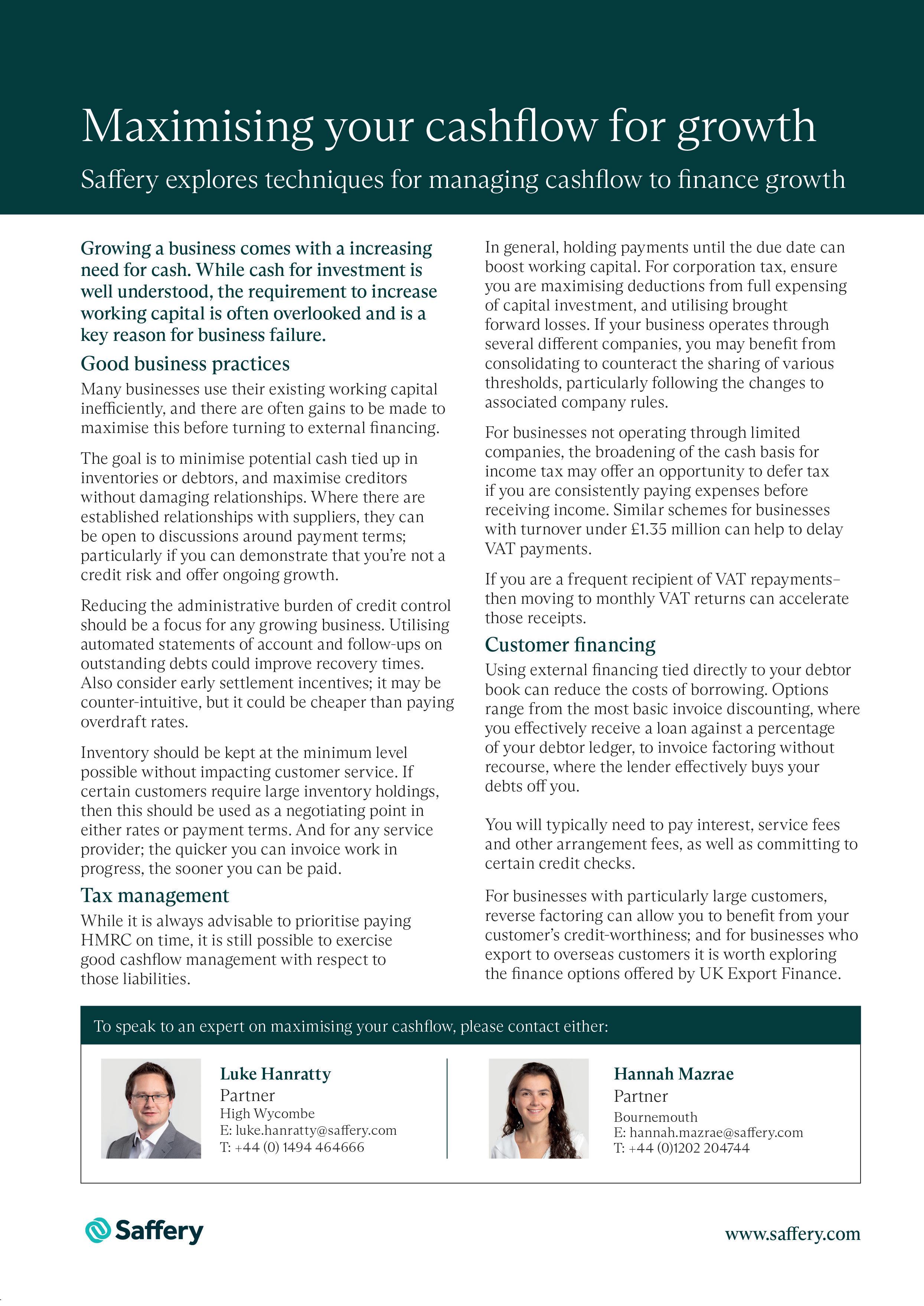


The Business Magazine marked the launch of the 2024 Solent 250 with a special drinks reception. The Ranking celebrates the top privately-owned companies in the Solent region.
Jo Whittle, Operations Director at The Business Magazine, welcomed invited guests and sponsors and thanked them for their engagement and support of the programme.
Held at Ordnance Survey, no 19 on the Solent 250, CEO Nick Bolton gave an insightful keynote on the company’s history and the challenges involved in leading a business so steeped in history into modern times. Effectively adopting new technologies and tailoring them to ensure Ordnance Survey’s continued relevance.
The Solent 250 is compiled by The Business Magazine and sponsored by HSBC UK, specialist recruiter CMA Recruitment Group, property experts Vail Williams, law firm BDB Pitmans, wealth, accountancy & advisory firm Evelyn Partners and the University of Southampton Business School
All companies on the Ranking are now invited to put themselves forward for one of six awards.
If your company is on the Ranking and you would like to selfnominate, or for more information please contact Jo Whittle. Jo.whittle@thebusinessmagazine.co.uk





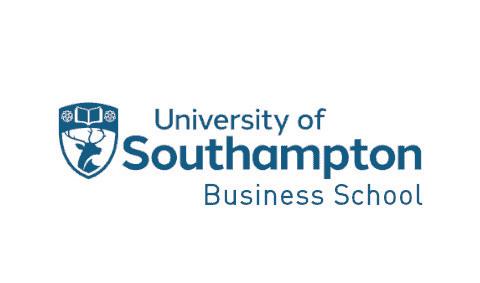
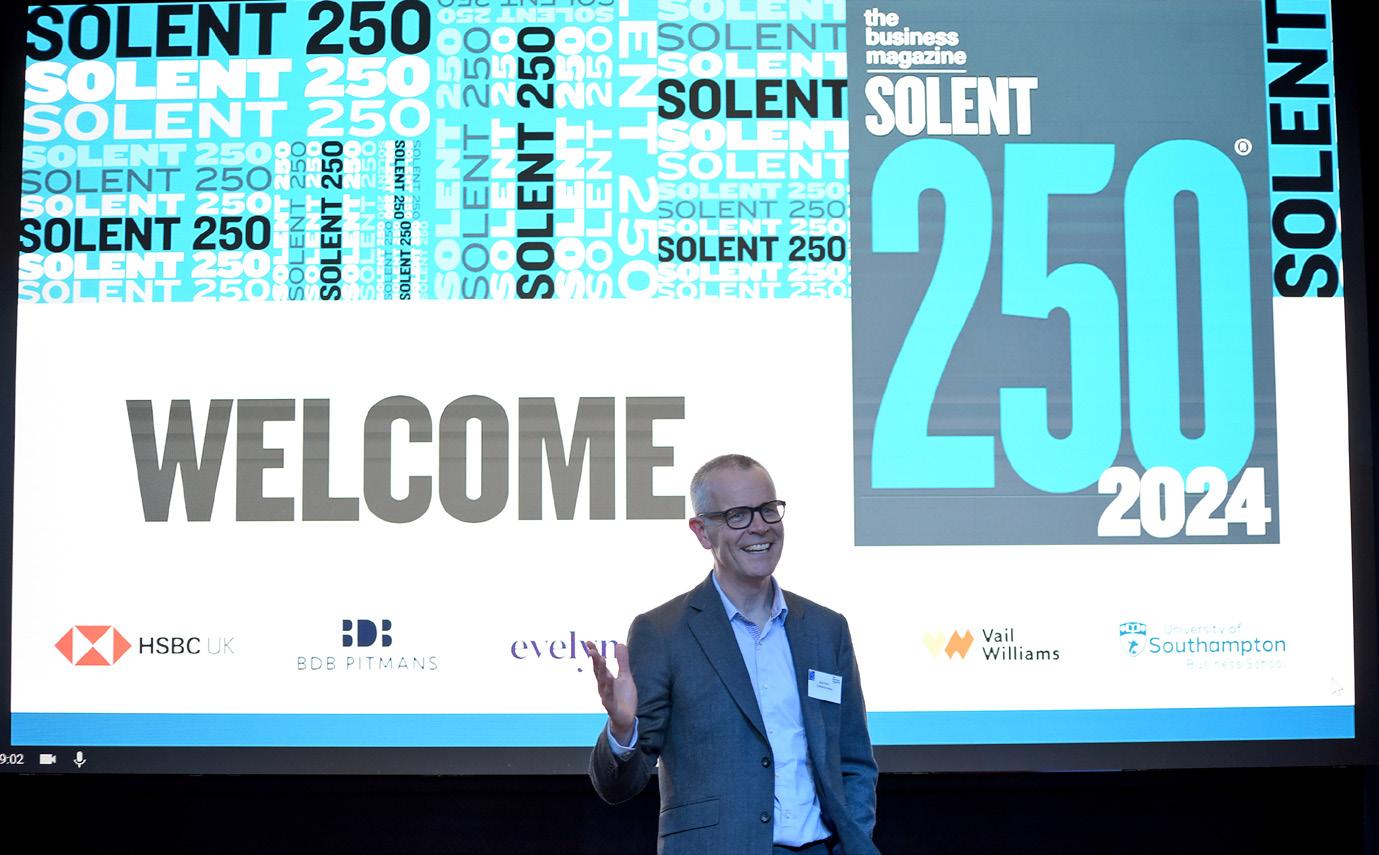


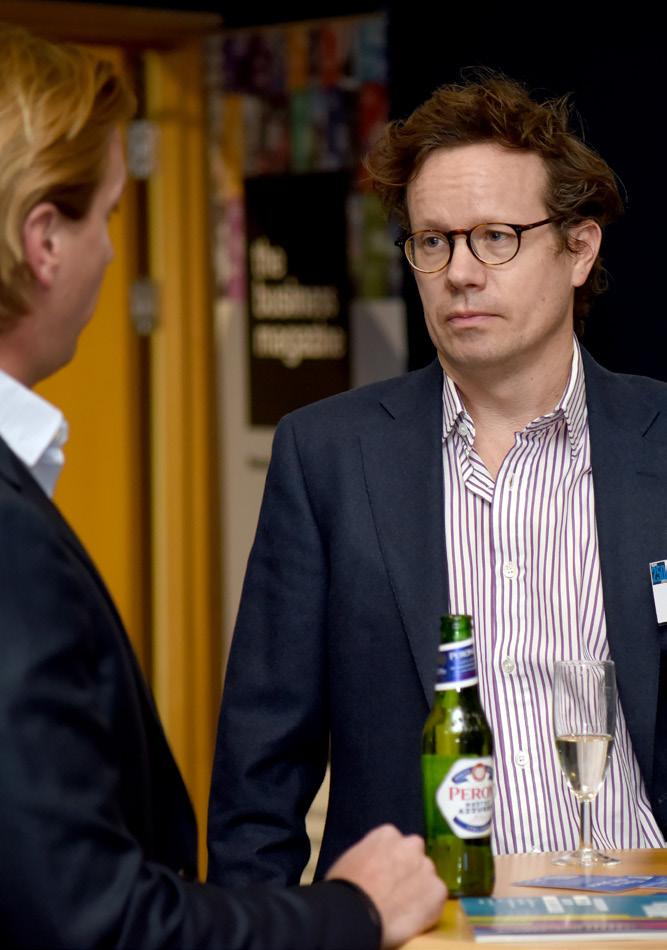
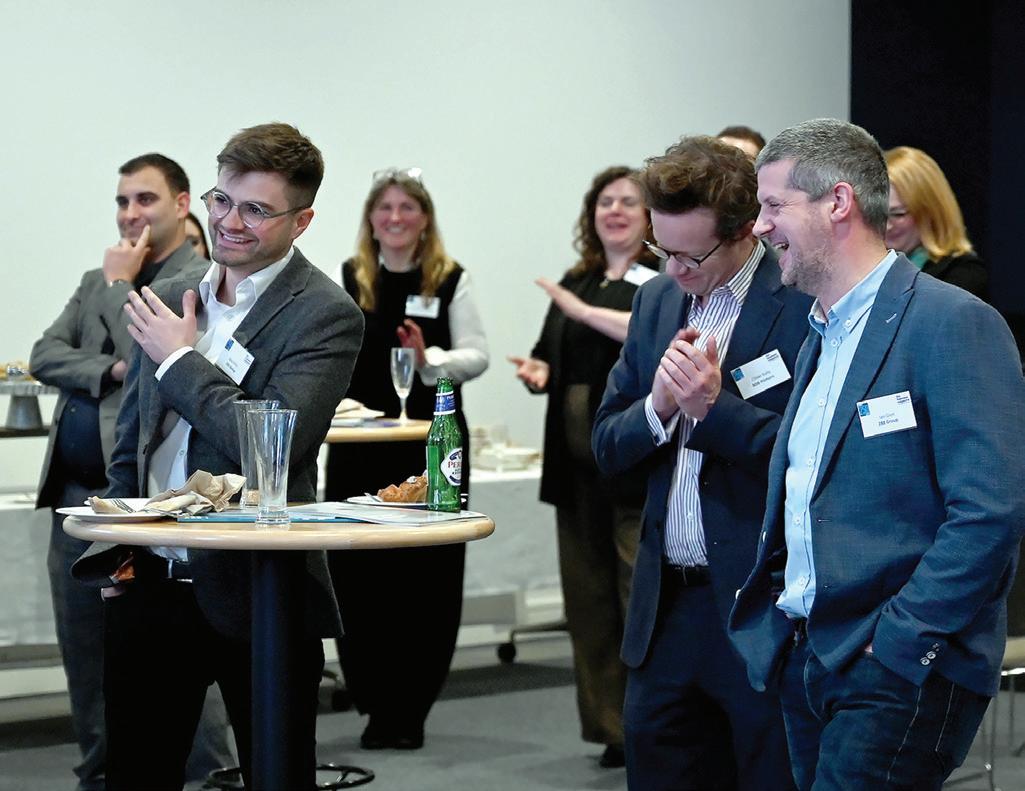




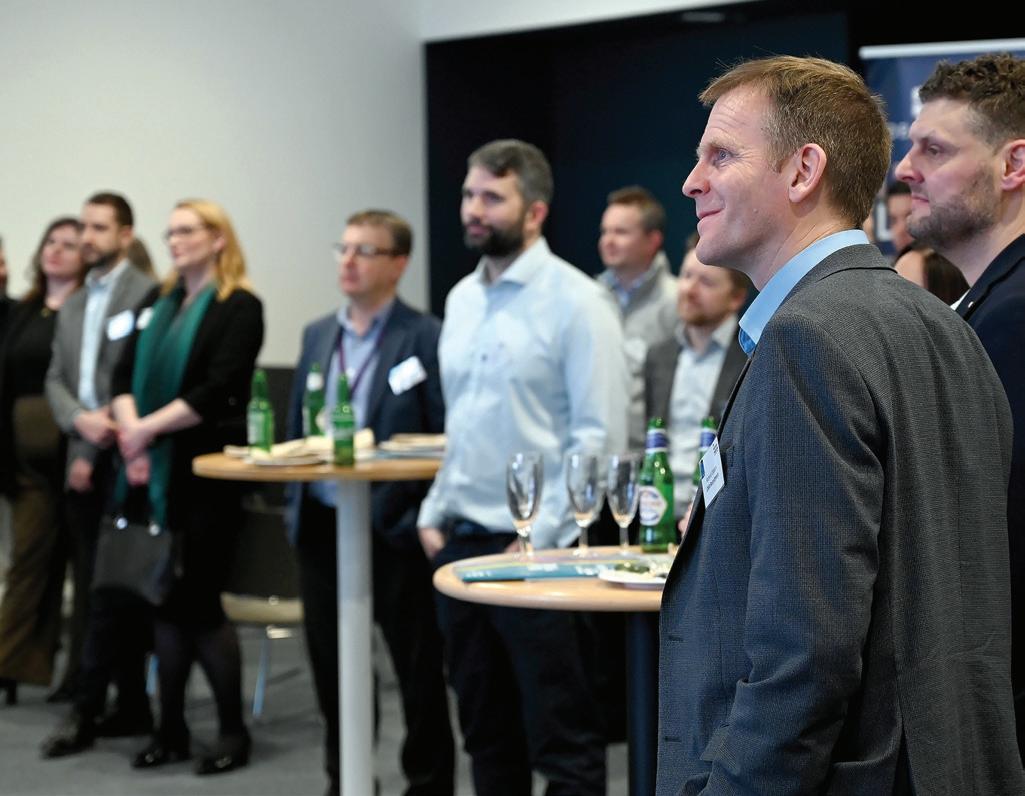



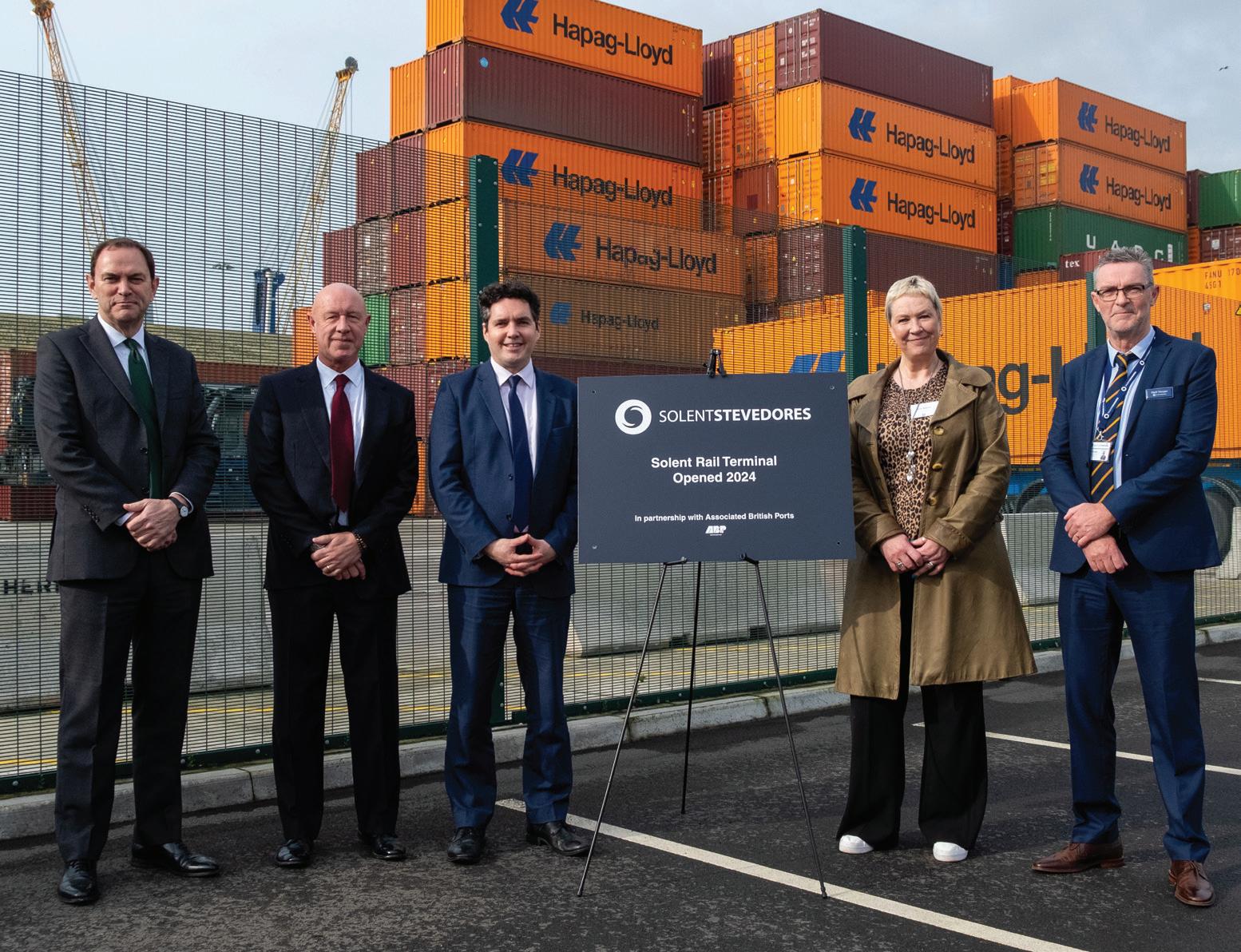
The new Solent Rail Terminal has been officially opened by Minister for Rail and HS2, Huw Merriman.
The minister visited the Port of Southampton and met representatives from Associated British Ports (ABP) and Solent Stevedores, whose joint £17.5 million investment aims to cement the city as the UK’s leading gateway for deep-sea trade.
The 18-acre facility can handle laden and empty containers, plus storage, maintenance and repair, all within a singlesite boundary – a first for the port.
The larger site includes a new track layout to allow for simultaneous train arrival and departures, boosting the terminal’s efficiency and extending the rail loading pad by 130 metres.
Overall, it should be able to accommodate a 71 per cent increase in daily services and handle 125 per cent more containers.
Alastair Welch, regional director of ABP Southampton, said: “This project is a great example of expanding container handling, increasing rail use, reducing reliance on
HGVs and offering new services within the port boundary.
“We’re proud of our continued partnership with Solent Stevedores, supporting their journey to reduce carbon emissions within their operations and across the wider port.”
Stuart Cullen, executive chairman of Solent Stevedores, added: “The completion of this project marks a major shift for intermodal transport at the Port of Southampton.
“This is the latest project in our long-term investment programme and it’s greatly expanded our offering for container management at the port.
“Along with generating a significant increase in our efficiency at the rail terminal, it goes a long way to supporting the government’s targets of reaching net zero by 2050.”
Rail minister Huw Merriman said: “The opening of the Solent Rail Terminal demonstrates the strength of the industry and its ambitions to grow, and I’m pleased that this multi-million pound upgrade will provide the increased capacity to allow the Port of Southampton to thrive.”
A partnership between Dorsetbased C3IA solutions and Birmingham’s Black Space Technology has developed a lifesaving initiative.
The two companies have developed a system which shares the health and medical information of a casualty on the battlefield or in a disaster zone instantly with experts able to give rapid advice.
Patients are fitted with sensors which constantly transmit information, while Silvus StreamCaster radios allow those on the ground to video call medical professionals with little interference.
Ash Williams from C3IA said: “This collaboration is about saving lives.
“The Silvus radios are the best there are and enable communications in places where there is no other way of keeping in touch.
“They’re robust and powerful and create their own network on the ground. They also enable Black Space Technology’s software to be used to send and receive vital information.”
David Morgan, CEO and Medical Director of Black Space Technology, explained how the first hour after injury is known as the ‘golden hour’, when 80 per cent of deaths occur.
“Speed of reaction and care therefore is absolutely crucial,” he explained.
“Through the Silvus radios and utilising Bluetooth and other technology, our software can make all the difference.”
Rail minister Huw Merriman (third from left) joined ABP Southampton and Solent Stevedores at the Port of Southampton
Colleagues at Silverlake Automotive Recycling in Hampshire have completed an electric vehicle dismantling course as the garage continues to process growing numbers of such vehicles.
Last year Silverlake dealt with 172 per cent more high voltage vehicles than in 2022, including a 94 per cent increase in fully electric and 218 per cent increase in hybrid vehicles.
The business has been proactive in equipping its staff with the skills needed to keep up with the EV revolution – including
the NA International EV dismantling course.
Participants on the course learned how to make vehicles safe before removing high voltage components and batteries, earning an Institute of the Motor Industry certificate on completion.
Tom Harvey, organisation development manager at Silverlake, said: “The automotive industry is evolving and we’re investing in our people and our facilities to serve our customers, futureproof our business and embrace the opportunities presented.
The University of Southampton is to be home to two new multi-million pound research centres, which will train the students needed for Britain’s quantum technology and defence sectors.
Around £32 million has been given to the university for the centres. They are among 65 announced by UK Research and Innovation (UKRI) to train 4,000 PhD students across the next decade.
The £18 million centre, funded by the government’s Engineering and Physical Sciences Research Council,
is for doctoral training in Quantum Technology Engineering.
It will also receive funding from tech businesses including Microsoft, QinetiQ, Riverlane and Oxford Ionics.
Meanwhile, the £12.5 million Centre for Complex Integrated Systems for Defence and Security will train the next generation of leaders and experts needed to support UK safety and resilience. It will receive funding from EPSRC, the Ministry of Defence and numerous industry partners.
Kier Construction Southern has started work on a new four storey extension and wider refurbishment works at Bournemouth and Poole College.
The college is carrying out work on its Bournemouth Campus following a multi-million-pound investment from the Government’s Further Education Capital Transformation Fund.
New facilities will contain teaching space tailored for courses in media, digital, business, travel, hair, beauty, hospitality, catering and sport.
It will also feature new community amenities including a restaurant and salons.
The historic landmark Clock Tower Building will go under wraps for 18 months for a full heritage restoration.
Phil Sayles, Principal of Bournemouth and Poole College, said: “The work will future-proof the buildings on our Bournemouth Campus until the end of the century, and represents a huge vote of confidence in Bournemouth.”
Cheryl Parsons, Regional Director at Kier Construction Southern, said: “We are working closely with Bournemouth and Poole College to deliver a first-class teaching space in the heart of town that will enrich the learning experience of students for generations to come.”
The construction is due to be completed by 2026.

One of Bournemouth’s best-known retailers has been made watertight for the first time in more than 50 years thanks to a £5.6 million investment.
The store first opened in May 1915. It became Debenhams in 1972 but closed when the national department store chain collapsed spectacularly in 2021.
In 2019 the building was bought by Verve Properties, which is now aiming to create a regionally significant destination centred on beauty, health, retail, food and beverage, culture, workspace
and community events. Verve focuses on developing brownfield sites and regenerating existing buildings.
Finally, after two and a half years of constant renovations and building works, the Bobby’s building is watertight.
Lewis Rogers, Site Manager at Wimbornebased Spetisbury Construction, which is carrying out the work, said: “Making the building watertight has been one of our biggest challenges, it hasn’t been dry for decades. As well as reroofing the entire building, we’ve also been working hard
to protect the tenants already in situ, this is one of the major challenges of working on an open building.
“We had more than 50 buckets up on the fourth floor to catch leaks, and during the worst storms, we were going in throughout the night to empty buckets to minimise disruption to those below.”
Verve’s decision to take the project on came about due to a belief in the potential for UK high streets to reinvent themselves after the economic downturn of the past 10 years.
Government ministers, industry stakeholders and Hampshire MPs have launched a landmark report at Westminster.
Commissioned by The Solent Cluster, the report reveals that the Solent could be a catalyst for sustainable growth.
Energy Efficiency Minister, Lord Callanan, said: “We need to cut emissions to get to net zero and carbon capture will play an important role in this mission. That’s why we’re backing it with investment of £20 billion. And with the UK’s infrastructure,
skills and geology, we are in a prime position to become world leaders in this pioneering technology. I welcome this report which shows the potential to unlock major investment in the carbon capture industry and create thousands of new jobs in the region.”
Anne-Marie Mountifield, Chair of The Solent Cluster, said: “The Solent has a unique potential to accelerate net zero ambition by transforming energy production and consumption. Our anchor projects could not only strengthen energy resilience but also create a low carbon
economy, boost economic growth, and contribute to the expansion of the regional employment market.”
The Solent Cluster comprises public and private organisations collaborating on the decarbonisation of the Solent region.
Members include international energy producers with expertise in carbon capture and storage and hydrogen technology along with global manufacturers and engineering companies, academic institutions and regional businesses.


As organisations grapple with evolving threats, understanding human behaviour, and fostering a security-conscious workforce are critical imperatives in ensuring robust cybersecurity within your business.
Social Engineering: The Art of Deception
Social engineering is a sophisticated psychological technique that manipulates individuals to obtain sensitive information, such as personal credentials or financial data. It is a cyberattack that exploits human behaviour and vulnerabilities, rather than technical weaknesses, to achieve its objective. Some typical social engineering techniques are listed below:
Phishing: Cybercriminals impersonate trusted email sources and trick people into sharing confidential information or clicking on malicious links. For instance, an employee may unwittingly reveal login credentials by responding to an urgent-looking email.
Pretexting: Perpetrators create elaborate scenarios to extract information in pretexting attacks. Imagine an attacker posing as an IT support technician, convincing an employee to reveal system details or reset passwords.
Tailgating: This physical social engineering tactic involves an unauthorised person following an employee into a secure area. A friendly request like “Hold the door, please” can lead to unauthorised access.

Security Awareness Training: A Vital
Investing in security awareness training pays dividends. Here’s how organisations can foster a security-conscious culture:
Regular Training Sessions: Conduct interactive sessions on phishing awareness, password hygiene, and safe browsing. Employees should recognise red flags and report suspicious incidents promptly.
Simulated Attacks: Regularly simulate phishing attacks to gauge employees’ responses. Provide immediate feedback and reinforce good practices.
Tailored Content: Customise training materials to address industry-specific risks. For instance, financial institutions may focus on protecting customer data, while healthcare organisations emphasise patient privacy.
Leadership buy-in is an excellent way to encourage staff to endorse cybersecurity and become a security conscious workforce.
Board Commitment: Boards must prioritise cybersecurity. Allocate resources for training, technology, and incident response.
Lead by Example: Executives should champion security practices. When leaders prioritise security, employees follow suit.
Once employees are onboard and training has been introduced, it is vital that on-going security is adhered to.
Clear Policies: Communicate security policies. Employees should understand their responsibilities and the consequences of non-compliance.
Reward Vigilance: Acknowledge employees who report incidents or demonstrate security awareness.
In cybersecurity, the human element can be the weakest link. However, it can also act as the most robust defence mechanism. By instilling a security-conscious mindset among employees, organisations can mitigate risks, safeguard sensitive data, and strengthen their digital resilience. It is crucial to understand that cybersecurity is not limited to the IT department alone – it is the responsibility of every individual in the organisation to remain alert and follow best practices to ensure a secure digital environment.

Dominique Tillen’s move online during lockdown saw sales at child toothbrush retailer Brush-Baby shine
By Stephen Emerson, managing editorWe had to pivot very quickly and brought in an Amazon expert who has produced some amazing results for us

The pandemic was make or break for many south east firms, with markets and distribution channels closing overnight once the country entered the first pandemic lockdown.
When the dust settled, however, many made successful and lasting changes in the way that they sold their products and Dominique Tillen of Hampshire-based Brush-Baby was one such business.
The company’s growth had followed a steady growth trajectory, hitting the £1 million turnover milestone in 2017, however it was a pivot made during Covid that accelerated Brush-Baby’s growth.
The firm, founded in 2007, now has a turnover of £4 million a year and employs 15 people in the market town of Alresford near Winchester.
Dominique said: “Between 2020 and 2021 we grew by 43 per cent and that was during Covid when we switched the business to online.
“We heavily focused on Amazon as our retailers had all shut down.
“We had to pivot very quickly and brought in an Amazon expert who has produced some amazing results for us.”
Dominique trained as a nurse before
working as a midwife at Great Ormond Street Hospital before moving into clinical research.
It was this experience, and struggling to find a toothbrush that would work for her daughter, that gave Dominique the idea of starting Brush-Baby.
She said: “My daughter would always chew her toothbrush and I knew if you started a business which would be useful to lots of people then it could be a success. We started out with one little chewable toothbrush.”
In the early months and years, Dominique found herself, as many founders do, wearing sales, marketing and operations hats.
She said: “I would sit by myself at the kitchen table and divide the business into different functions.
“One day I’d be wearing my sales hat, another I’d have on my marketing or finance and operations hat.”
Dominique says one of the reasons behind Brush-Baby’s growth is her early adoption of exporting.
The bulk of exports go to Eastern Europe
and the Nordics, with the company also having a foothold in the United Arab Emirates.
Dominique says that she learned quickly that frequently visiting the country to which you are exporting is vital to success.
She said: “It’s very important that you travel and meet people and go around the shops to see how your product’s displayed.
“You can do so much online, but you really need to get out there and see what’s happening on the ground.”
Many UK businesses face language and cultural barriers when it comes to exporting, however, these obstacles haven’t hindered the growth of BrushBaby.
Dominique said: “Children tend to like the same sort of things and mothers have the same issues when it comes to looking after their teeth.”
However, there are some important cultural preferences that have to be respected.
“We can’t sell yellow toothbrushes in Arabia, because they don’t like the colour. We also have a little hippo toothbrush which they won’t accept because it looks like a pig.

Dominique’s other business is a vineyard on the outskirts of Offington in West Sussex.
English wine has enjoyed a revival over the past decade, particularly in the south east where increased temperatures have led to rich harvests for growers large and small.
Dominique has collected her first harvest which is now in the hands of a Hampshire winery where it will be ready for consumption in 2026.
For Dominique though, the vineyard, while a commercial concern, is about escaping the stress and strains of the day job.
She said: “It’s very much my sideline and doesn’t take up too much time because it just grows on its own.
“It’s my relaxation project. I can combine what I know about agriculture and chemistry to make new wine. You also get to meet lots of people which I enjoy too.”
Brush-Baby’s success shows the value of finding a niche in a market which is dominated by large multi-nationals.
Dominique has developed toothbrushes which are specially adapted to children, and this is a market that larger players in the industry such as Colgate and Aquafresh have not moved into.

She said: “We are quite an unusual segment of a market which has some really big players, and we are still quite niche.”
One of the decisive factors of any business, large or small, is its people and getting the right staff on board is crucial to future success.
Dominique said: “I look for energy, dedication, people who really buy into the brand and are those that are willing to take that little step further.
“If you are in a growing company, you need energy to make it grow.”
Dominique’s daughter Elizabeth also works at the firm but receives no special treatment.
She said: “My daughter’s been exposed to the business since she was small. She’s now working in the business, but is starting right at the bottom.”
Gaining investment for a business idea is no easy task. Dominique urges people
starting out, or those at the growth stage of a business, to seek out the right investor.
And she cautions against taking investment money from relatives.
“Involving your family is a really bad thing to do,” she said.
“Find an investor who has experience in your sector so that they can actually help you grow.”
The next five years will see Brush-Baby target the United States with the company focused on breaking into what is a sizeable and lucrative market.
Dominique said: “We want to continue growing and have started in the United States.
“That venture is growing quite nicely and over the next five years we will have a lot of focus on growing that part of the business.
“We want Brush-Baby to be the go-to brand for mums, parents or carers who are looking after their little one’s teeth right from when they start.”

McLaren Racing in Surrey is to collaborate with the Ministry of Defence (MoD) on a variety of innovative defence projects.
The MoD and McLaren’s Accelerator team will work together on initiatives like Project LURCHER – a push to electrify the Army’s armoured vehicle fleet.
To mark the start of the partnership, the NEOM McLaren Extreme E race car was shown alongside a Project LURCHER vehicle at BattleLab in Dorset.
BattleLab is a “co-creation space”, part of the government National Strategic
Technology and Innovation Exchange (NSTIx) programme.
Electrification could make military vehicles more operationally effective, cutting down the need to resupply and thus reducing the vulnerability of forces in the field.
Matt Dennington, co-chief commercial officer at McLaren Racing, said: “This new partnership with the MoD provides a great opportunity to stretch and apply our innovation, technological know-how and high-performance culture with a view to improving operational efficiencies across a wide range of exciting projects.
Under the multi-year partnership, the MoD will collaborate with McLaren to apply motorsport innovation and insights to projects jointly selected by Defence and McLaren teams.”
Defence secretary Grant Shapps added: “The partnership will see McLaren Racing bring world-class expertise from the racetrack into a number of defence projects.
“Collaborating with industry, we’ll continue to drive innovation to benefit defence’s engineering and operations across the course of the partnership and beyond.”
Ashford International Truckstop in Kent is one of the largest of its kind in Europe – and it’s now set to supply the growing electric fleet of energy giant BP.
bp pulse, the energy company’s EV charging brand, has bought the freehold of the 21-acre site, which is strategically located close to the busy port of Dover and Eurotunnel terminal in Folkestone.
With capacity to host around 155 chargers ranging from 100 kW to 1 MW, the stop will serve both on-the-go and overnight heavy goods vehicles (HGVs).
Megawatt chargers have the potential to fully charge an HGV in
as few as 45 minutes, enabling an onward range of roughly 310 miles. The first of these are expected to be in place from 2026.
Stefan von Dobschuetz, GM of bp pulse Europe, said: “For fleet operators to consider going electric, they must be confident that the infrastructure is in place to support them.
“The location of this truck stop aligns with our mission to provide accessible and strategically positioned charging infrastructure for our customers along the major truck corridors in Europe.
“We look forward to working with national energy infrastructure partners to facilitate timely power connections for our ambitious project.”
The NEOM McLaren Extreme E with a Project LURCHER vehicle.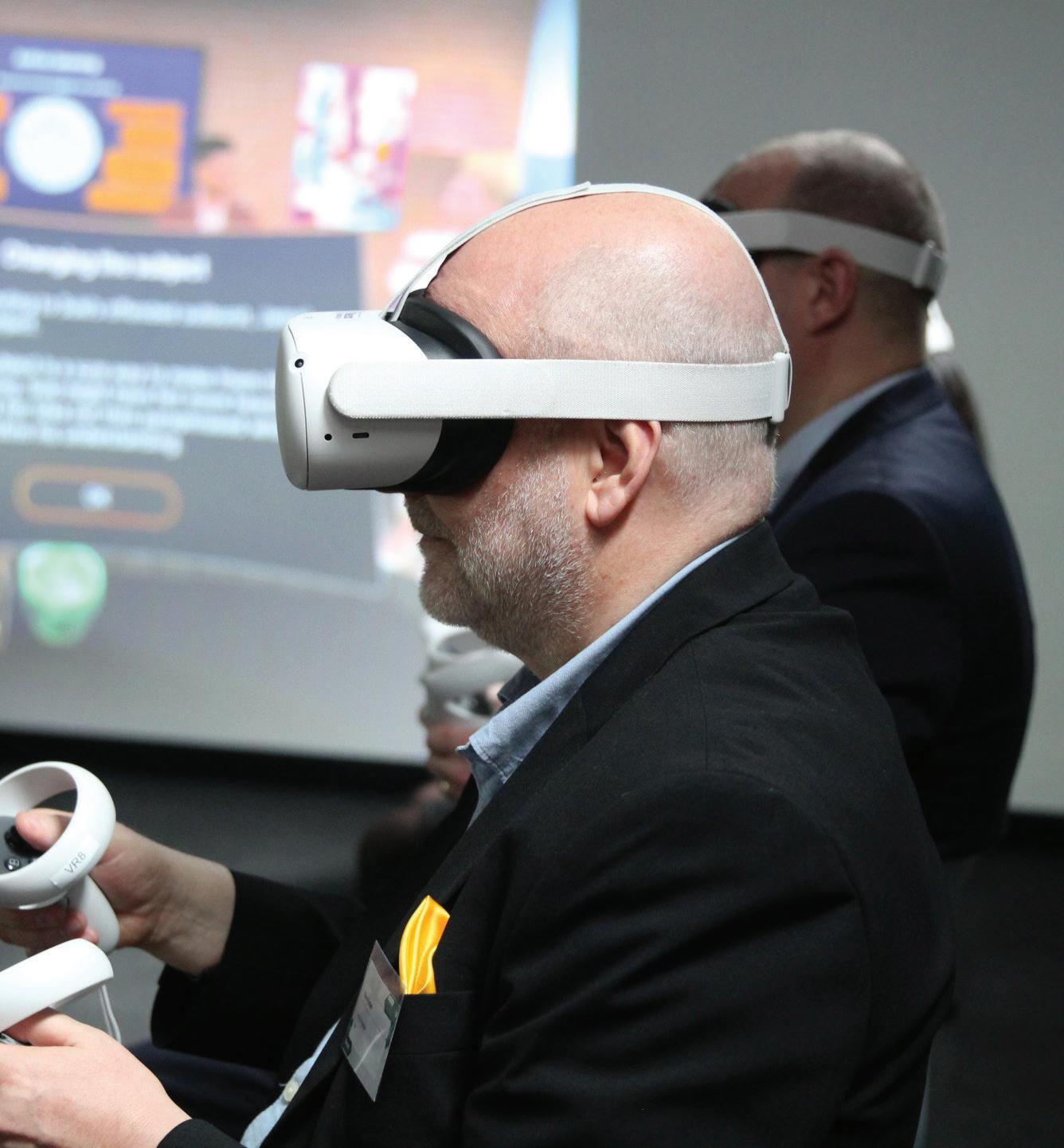
A new centre offering courses and apprenticeships in digital technologies has launched at North East Surrey College of Technology (Nescot).
Staff welcomed more than 60 guests for the grand opening, where students were encouraged to try out the specialist tech and explore the range of resources and training opportunities on offer.
The centre at Nescot is a satellite facility – the first space to launch as part of the Sussex and Surrey Institute of Technology (IoT), which also involves Chichester College Group and the Universities of Sussex and Brighton.
Formed last September, the partnership is looking to boost higher level skills training in the region through investment in a £14 million hub in Crawley and further satellites at the participating universities.
It’s also engaged with anchor employers – NatWest, Roche Diagnostics, Southern
Water, Pearson, Gatwick Airport – who are set to support the IoT by recruiting apprentices, upskilling staff and working with curriculum experts to help shape study programmes.
These programmes will cover topics ranging from software development, cyber security, AI and networking to cloud computing, data handling, internet of things and IT support.
Peter Goodenough, computing tutor at Nescot, said: “Computers are in every walk of life and every industry.
“The IoT at Nescot is offering courses to enhance future skills and aid long-term sustainability.
“You can choose from a wide range of courses on offer, from learning how to design, create and programme smart devices, industrial and home robotics, to making you mindful of your digital footprint.”
Surrey Satellite Technology (SSTL) has received and matched a £250,000 investment from the UK Space Agency to enhance its Guildford facilities.
The funding comes via the Space Clusters Infrastructure Fund (SCIF), which to date has awarded £47 million to space-related projects around the country.
It also coincided with the release of the government’s Space Industrial Plan, which made clear Westminster’s plans to better support and collaborate with commercial players in the space sector over the coming years.
Philip Brownnett, MD of SSTL, said: “We’re pleased to have been selected by the UK Space Agency for the SCIF.
“By enhancing our optical research and development cleanroom facility, the new project will help address the growing need for space-based imaging equipment for a wide range of commercial, defence and governmental customers.
“This will give a real boost to cutting-edge research into space imaging technology carried out in the UK.”
Also securing a slice of the funding was the newly launched South West Space Partnership.
Building on the success of the Space West cluster in the West of England, this pan-regional group will work to attract international investment and promote the region’s space capability.

The University of Surrey has received a £620,000 grant to build devices that can track greenhouse gas emissions – and which way the wind is blowing them.
Scientists will attach the lightweight, wireless gas sensors to helium kites flown by an autonomous robot.
Dr Robert Siddall, a lecturer in robotics, said: “If the world is to reach net zero, we need to be able to check that emissions really are reducing.
“Previous projects tried to use drones to monitor gas flux – but the quality of their measurements wasn’t good, their flight time was too short, and airspace restrictions limited their use.
“Our robot balloon towers, kitted out with sensors and built here at Surrey, should
solve many of these challenges.”
University spin-out Surrey Sensors will supply the sensors, while Hampshire’s Allsopp Helikites is providing the helium balloons.
The project will also draw upon skills at the university itself, from fluid dynamics to building robots, analysing data and monitoring emissions.
Once ready, the technology is set to be tested in locations such as the Thames Water treatment works, Blackwell Farm in Guildford, and rice paddies in Spain.
It’s one of 13 initiatives nationwide to secure investment from the government’s Natural Environment Research Council, Defra and Innovate UK to support the UN’s sustainable development goals.
Docking Station, the University of Kent’s ground-breaking Medway hub for digital creative industries, has received more than £3.5 million funding from The National Lottery Heritage Fund
This is the last major piece of funding needed for the capital costs of Docking Station, and gives the green light for building work on the £13.4 million development to start this summer.
In addition to support from The National Lottery Heritage Fund, the project has received grant funding from Arts Council England’s Cultural Development Fund and Levelling Up Fund.
Docking Station will be built on the site of the former Police Section House at
Chatham’s Historic Dockyard. It will put cultural and creative industries at the heart of Medway’s regeneration plans.
The facility will house commercial digital production studios for industry use, a café, gallery and exhibition spaces, plus teaching areas and facilities to support digital and creative start-ups and local creative industries.
Docking Station will bring together creative production, support for local businesses, education, innovation and research opportunities as well as a public programme of events and activities connecting academia, industry and communities.
The project is led by the University’s
Institute of Cultural and Creative Industries in partnership with the Chatham Historic Dockyard Trust and Medway Council, and is a key part of regeneration plans for the historic waterside site.
Professor Karen Cox, Vice-Chancellor of the University of Kent said: “The creative industries are seeing exponential growth in the UK, which is why we are delighted to be working with Medway Council and Chatham Historic Dockyard on this project.
“Forming a key part of the University of Kent’s 2030 Strategy, Docking Station will benefit students and researchers, and also businesses and communities in Medway.”
Construction should be complete by late 2025.
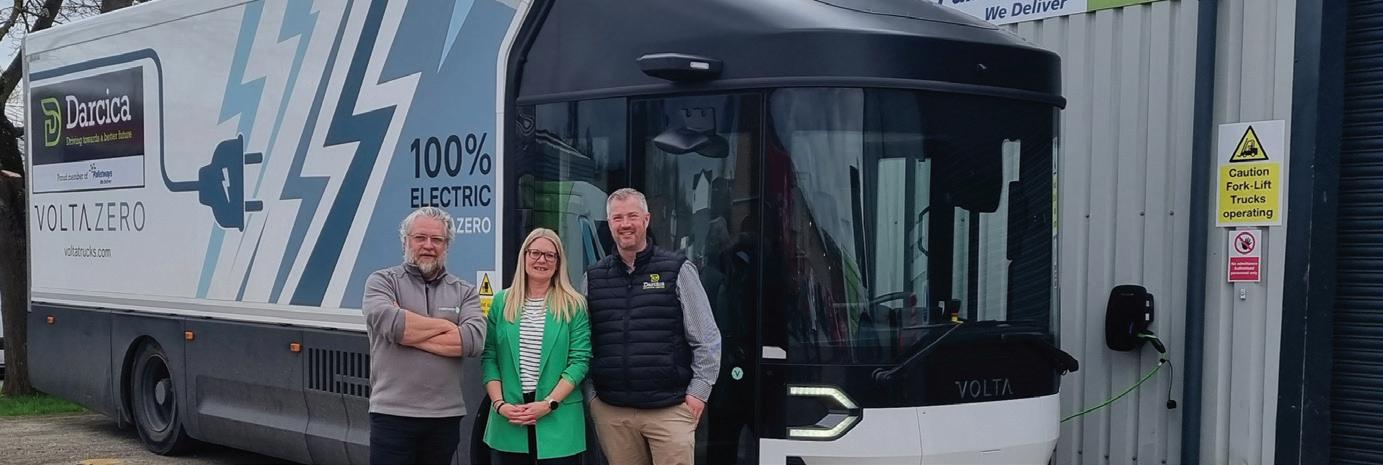
Bicester-based Darcica Logistics is testing a fully electric HGV truck for its pallet network deliveries and collections in and around Oxfordshire.
The current Darcica fleet ranges from 3.5-tonne vans to 44-tonne artics, and has now gained a 16-tonne HGV from Swedish EV manufacturer Volta Trucks.
The Volta Zero has zero tailpipe emissions and is much quieter than other HGVs, ideal for operating and delivering in and around city centres.
Anthony Tattersall, owner and director of Darcica, said: “We do about 100 miles a day and go to two hubs, Birmingham and London, so the mileage we’re doing is well
within the capabilities of an electric vehicle.
“We believe the Volta Zero will have a 200km range and hold about 10-12 pallets.
“It will be interesting to see how it performs during our trial period in terms of capacity and charging times, as well as the overall drive and manoeuvrability experience.”
The trial follows the introduction of four Maxus eDeliver9 electric vans to the fleet, which the company says have performed well.
Darcica employs 27 full-time staff at its Bicester HQ, with another 80 selfemployed at its Reading and Swindon sites under the Amazon Delivery Service Partner Programme.
A funding milestone has been reached for a major junction project near Abingdon, which means hundreds of new homes can now go ahead.
Homes England, the government’s housing arm, has agreed grant funding with Oxfordshire County Council, which will provide £17.3 million for the A34 Lodge Hill Interchange scheme.
The Vale of White Horse district council granted planning approval for the Abbey Fields development in north Abingdon for around 950 dwellings.
But until the county council was able to fund and contract the roadworks to improve traffic capacity, the housing development stopped. Now, work on the remaining 820 homes on the Abbey Fields site can go ahead.
Following the grant funding agreement, Oxfordshire County Council can now select a contractor to design and build the scheme with construction anticipated to start this summer.
Cllr Judy Roberts, Oxfordshire County Council’s cabinet member for infrastructure and development strategy, said:
“Securing funding from Homes England and appointing a design and build contractor represents major milestones for the project, and the council is now in a strong position to accelerate towards construction.
“The A34 Lodge Hill scheme will improve connectivity to and from the north of Abingdon, avoiding the town centre and making it easier for people to choose walking, cycling or taking public transport as part of their daily routine,” she added.
Coldquanta UK has agreed a lease on space in the innovation quarter at Oxford Technology Park in Kidlington.
The company – part of global quantum tech firm Infleqtion – uses atomic physics to build quantum computers and integrate them across networks to create an ecosystem of devices and platforms.
This technology has the potential to transform the life science industry by significantly reducing time and costs for drug development.
Once laboratory fitout works are complete, the Coldquanta team will move into a 7,497 sq ft fully fitted workspace at the Oxfordshire park.
It’s being leased by Life Science REIT, which acquired the site in May 2022.
Ian Harris is director of asset management at Ironstone Asset Management, investment advisers for Life Science REIT.
He said: “We’re really encouraged by the leasing momentum we’re seeing at the IQ, strengthening our conviction in this more flexible format and the fully fitted proposition.
“The IQ also provides emerging life sciences businesses with the opportunity to grow and collaborate with like-minded businesses at Oxford Technology Park, in neighbouring Begbroke and the academic institutions in Oxford.”

Albion Land is set to welcome Tesla and an innovative design and manufacturing firm to its new Catalyst Bicester technology park, currently being developed.
Tesla will establish its first presence in Oxfordshire, with the company moving into a 24,000 sq ft new-build unit, while an as yet unnamed firm will occupy 29,600 sq ft.
They’ll join aerospace company Evolito and EV motor business Yasa as the park continues to attract occupiers. Six buildings have been completed and are either occupied or handed over. Two further buildings are expected to be ready this summer.
The site will ultimately cover a total footprint of more than 400,000 sq ft, comprising several hybrid buildings designed for the tech and advanced manufacturing sectors.
Simon Parsons, director of Albion Land, said: “It’s a sign of the strength of the park and the location that both Tesla and a further tech-driven design and manufacturing company have chosen Catalyst Bicester.”
Planning permission is already in place for the next phase, which will be facilitated by lettings agents CBRE and Colliers International.
Oxfordshire-based Roadside Real Estate has acquired a new asset on the A444 near Coventry as part of its joint venture with Meadow Partners.
The 8.25-acre site was bought for £3.26 million and currently features a 72,091 sq ft former Sainsbury’s food store, vehicle filling station, and 407-space customer car park.
Roadside sees potential for an EV charging hub, with options at the rear of
the property for retail or last mile logistics. The site has been bought with vacant possession, allowing the buyers to review the site’s configuration and look to redevelop it to serve a variety of complementary tenants.
They have already received expressions of interest from a number of brands focused on drive-through and ‘foodvenience’ offerings.
Charles Dickson, executive chairman of
Roadside, said: “This is an exciting third acquisition for the joint venture, with significant scope for EV charging infrastructure in line with our strategy. It has redevelopment potential and a variety of asset management opportunities.
“The Coventry site is a perfect example of the kind of assets we’re seeking to develop into high-amenity facilities that benefit their surrounding communities.”

Oxford’s renowned Covered Market is celebrating 250 years in business and celebrations are planned throughout the year.
Now Oxford City Council, which owns the market, is on the hunt for a design team to carry out a £6.87 million overhaul of the Grade II listed building.
Since opening in 1774 with 20 butchers shops, the Covered Market has become an architectural and cultural landmark.
Designed by John Gwynn, also known for Magdalen Bridge, it was listed in 2000 and has rarity value as a covered market which has been in continual use primarily by local businesses. Around 60 independent businesses are now based there, selling local crafts, food and drink.
Between 2021 and 2022 market experts Gort Scott Architects spoke to market traders, Oxford residents and other stakeholders, to help create a masterplan for redevelopment.
The multi-million pound redevelopment of the covered market will see the entrances in High Street and Market Street transformed, larger seating areas inside the market, and a new outdoor seating area in a more pedestrian-friendly Market Street.
The aim is to encourage visitors to spend more time in the Covered Market to help safeguard its future, strengthen the market as a destination and attract a wider audience.
Polar Technology has joined forces with Supacat UK as it looks to contribute to the British Army’s high mobility transporter (HMT) vehicle – or ‘Jackal’.
The Oxfordshire company will provide safety solutions to the roll over protection system on the Jackal, working closely with Supacat’s assembly partner Babcock.
Polar Technology, which is based in Eynsham, brings its expertise in the engineering of precision fabricated assemblies, tube manipulation, high integrity coded welding, managing supply chains and delivering to tight regulatory standards.
Tom Lloyd, head of commercial at Polar Technology, said: “We have been engaged with Supacat for nearly 10 years.
“We’re delighted to be contracted on the new build Jackal 3 programme. Our relationship has grown and improved significantly.”
Polar Technology welcomed Supacat to its facility to give the team an opportunity to experience first hand where the parts they design and manufacture end up.
Tom added: “We look forward to working with Supacat to support them in bringing new platforms, upgrading in-service
vehicles and technologies to the market for many years to come.”
Supacat has been designing and developing high mobility all-terrain vehicles for since the 1980’s. The company has more than 1,000 tactical vehicles in service around the world with the UK Armed Forces and Elite Special Forces worldwide.
Supercat operations director, Lizzie Jones, said: “We’ve been working with Polar Technology on the enhanced parts to ensure the certified parts we designed are made to our specification, and our tooling allows for a repeatable manufacturing process.”

The Minimum Energy Efficiency Standards (MEES) has become a central legal focal point in property leasing, exerting influence on existing leases, suggesting heightened benchmarks for the future, and incorporating carbon factors into Energy Performance Certificates (EPCs).
B P Collins, the Thames Valley Property Awards’ Law Firm of the Year, explores the legal intricacies of MEES compliance, providing insights into strategic considerations tailored for landlords and tenants.
In the ongoing lease landscape, MEES introduces significant legal considerations. Landlords are required to understand and adhere to their legal obligations, ensuring that the energy efficiency of their properties aligns with MEES requirements. Navigating the complex web of compliance is crucial, especially with the impending 2025 deadline for Energy Performance Certificates (EPCs) on all leased properties. It’s vital to seek advice from a specialist property lawyer to help guide you through the complexities of MEES and assist in the implementation of necessary measures to meet these evolving regulatory provisions.
Proposal to reduce minimum rating to B by 2030
Looking towards the future, discussions surrounding MEES propose an ambitious shift by raising the minimum energy efficiency rating to B by 2030. This signifies a shift in the industry’s commitment to sustainability, challenging landlords to not only meet current
standards but to anticipate and invest in improvements that align with these evolving criteria. The proposal encourages a forward-thinking approach, emphasising the importance of long-term environmental responsibility in property management. It’s important to remain well-informed about the potential impact of these proposals, to help navigate the evolving standards and proactively address any legal challenges that may arise.
In June 2022, there was a significant change in the EPC landscape with carbon factors being introduced. Carbon factors are a crucial component of EPCs, as they quantify the amount of carbon dioxide emissions associated with the energy consumption of a building. It’s crucial for those engaged in property leasing, including landlords and tenants, to be aware of these changes and make appropriate improvements. When evaluating or renewing leases, understanding the implications of these carbon factors becomes essential in navigating the shifting criteria.
Beyond compliance, it’s imperative to recognise the strategic opportunities presented by MEES. A lawyer can advise landlords and tenants on leveraging MEES strategically during key lease events such as renewals, rent reviews, and dilapidations. It is advisable for landlords to consider upgrading their energy efficiency practices to not only meet the MEES compliance standards but also to increase the overall appeal and market value of their properties.
At B P Collins, we understand the importance of aligning regulatory compliance with commercially sensible decisions. We are here to help clients navigate the complexities of MEES, ensure compliance with existing regulations, anticipate future changes, and consider opportunities for sustainable property management. As the 2025 deadline approaches, and proposals for a higher minimum rating by 2030 gain traction, our legal team is able to guide clients through the evolving landscape of MEES compliance, offering a proactive and informed approach to sustainable practices.
If you have any further questions or require assistance, please contact our property team at enquiries@bpcollins.co.uk or call 01753 889995




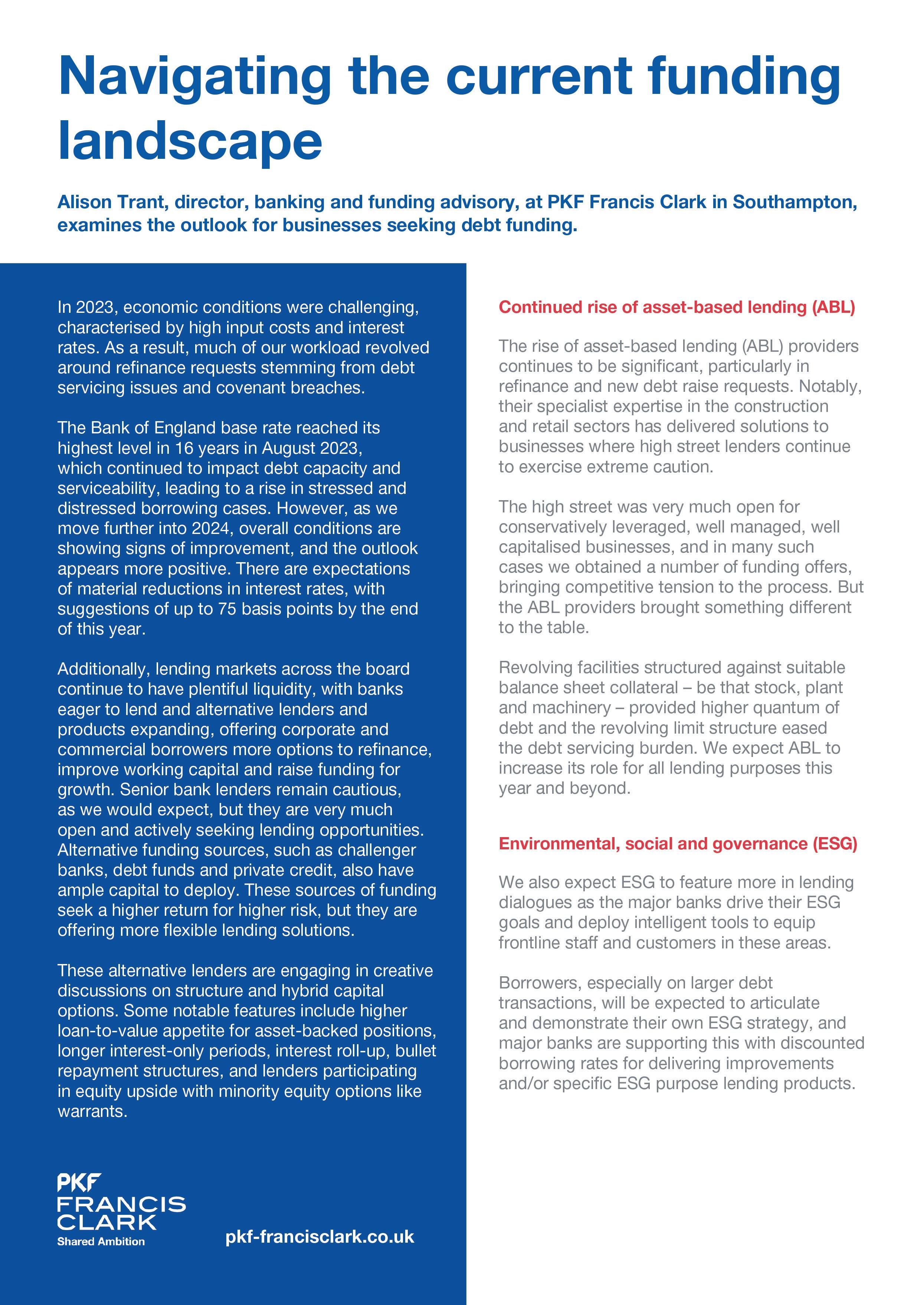
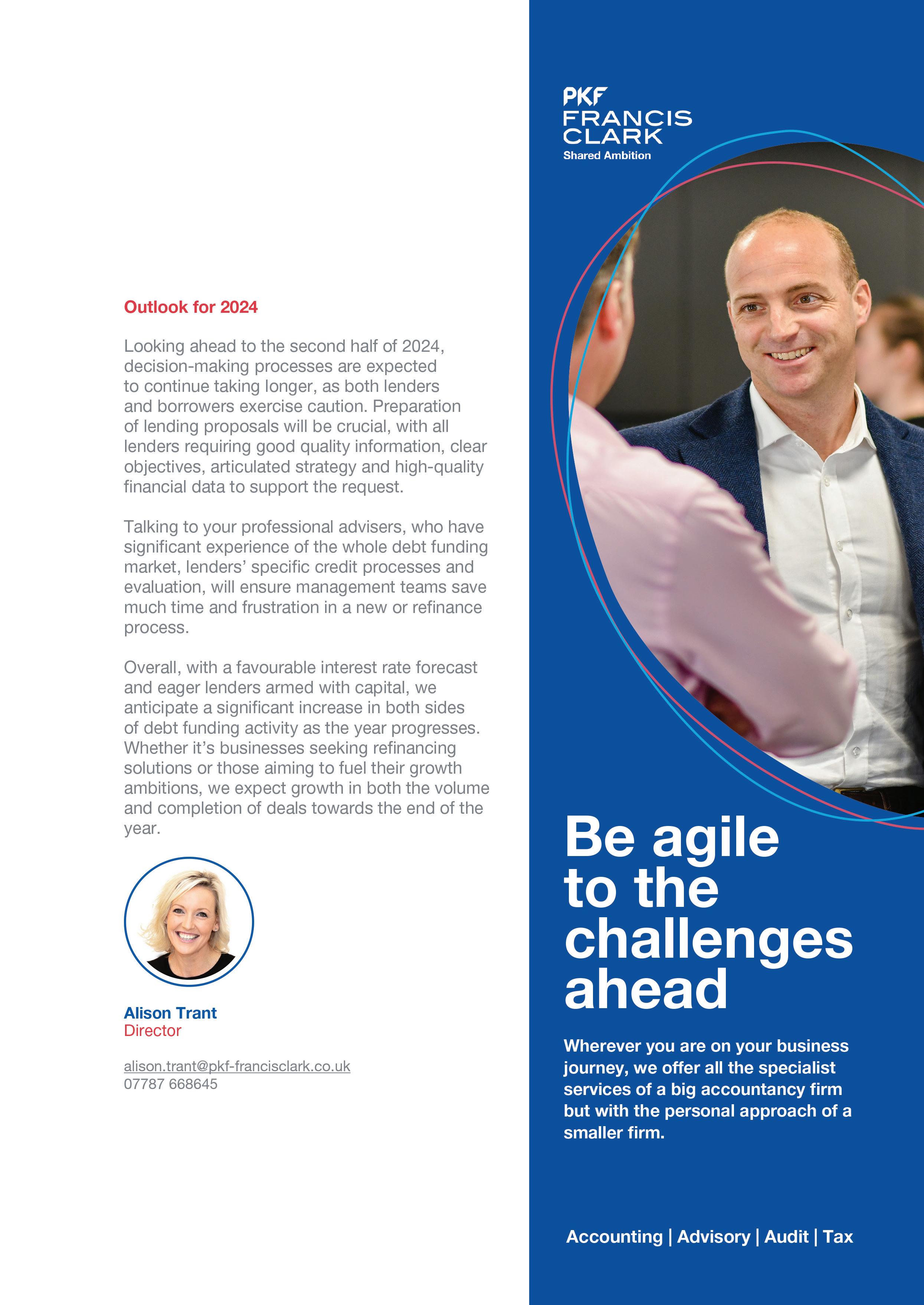

The region’s leading deals professionals were unveiled at the Solent Deals Awards 2024 with winners and finalists in 13 categories celebrating their outstanding achievements.
The highly popular and lively event brought together corporate finance advisers, lawyers, bankers, private equity investors, accountants, funding specialists and the management teams that have led the deals themselves. The view from Award winners was that the region's deal activity was strong in a challenging year.
Richard Thompson, Managing Director of the awards organiser The Business Magazine, thanked the independent judges for their “tireless efforts” supporting the judging panel and helping to whittle down the entries to a shortlist of finalists and winners.
For the Small, Mid-range and Large


Deal of the Year awards, the judges’ votes counted for 70% and voting by the audience on the night for 30%.
The event sponsors were James Cowper Kreston, Ellis Jones Solicitors, Paris Smith, Meridian Corporate Finance, Pangea Life, CMA Recruitment, Moore Barlow, NatWest, Sightline, Hampshire BizNews and Deal Ticket.
Held at the Hilton Southampton – Utilita Bowl and hosted by TV presenter Mark Durden-Smith, the Solent Deals Awards also provided an opportunity for networking and charity fundraising.
This year, the Awards' charity was the Motor Neurone Disease Association. Guests donated £3,600 on the night to help people living with or affected by MND. Further contributions in aid of the charity came from a silent auction which raised an additional £868.



 Host Mark Durden-Smith
Host Mark Durden-Smith
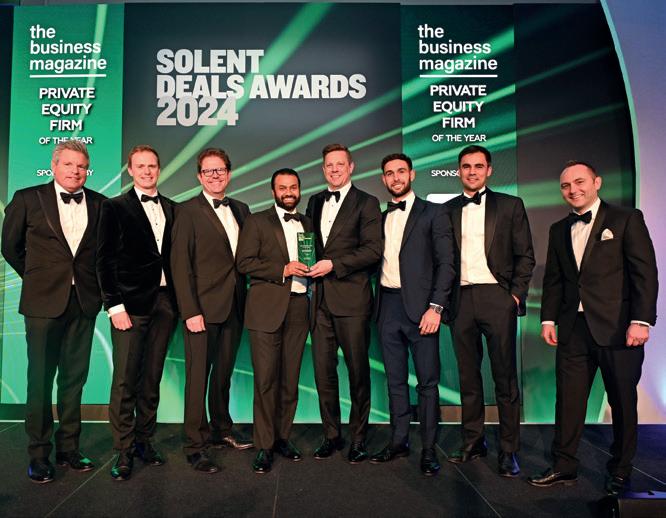
PRIVATE EQUITY FIRM OF THE YEAR
WINNER: LDC
SPONSOR: Moore Barlow
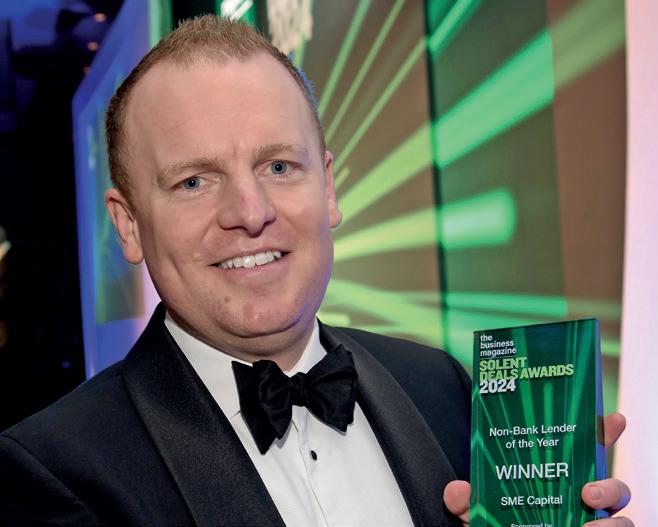
NON-BANK LENDER OF THE YEAR
WINNER: SME Capital
SPONSOR: Hampshire BizNews




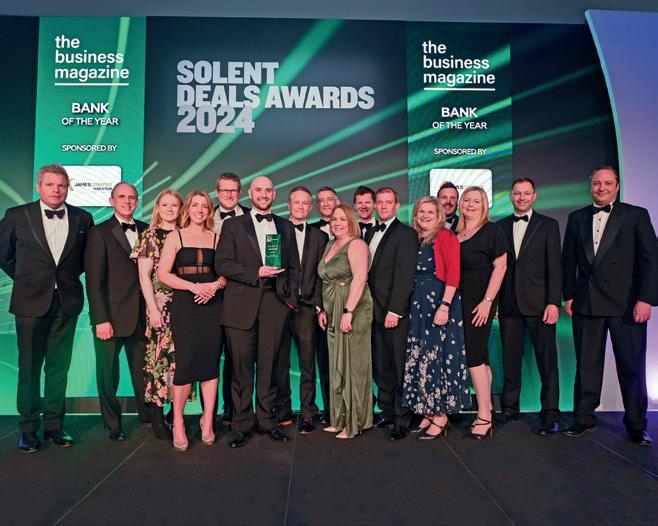
BANK OF THE YEAR
WINNER: NatWest
SPONSOR: James Cowper Kreston



DUE DILIGENCE TEAM OF THE YEAR
WINNER: RSM UK
SPONSOR: Ellis Jones Solicitors
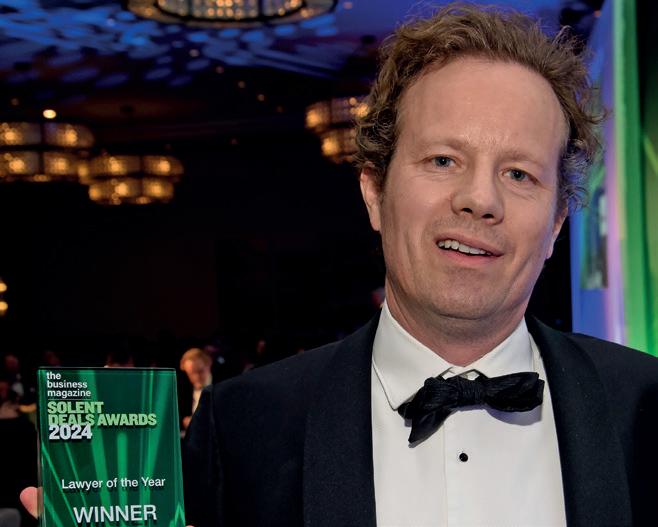
LAWYER OF THE YEAR
WINNER: Oliver Kelly – BDB Pitmans
SPONSOR: Pangea Life





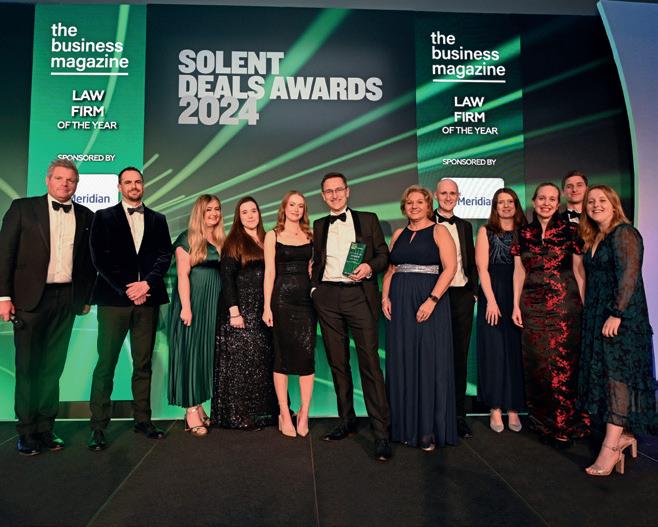
LAW FIRM OF THE YEAR
WINNER: Blake Morgan
SPONSOR: Meridian Corporate Finance


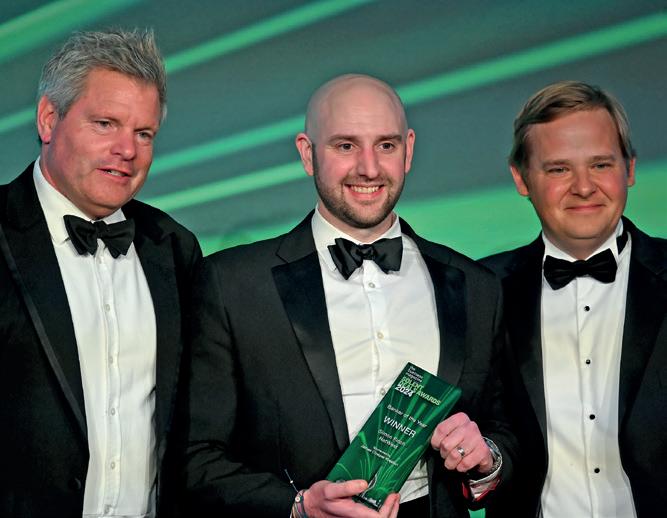
BANKER OF THE YEAR
WINNER: Simon Finch – NatWest
SPONSOR: James Cowper Kreston
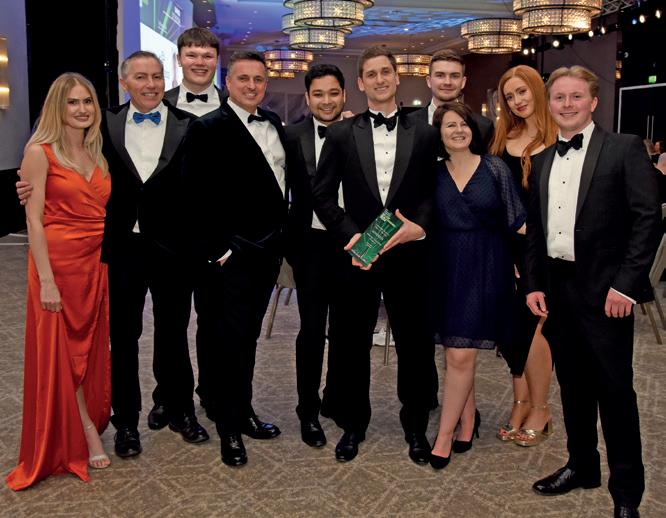
CORPORATE FINANCE TEAM OF THE YEAR
WINNER: Meridian Corporate Finance
SPONSOR: Sightline

CORPORATE FINANCE ADVISER OF THE YEAR
WINNER: Darren Miller –FRP Corporate Finance
SPONSOR: Ellis Jones Solicitors






MID-RANGE DEAL OF THE YEAR (£10M - £50M)
WINNER: Jimmy’s Iced Coffee sale to Britvic Soft Drinks
SPONSOR: CMA Recruitment Group



YOUNG DEALMAKER OF THE YEAR (UNDER 35)
WINNER: Prabin Sunar – Meridian Corporate Finance
SPONSOR: Deal Ticket
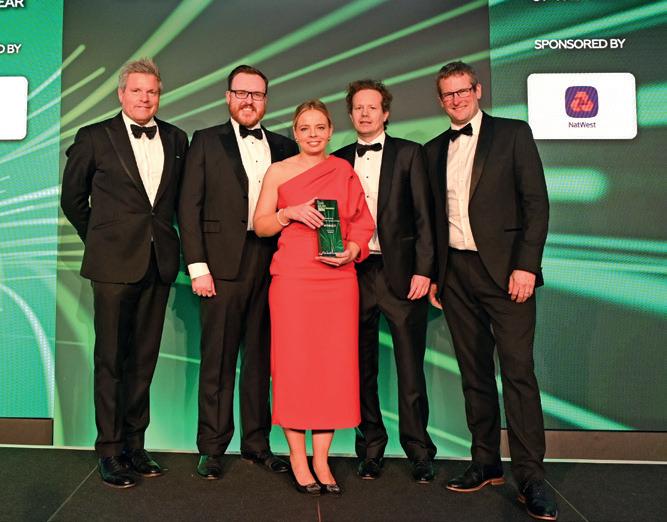
SMALL DEAL OF THE YEAR (UNDER £10M)
WINNER: Red Funnel acquisition of Hythe Ferries


LARGE DEAL OF THE YEAR (OVER £50M)
WINNER: H.I.G. Capital acquisition of CLC Group
SPONSOR: Paris Smith



SPONSOR: NatWest TO READ MORE PLEASE USE THE QR CODE BELOW



Vodafone Italy (Berkshire)

has been acquired by Swisscom (Switzerland)
Buyside advisers include:
Evercore Partners International (financial) Deutsche Bank (financial) | JP Morgan Securities (financial) | Legance Avvocati Associati (legal) | White & Case (regulatory)
Sellside advisers include:
UBS (financial) | Slaughter and May (legal) ADVANT Nctm (legal) | Linklaters (antitrust legal)

has been acquired by Packaging firm Mondi (Surrey)
Buyside advisers include: Linklaters LLP (legal) | UBS (corporate broker) Rothschild & Co
Sellside advisers include: Slaughter and May (legal) | JP Morgan Cazenove (corporate broker)
Goldman Sachs International (financial adviser)
Logistics firm Wincanton (Wiltshire)

has been acquired by Supply chain management company Ceva Logistics (France)
Telecommunications testing company Spirent Communications (West Sussex)

has been acquired by Network test firm Viavi Solutions Inc (United States)
Buyside advisers include:
Wells Fargo Securities (financial adviser)
Sellside advisers include:
Linklaters (legal) | Rothschild & Co (financial adviser) | UBS (corporate broker | Jefferies (corporate broker)
APC Technology (Kent)

has been acquired by Shawbrook Bank
Buyside advisers include: Shoosmiths LLP
MHA Moore & Smalley
Sellside advisers include:
Brachers LLP | Goldman Sachs International (financial adviser)
Arculus Cyber Security (East Sussex)

has been acquired by Cybersecurity firm Bridewell (Berkshire)
Jigsaw Business Solutions (London)

has been acquired by Incentive platform Tillo (East Sussex)
Buyside advisers include: EMC Corporate Finance

has been acquired by Collectibles group Hornby (Kent)
Boating marketplace Zizoo (Germany)

has been acquired by Borrow A Boat (Hampshire)

IT provider Excalibur Communications Group (Hampshire)

has been acquired by Telecoms provider Onecom (Dorset)
Buyside advisers include: HMT (financial)
Sellside advisers include: Moore Barlow
Rovers Medical Devices (Netherlands)

has been acquired by
Healthcare specialist Halma (Buckinghamshire)
Immigration services company European Homecare (Germany)

has been acquired by Outsourcing specialist Serco (Hampshire)
With increasing pressures to maintain a competitive advantage, there is a growing recognition of the transformative impact M&A can have, compared with the slower burn of organic growth.
The year’s M&A activity seems likely to continue being driven by the ongoing need for larger businesses to adapt to rapidly changing industries, embrace new technologies (such as AI) to keep up with (or ahead of) the competition, scale up to achieve economies and give security and greater scope for taking opportunities, expand into international markets and enhance their ESG credentials. A good example of this trend was the acquisition of Andigestion by Seven Trent Green Power from our client Summerleaze, which recently won Deal of the Year at the Thames Valley Deals Awards.
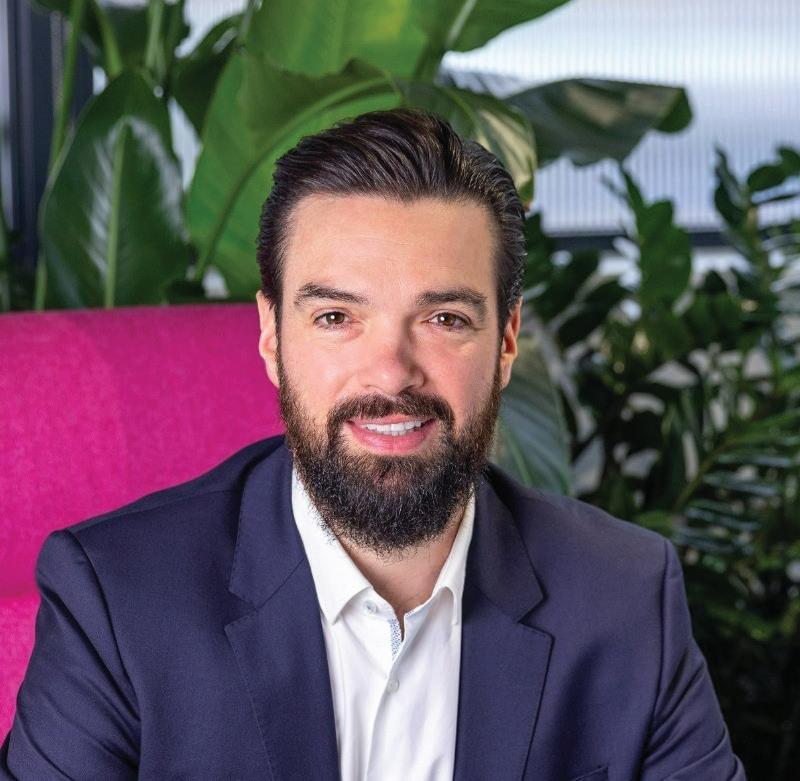
As larger companies are not impervious to the economic instability of late, there is an M&A strategy trend around focusing on making multiple smaller acquisitions, rather than larger, more expensive takeovers. On the other side, smaller business owners may be experiencing a static market with
slow organic growth and contemplating selling due to fatigue from tough conditions.
This appetite for M&A is good news for the UK market, which was recently ranked as the most attractive destination in Europe for domestic and inbound M&A activity. Deals are further encouraged by lower inflation and rates normalising. Private equity firms also continue to harbour substantial funds and are showing keen interest in businesses that have managed effectively to weather the recent market turmoil.
Although the upturn is expected to be more measured than in previous years, the rest of 2024 is looking positive with M&A activity likely to be influenced by ESG factors, cross-border activity and technological innovation.

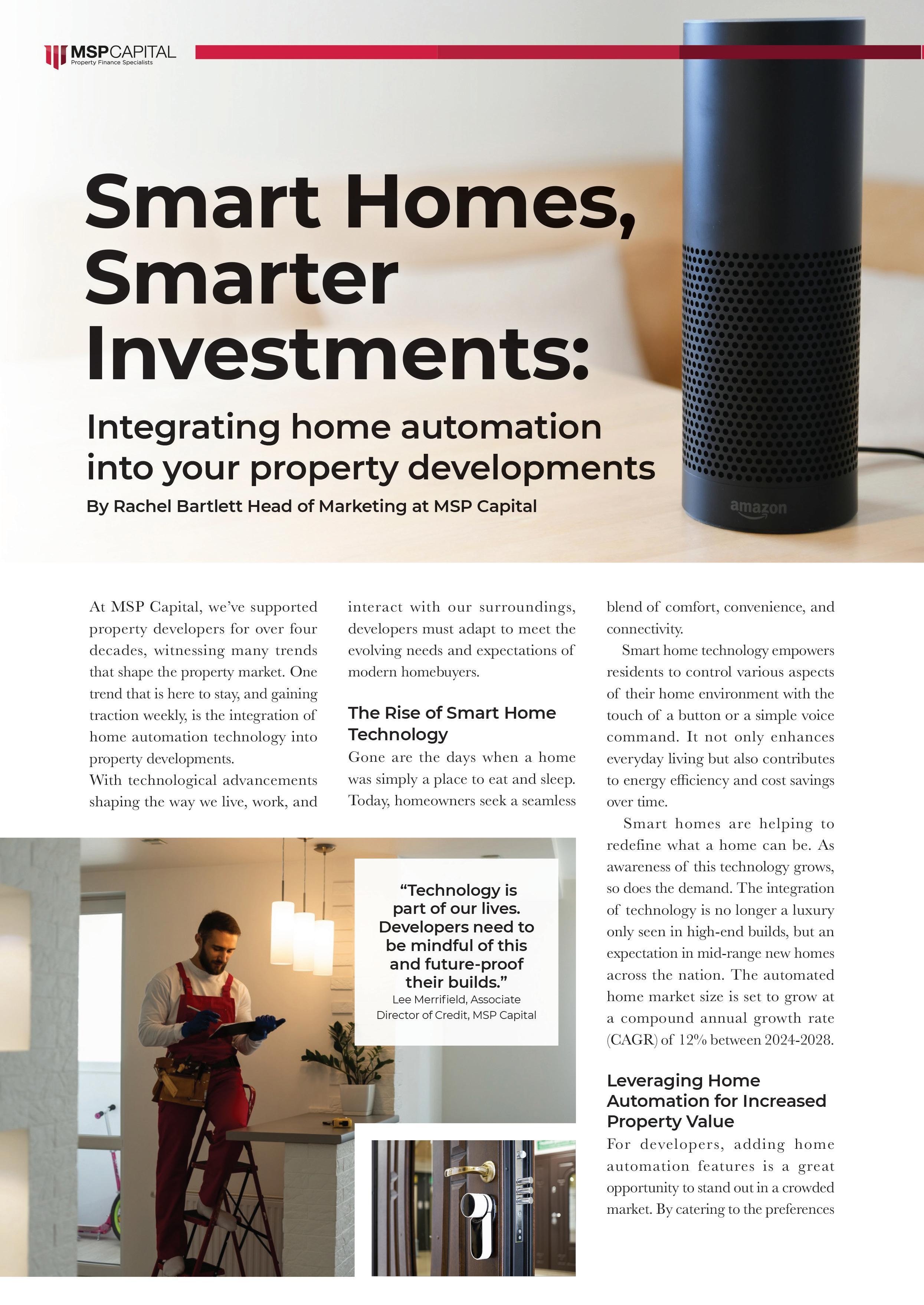
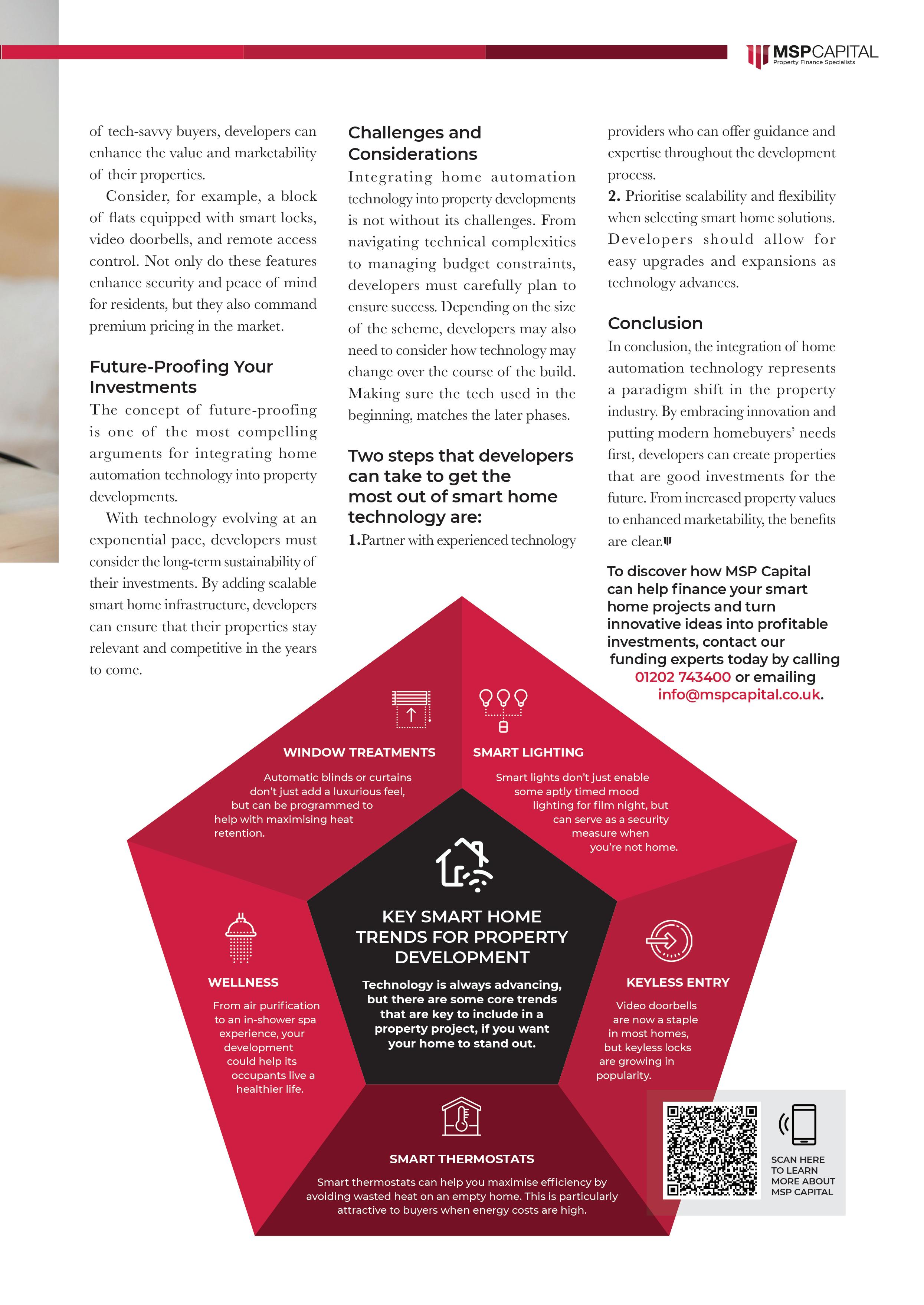
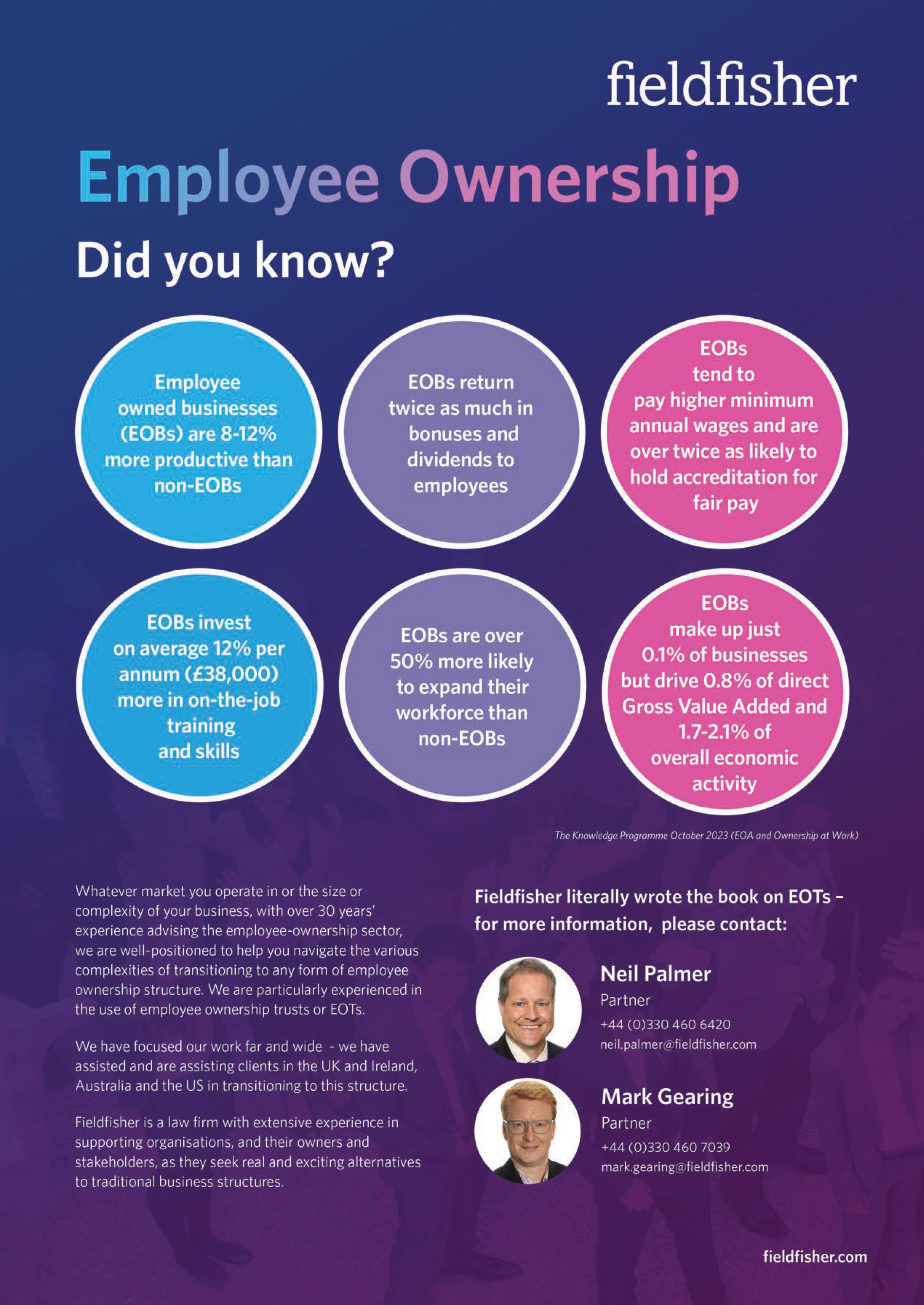


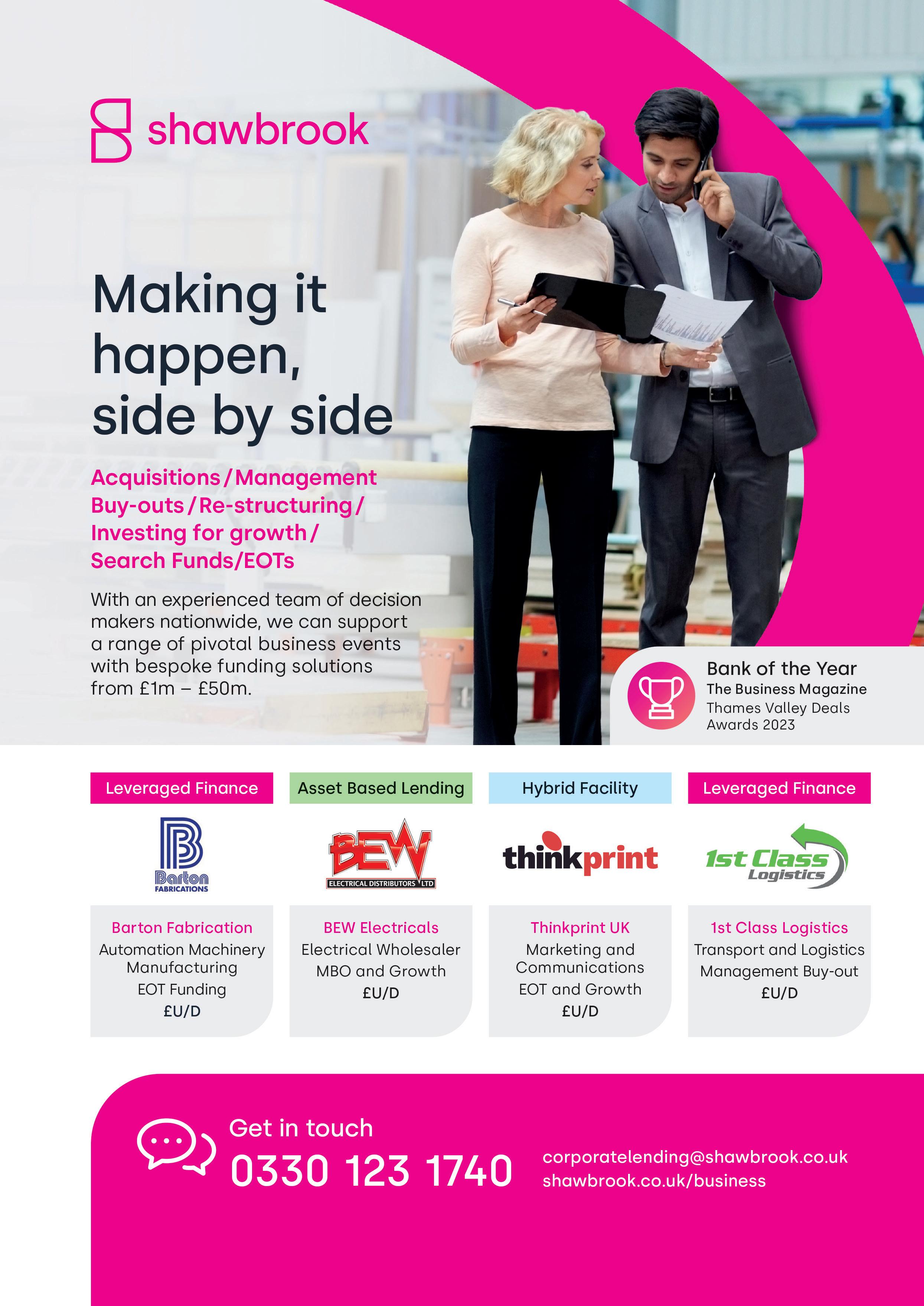
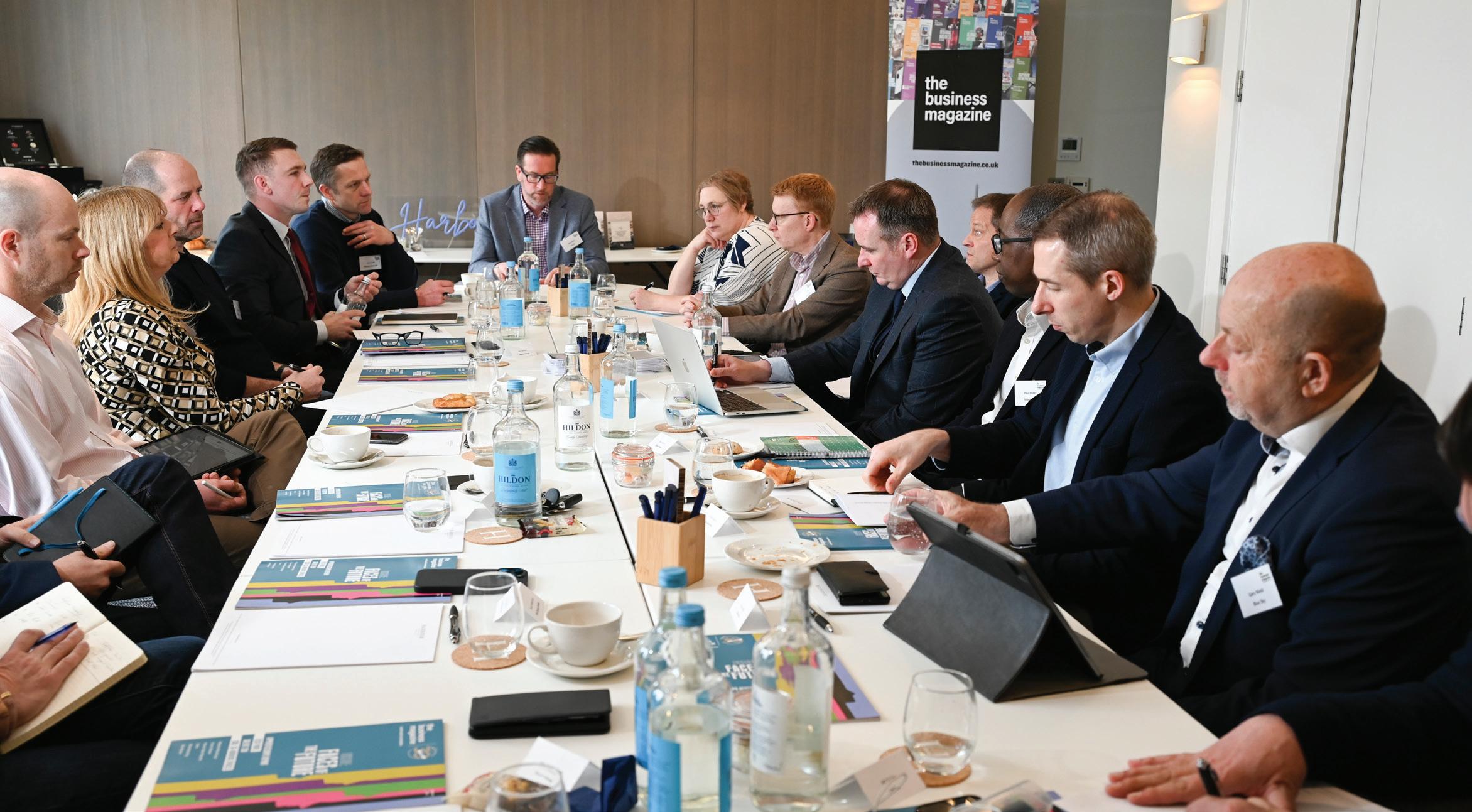
Over the past six months, The Business Magazine, law firm Fieldfisher and Shawbrook have collaborated to help demystify Employee Ownership (EO).
The outcomes of this collaboration are detailed in this supplement which includes two roundtables where we brought together companies considering EO with those that have completed the move.
Representatives from Fieldfisher and Shawbrook were also on hand to explain the intricacies of EO.
What was clear from chairing both roundtables was the passionate belief in EO from representatives of the companies that had made the transition.
There is also a clear and growing interest in EO shown by the number of businesses, large and small, that attended each event and their engagement in the discussion.
The Employee Ownership Association (EOA) puts the number of EO businesses across the UK at 1,300 at the end of 2022, up by 285 from the previous year. Its chief executive James de le Vingne said that good employee ownership is built
around the three pillars of governance, communications and engagement alongside strong leadership.
He said: “When all those three things are firing and working well then you activate great EO.”
EO models can also provide a competitive edge in the marketplace, particularly when it comes to attracting and retaining staff, while better deals can be struck with suppliers who know they are dealing with a robust entity that is unlikely to deviate on terms.
James said: “EO offers employees a meaningful say in how the business is run so is therefore a key retention tool.
“It also speaks to the cultural change happening in the workplace where there is an expectation, especially in the younger workforce, to have a say in where they work.
“The Nuttall Review, commissioned by government and published in 2012, found that EO leads to better staff engagement, better productivity and more sustainable businesses.”
The move to EO can be completed in a few months or sometimes less, however a change in company structure is no guarantee of future success.
Neil Palmer, a Partner at Fieldfisher, underlined this point. He said: “The real work starts after you complete the deal and set it up, as people have to be invested in the structure to make it work. There has to be the energy, enthusiasm and entrepreneurialism that was once provided by the founder to make EO a success.”
A move to Employee Ownership could bring positive benefits to a company and its staff and this, according to Paul Miller who is an Associate Director at Shawbrook, is one of the most rewarding parts of the job.
He said: “We have helped a fair number of companies and there is always enjoyment in helping people achieve a goal.
“When you can walk into a business that has transitioned to EO and see smiling faces as the teams discuss business growth opportunities, I think that has got to be a natural high point.”
ONE 1
Make sure you have a collegiate culture
Culture plays a vital role in the success of Employee Owned (EO) companies as it’s the employees who are responsible for delivering the business’s future plan.
A founder can often be the lynchpin of a company’s culture, and this should be lessened in preparation for a move to EO by them taking a step back and ensuring a strong management team is in place.
In preparation for the company’s move to employee ownership, Gary Neild of Blue Sky Financial Planning got his employees to write a book spelling out the company’s culture.

THREE 3
Have a strong management team in place
The management team is vital in any EO organisation. They are responsible for ensuring the company’s performance meets expected levels and will take over management of the business as the founder steps back. They also take a lead role in delivering EO. This is vital to ensuring that the founder receives the full purchase price and that banking covenants are met.

TWO 2
Have a robust finance function
Any company considering EO should have a strong finance function to ensure the company remains on track to meet its targets and remains profitable.
A robust finance function will help to ensure that the founder receives their full purchase price and is a key requisite for lenders who may fund part of the consideration.

FOUR 4
Have clear communication throughout the process
Clear communication should be prioritised throughout the move to EO. Founders are encouraged to talk to management and staff to get a feel for whether there is buy-in and whether they think a move would be successful.


The management team should be incentivised to remain with the company for the long term and deliver a successful EO. One approach could be to achieve a “hybrid” ownership structure where the majority of the shares is held by the Trust, and a minority is issued to key talent within the company.
EO is best suited to businesses that are consistently generating strong returns and should not be considered as a last option when efforts to secure a trade sale or private equity money have failed. This is because EO transactions rely on the business to generate the purchase price. Robust cashflow modelling is essential from the outset.

SEVEN 7 Employ a good team of advisors
Founders should speak to advisors early. This will keep you in line with tax regulations and you’ll know how likely it is that an exit will be part-funded or financed completely by the profits of the company. EO requires complex tax rules to be satisfied.
Failure to meet these requirements could result in the tax relief not being available, or being subsequently clawed back. An experienced adviser will have a good understanding of finance options and a solid relationship with specialist lenders. As such, the adviser can introduce a funding expert early on, which in turn can speed up the pay-out to the founder and the transition itself.
Have a diverse trust board
The trust will effectively own the business and will represent the interests of the employees. The board should include professional trustees who act independently in the interests of the employees and are able to hold the management board to account.
Make sure that your trust board is balanced with representatives from senior management and employees, and has an independent chair.

Not all businesses are best suited to EO, with people-based businesses commonly completing the move. Professional services firms with cohesive cultures tend to perform well under EO. But any business can become employee-owned if it has the right culture and energy to make it a success.
EO is a succession strategy and a way of exiting a business. However it is also a business model which has been proven to improve performance for some companies.
If a founder’s motivation to move to EO is purely based around tax, then they could run into difficulty as the employees are unlikely to be aware of the potential opportunities now with them while these should really help unlock good employee ownership.

The decision to exit a business puts many founders at a crossroads and while their compass is often guided by wanting to protect what has been built up They also have an eye on securing just rewards for their efforts.
Employee Ownership (EO) either through a trust structure or shareholding offers the founder an attractive, and potentially tax-efficient exit, while also rooting the firm where it is based and safeguarding its culture and employees.
The Nuttall Review of Employee Ownership published in 2012 set out measures to encourage EO and outlined three models: Employee Ownership Trust (EOT), direct shareholding and a hybrid approach.
An EOT sees ownership of a business pass to employees via shares held in a trust, while direct shareholding sees a small or larger group of employees directly acquiring shares in the company. The hybrid approach combines majority shareholding in a trust with direct ownership by some employees.
Fieldfisher is one of the UK’s leading advisors when it comes to EO and counts EOT report author Graeme Nuttall as a former Partner.
Neil Palmer, who co-heads the EO team at Fieldfisher, said: “EO provides a good way of exiting or putting together a succession strategy that enables a founder to structure an exit in a measured and thoughtful way,
as opposed to the big shouting match that a trade sale can become.
“It suits founders who want to protect their staff and the value that has been built up, as it is a way of locking in all the good things they have developed alongside preserving the ethos of the business.”
EOT models have the share-holding trust at their heart. Companies that have successfully transitioned maintain regular communication and interaction with the operating company’s board through reporting and consultation. It is also beneficial to create special employee councils and voice groups that feed into the management and governance structure.’
Once the consideration for an EOT’s shares has been paid in full, profits that would previously have gone out as dividends can be paid to staff as all-employee bonuses.
The trustee’s board of directors must ensure that the main purpose of the EOT is maintained and the interests of the employee beneficiaries are looked after. The board of trustees will manage the“shareholder function” on behalf of the employees, be responsible for monitoring the new ownership model within the underlying business and tracking its performance. This will primarily be delivered through board meetings and interactions with the operating company.
The purpose of an EOT is to provide permanent or long-term employee ownership of a company, through holding a controlling interest in a company’s shares on trust for the benefit of all the company’s employees. This means holding more than 50 per cent of the shares and, unless there’s a hybrid EO model, most will build the holding up to 100 per cent of a company’s shares.
In the UK, the government provides tax benefits when an EOT first acquires a controlling interest.
Neil Palmer of Fieldfisher said: “Good practice is to establish the trustee company with a board comprising representatives of the founders, senior management and the same number representing employees as a whole.
“Each group can appoint and remove its trustee directors and there is an independent chair.”
The key thing is that non-sellers should be in the majority to ensure that control has effectively passed.
Another EOT characteristic is that individual employees do not get awards of shares, they do not have actual ownership of any of the EOT’s shares. The trustee holds its shares on a discretionary trust for the benefit of all present and future employees, as an ever-changing class of beneficiaries. They are indirect shareholders.

Neil said that EOTs were particularly suited to companies with strong financial performance but it is not the ideal solution for every business or founder.
He said: “EO is not for everybody and there are different ways of structuring or exiting a business.
“The purchase price will be determined through an independent valuation, meaning you don’t get that competitive tension where you have people bidding for a business which may drive up the price. You will get a fair price (market value) but you won’t be able to take advantage of a buyer willing to pay a premium for your business. I think most founders are happy with that compromise.”
Founders considering an EO should have an independent valuation carried out to determine the company’s market value. The valuation is crucial because it is a part of the structure that HMRC could enquire into as a potential area for abusing the tax relief.
Mark Gearing, Partner at Fieldfisher, said: “It’s important to look at the tax aspects of the structuring very closely. If you get it right, then you don’t pay any capital gains tax on the sale to the EOT as it is currently an uncapped relief.
“If you were selling to private equity or a trade sale, then the rate of capital gains tax would typically be 20 per cent currently.
“You do need an independent, robust valuation as trustees cannot pay more than market value for the shares as that would be a breach of trust.”
Business owners exiting through EO models, be it an Employee Ownership Trust (EOT) or employee shareholding, have two funding options. The first sees them leave initially with an intial payment and receive the remaining compensation for the
business over a number of years as their former enterprise generates profits and in turn pays them back. The second involves an immediate payment for the full or partial amount of the sale from a funding partner, with the debt underwritten by the company and paid back over time.
Paul Miller, Associate Director at Shawbrook, said the relationship EOdestined companies have with their bank or funding partner is of paramount importance when going through a sales process.
He said: “We pride ourselves on our relationship with clients. When you come to Shawbrook you are typically preparing for a transition to EO status or refinance of a prior transaction and there is an event that needs financing. With an opportunity to secure finance comes various steps to work through and the associated planning
“Having someone alongside you who understands the transition, debt financing and the business itself is key to the deliverability of the proposal.”
Oliver Jenkins, Director at Shawbrook said: “An EOT can be a big cultural shift for management teams and choosing the right banking partner can be crucial. A business considering transitioning to EO may not have operated in a debt environment before. We flesh out what the business relationship will look like, what the reporting requirements are and what a good system and procedure might look like in-house.
“The relationship with someone like Shawbrook is very different to one you might have with high street banks where you are part of a portfolio of several hundreds of clients.”
One of the main incentives for founders in moving their business to an EOT model is that they forego Capital Gains Tax allowing a tax efficient exit from their company.
James de le Vingne, CEO of the Employee Owner Association, said that companies transitioning to an EOT, where the founders’
motivation was solely based around a tax incentive, could run into future difficulty.
He said: “EOT is a highly tax efficient way to dispose of a business, however if this is the only reason then the new employee owners are unlikely to be aware of potential new opportunities that will enable them to unlock good employee ownership.”
If founders retain a minority stake in the business after completing an EOT, and then sell that stake on, they will be liable for paying tax on that part of the sale.
EOTs are designed to be a settled state for a business, according to Neil Palmer. Reversing the trust arrangement does have consequences. He said: “It is not irreversible but it is considered an end state, and it is more challenging to change the structure in future. When you sell a business that is in an EOT, you are selling it out of trust which is a disqualifying event under the tax regime meaning the trust or founders would have to pay the Capital Gains Tax. It’s not a mechanism which lends itself easily to future change, be it a merger, offer or IPO. It can be done with careful planning, but there is a tax price to pay.”
John Palmer, Senior Director at Shawbrook added: “Like any change, a move to EO can prove challenging. It is critical to have some initial settling-in time while keeping a focus on future growth. EO businesses may also later consider additional financing to support growth or refinance existing debt.”
A government consultation into reforming the EOT regimes ended in September last year, however no date has been announced for the implementation of future changes.
Mark Gearing of Fieldfisher said: “Employee Ownership has had cross-party support so I don’t think the tax relief will be withdrawn completely, but it may be capped at some point.”


Many of the businesses that approach Shawbrook for funding to support their transition to employee ownership are at the early stage of the process. As with any pivotal event that we support, our team get to know what makes the company tick and its objectives whilst working alongside the relevant parties throughout the transition.
For employee ownership trust (EOT) businesses, we highlight the importance of a strong management team, an inclusive culture, an established structure and a focus on the long-term strategy.
Businesses moving towards an EOT will be very aware of the multiple benefits of this change, including the positive impact it can have on employee engagement. They will also be aware that bringing their management team into the conversations early on and having an open door to queries from employees will facilitate a smooth move. Realistically everyone will be focused on crossing the line and it is an exciting celebration when the deal is done.
So what happens after the big transition and what do businesses need to consider to make this a long-term success?
Transitioning to an employee owned environment does not automatically
guarantee success and quite often, there will be initial challenges as the new normal embeds. Some firms may take time to adjust to the new leadership set-up, managing the new debt in the company, or even the departure of the original owners. This can be especially challenging where the original owners may have been hands-on and innovative in their approach. A comprehensive business plan, solid management team to execute, a robust finance system and clear business structure will help iron out these initial difficulties and can foster employee innovation and improved business performance.
Despite the settling-in period, it is crucial to keep momentum going and maintain a focus on business performance, service delivery and inevitably, a profitable bottom line. This can be partially helped by preparing solid responses to the funder’s initial assessments, and where enhancements to the financial structures may have been identified, implementing them. There is also value in using the follow-on monthly reviews with the funder as an internal exercise to ensure overall plans are on track. It is also essential to keep communication open across the business, promoting the company’s vision regularly and ensuring all teams have bought into the plans.
Successful firms tend to view the EOT as a stage in the journey of the business. A key stage but one that should empower its employees and management team to embrace new growth opportunities – whether this involves expanding their facilities, making production or service improvements or looking towards acquisitions.
For some firms, paying off the outstanding vendor debt becomes a priority and naturally, this can be done gradually with financial returns from the business. Some clients opt for a faster process, working with a third party lender to support an accelerated exit as well as funding other growth projects.
Whether taking an organic route or opting for funding initially, working with an experienced advisor and a specialist lender at the second stage of the journey can make all the difference. Both parties will understand the EOT structure as well as the tax and convenance elements and can factor these into the proposed package. Plus if they were involved in the initial arrangements, they will know the company financials and objectives firsthand and will realistically be well placed to support with a bespoke solution that caters for the company’s future growth.

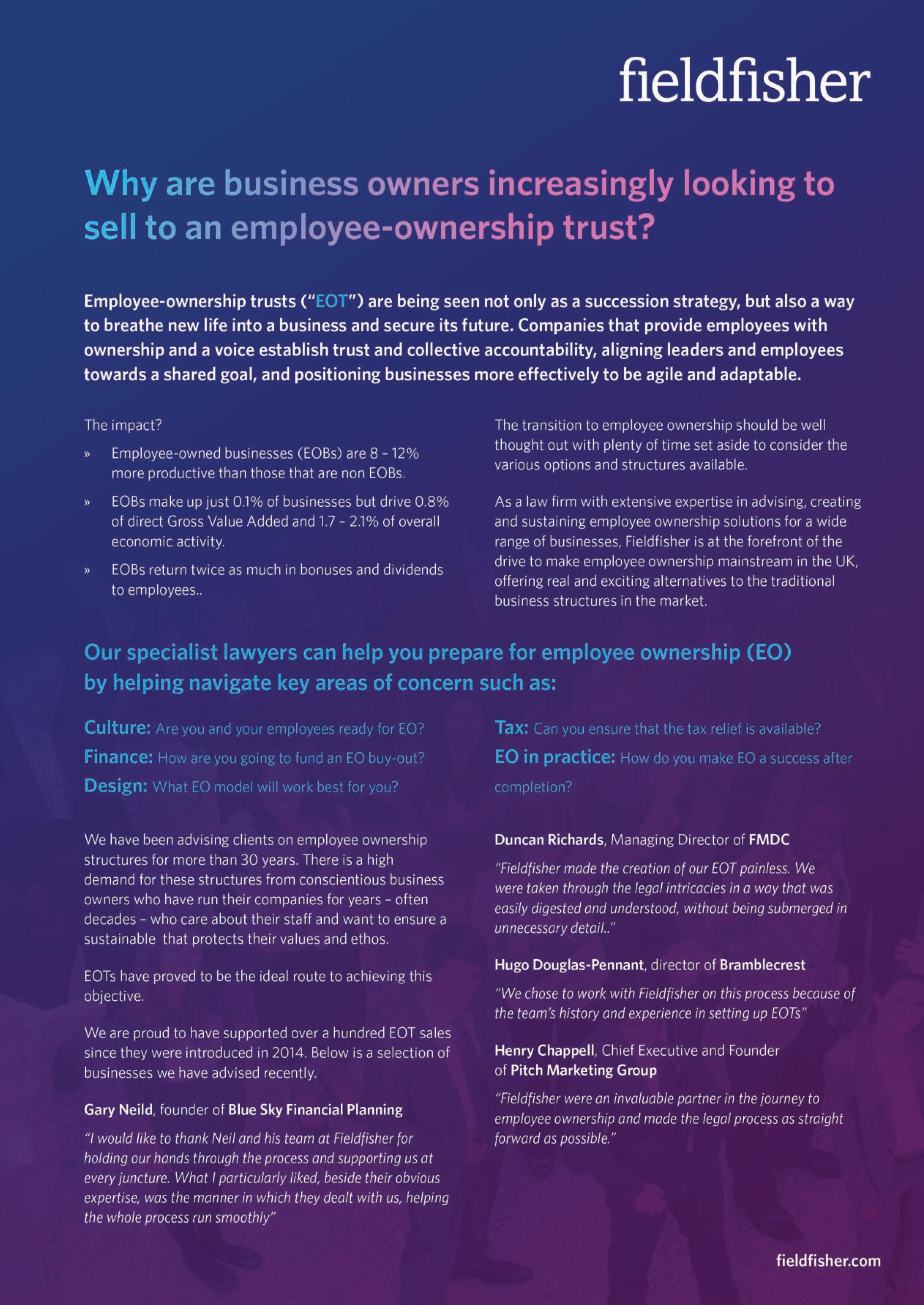
We highlight four companies in the south east that have successfully made the transition to
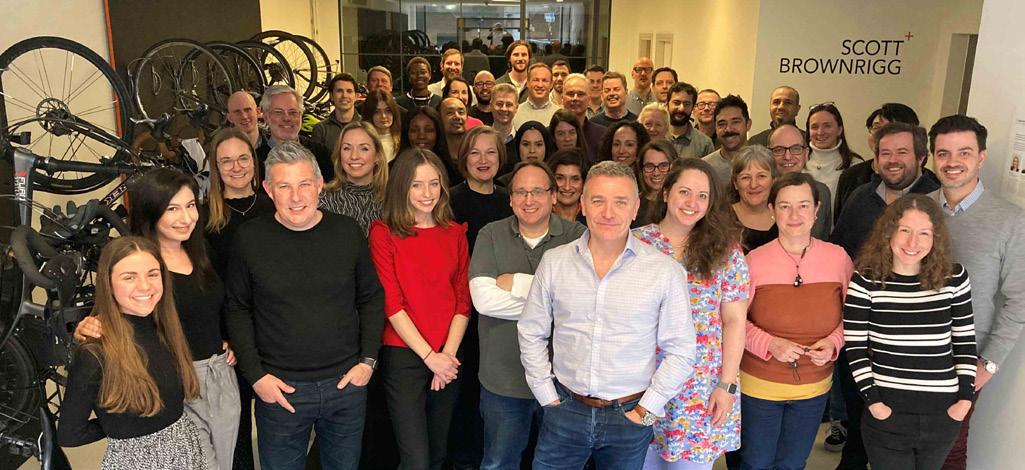 Scott Brownrigg, architects
Scott Brownrigg, architects
Scott Brownrigg is ranked in the World Architecture top 100 Architects in the world and has studios in Guildford, London, New York, Singapore, Amsterdam, Cardiff and Edinburgh.
Scott Brownrigg was founded 112 years ago and has evolved from a partnership, to a limited company, to a company partly held by an EBT (Employee Benefit Trust) in which shares in the company had been held on employees’ behalf since 1993, to its current form as an EOT.
Chief executive Darren Comber said the move will allow all employees to contribute to the company’s growth and will also mean they will have a say in succession planning.
“Providing a framework for effective career development and succession is one of the most challenging and important areas that any architectural practice faces in planning for the future,” he said.
“Ensuring there are opportunities for progression is fundamental to both individual satisfaction and the development of the practice.
“The decision to transition to an EOT was aligned with the desire to meet key components to be able to fulfil the drivers and ambitions of the business vision and strategy, support the next generation of ownership of the business.
“We want to provide the right platform for the business to succeed in the future and maintain and secure the legacy of Scott Brownrigg for future generations.”

Terence O’Rourke is a planning, design and environmental consultancy. It moved to an EOT model of ownership in February last year.
The firm, which has offices in Bournemouth, London and Birmingham works with landowners, developers, investors, promoters and companies on a variety of development projects.
Terence O’Rourke is a long-term advisory partner of McLaren and in 2016 secured outline planning consent for the McLaren Applied Technology Centre in Woking.
Founded in 1985, Terence O’Rourke has remained in private ownership for more than 36 years, however its board wanted to plan a succession strategy so began exploring EOT.
Terence O’Rourke’s Managing Director, Jacqueline Mulliner, said: “The EOT represents a fantastic legacy. All the current directors have been with the business for much of their careers and have appreciated the independence and support the company has been able to offer.
“Being able to secure these career opportunities for current and future staff is a significant moment in the firm’s history and progression. Before finalising the EOT we spoke to our staff and gained unanimous support for the approach.
“Transition to an EOT is something of which we are all very proud.”

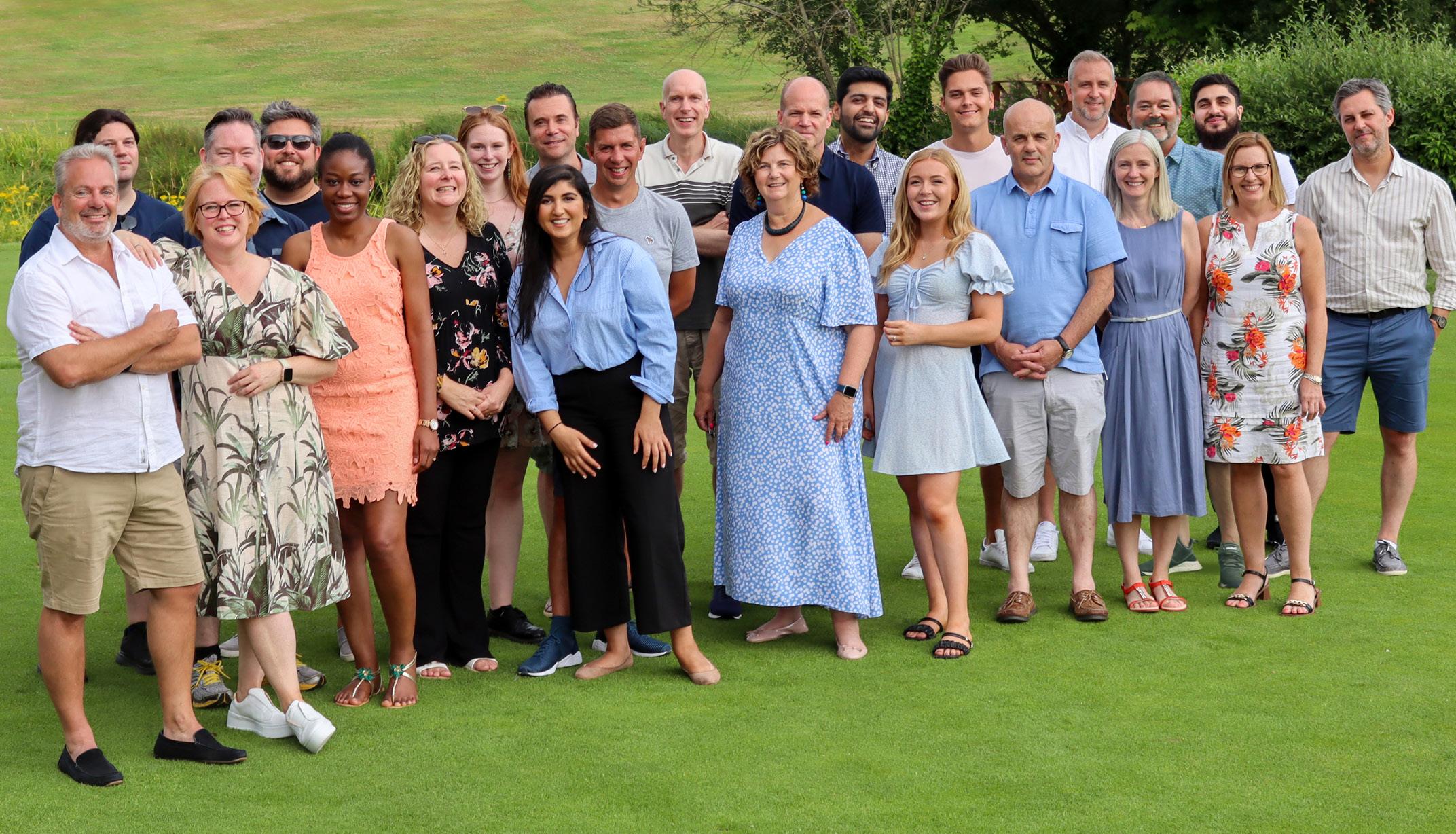
Thames Valley-based BCMS specialises in advising privately-owned businesses on company sale transactions.
The company announced last July that it is now majority owned by its employees under an EOT model.
The change in ownership came in a successful year for BCMS, which, among a number of notable transactions, advised on the sale of geological analysis company Geotek to AIM-listed Judges Scientific PLC.
BCMS has also posted its highest end-ofyear profits since 2016.
BMCS’s CEO, Jonathon Dunn, said: “Becoming an EOT allows us – as employees – to really drive and deliver our future success. We’re now all in this together, officially, as co-owners.
“The new structure engages colleagues across all roles, encourages an even greater sense of belonging and unity and allows every employee to benefit financially from our ongoing success.
We’re also expecting to attract new talent to join us as they seek to further their
careers and enjoy the numerous benefits of this approach.”
The Rebbettes family, founding shareholders of BCMS, who established the company in 1989 retain a large minority stake.
Dave, Steve and Brian Rebbettes said: “We’ve enjoyed seeing BCMS evolve under the current management team, and now is the perfect time for the whole staff base to literally take ownership of our future success and direction.
“It is exciting to see the business we started move on to the next chapter.”
He said: “Employee ownership preserves Napier’s culture and values. Employee ownership means there is a great reason for our talented team to stay with the company.
“The government is very supportive of employee ownership. So the bonuses paid by the Employee Ownership Trust are tax-free (up to a certain level). This makes it even more rewarding for the team.”
“Having the ownership through an EOT gives the team more opportunity to influence company strategy and direction. It also ensures that the company will remain independent.”


People-focused companies have a strong track record when it comes to Employee Ownership Trusts

Moderator: Stephen Emerson, Managing Editor, The Business Magazine
Robin Hay, Director at Bennett Hay
Keiron Richmond, Director at Darke & Taylor
Paul Howells, CEO of Eteach Group
Shaun Goodwin, Managing Director of Barton Fabrications
Neil Palmer, Partner at Fieldfisher
Alan Taylor, Senior Business Development Manager at Fieldfisher
John-Joe Cottam, Owner, Gardiner’s Homecare
Al Keck, CEO of Infinity Nation
Gary Ford, Director of Kendra Energy
Asil Zaidi, Engineer at London Bridge Associates Ltd
Andrew Hart, CEO of SBD Automotive
Harmeet Ahuja, CEO of Sun Mark Group
Paul Miller, Associate Director Shawbrook
John Palmer, Senior Director Shawbrook
A company’s culture is a key bellwether in predicting the success of an Employee Ownership Trust (EOT).
This was a key message delivered at The Business Magazine’s roundtable focused on Employee Ownership Trusts which was held at Easthampstead Park Hotel in Wokingham.
The event was attended by advisors from specialist bank Shawbrook, legal firm Fieldfisher alongside companies considering an EOT model and businesses that had already completed the move.
The EOT model works best with companies that had a “collegiate” culture according to Neil Palmer, a partner at Fieldfisher.
He said: “People-focused businesses, such as architects, tend to do well alongside those that have collaborative and collegiate cultures.
“There are certain businesses whose

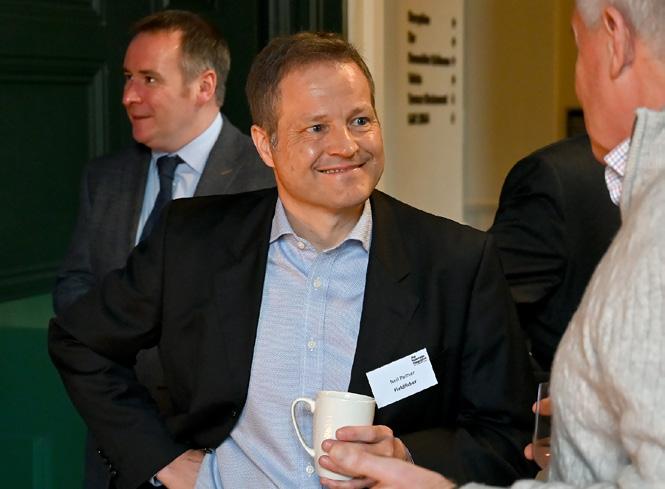
cultures might mean it may not work. But every business should at least consider the model, even if they ultimately decide it is not for them.”
Protecting a culture established in companies across generations was a key motivation for many roundtable participants when considering a move to an EOT.
John-Joe Cottam, owner of care provider Gardiner’s Homecare in Reading, said his family business had been built over five decades and that people were very much at the centre of the firm.
He said: “Staff already feel a sense of belonging and are proud to work with us.
“I feel this would only be strengthened by being employee-owned.
“Recruitment and retention is important in the care sector. Getting good people and keeping hold of them is key to the business.
“This is why employee ownership appeals to me.”
This was a point echoed by Robin Hay, Director of bespoke London-based caterer

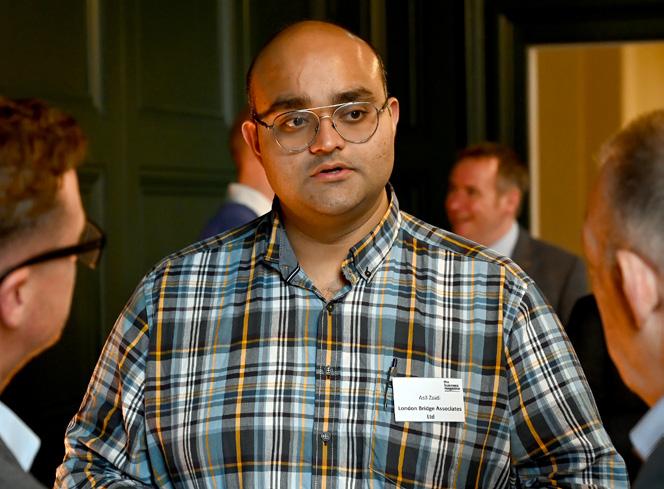
Bennett Hay, who said that his company’s culture was firmly rooted in its workforce.
“The culture is, first of all, based on the quality of the people you bring on board, he said.
“There are opportunities and channels for growth for those who stay at the company.
“I think our culture would continue under employee ownership.”
Asil Zaidi, an engineer at London Bridge Associates, whose company is employee owned, said the move had amplified the firm’s positive culture.
He said: “With an EOT there is more motivation for the workforce to perform well. The employees have added trust and therefore empowerment which is similar to working for a small business.
“All your employees suddenly become your sales force as well.
“You’ve got everybody involved with a stake in the business and they’re out there saying what your business does to everybody.”
Roundtable participants also felt an emotional
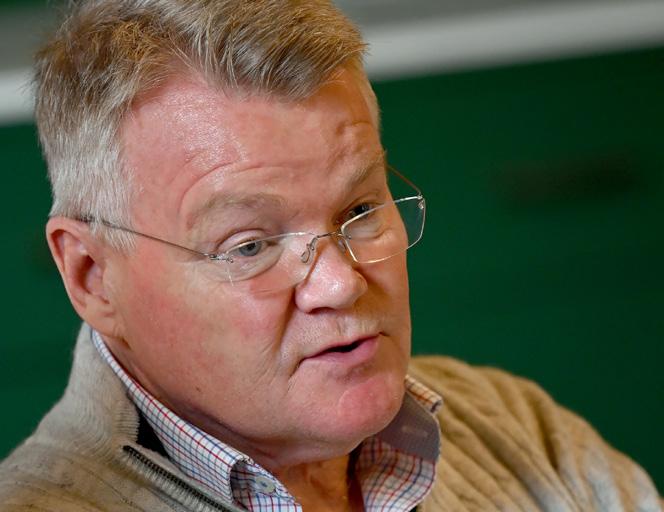

attachment to their firms and did not want to see them merged into a larger entity.
Shaun Goodwin, Managing Director of Bristol-based Barton Fabrications, completed an EOT three years ago having been brought in to run the company by its previous owners.
He said: “I had a concern about what would happen to the company if we went down a trade sale route.
“I looked into an EOT and spoke to the owners about it, and they were interested – especially due to the tax incentives.
“It has been fantastic for us. I have the freedom and control I wanted, and I have a team around me that are incentivised.”
Andrew Hart, CEO of Milton Keynes-based vehicle research firm SBD Automotive, echoed the point and said a move to employee ownership would help preserve the firm’s independence.
He said: “I want to keep SBD Automotive independent as I haven’t seen many good cases of companies being bought over in our sector and the value not being destroyed. I am really interested in EOTs as a route to keep us independent.”
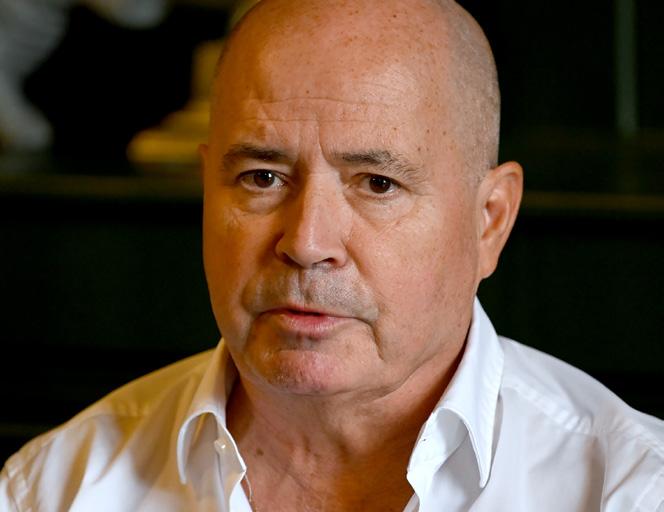


The roundtable heard how an EOT was suitable only for businesses consistently generating strong returns and should not be considered as a last option when efforts to secure a trade sale or private equity money had failed.
John Palmer, a senior director at Shawbrook, said: “A business needs to be able to stack up on its own merits. Is it generating a good level of sustainable profit? Does that profit provide consistently strong levels of cash flow? What is the strategy for the business going forward?”
This point was backed up by Neil Palmer of Fieldfisher who stressed the need for business owners to be confident in their cash flows as it was vital to them receiving their full earn-out.
He said: “EOTs are not an excuse to rescue a failing business. Banks will be looking at that and they will only lend to a good business. If you don’t get bank finance, you can go self-funded, however you have to be very confident about your cash flows. It is the profits of the business which will be used to pay you back.”
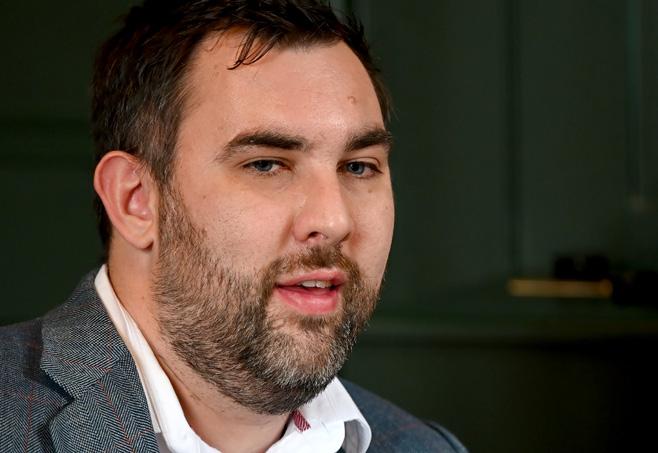
I call the management team the “bit in the middle” or the filling of an “EOT sandwich”. There is a lot of focus on the founders and employees but not on the management who are essential for carrying this through
The management team is a vital cog in any EOT as it is responsible for ensuring the company’s performance meets expected levels.
This, in turn, ensures that the founder receives their full earn out and (if applicable) that banking covenants are met. It is also important for management to help embed a culture of employee ownership and make it a real success.
Neil Palmer of Fieldfisher stressed the important role that the management team play in an EOT.
He said: “I call the management team the “bit in the middle” or the filling of an ‘EOT sandwich’. There is a lot of focus on the founders and employees but not on the management who are essential for carrying this through.
“The basic ingredients of an EOT deal is that there is a sale to a specially-formed trust, which pays the founder off over time out of the business’s profits. The EOT might get bank finance to help with this. The founder is paid in instalments (often called a vendor loan or deferred consideration) and takes a risk of not being paid in full, but as a quid pro quo, the founder gets the money tax free provided various statutory conditions are met.
“Once that is over, the profits are available for distribution just as with any other company. But instead of dividends being paid to the EOT as shareholder, they are normally released as bonuses paid to staff through PAYE.
“Management is crucial to making this process happen and they need to be incentivised throughout the process. Founders provide the energy when a business is established pre-EOT. There needs to be something to replace this energy post-EOT, and management can certainly help with this.”
John Palmer of Shawbrook said that incentivising management teams through share options is one good approach.
He added: “What we have seen happen on occasion are ownership structures where a large percentage of the shares are allocated to the trust and the remaining distributed to the key management team. You want to have key people in the management team tied in and committed to the long-term objectives of the business. One of the worst things to happen from a lender’s perspective is where a businesscritical decision-maker walks away.”
He also highlighted that a strong finance function was key when considering an EOT.
“You want to think about what your financials look like and what story they tell. The business needs a strong finance function with an experienced team and the data systems to deliver detailed analysis and reporting figures throughout the process.
John continued: “Another consideration is consulting the right advisors before embarking on an EOT. It helps to work with advisors that are experienced in this type of transaction and also understand your own business and sector.”

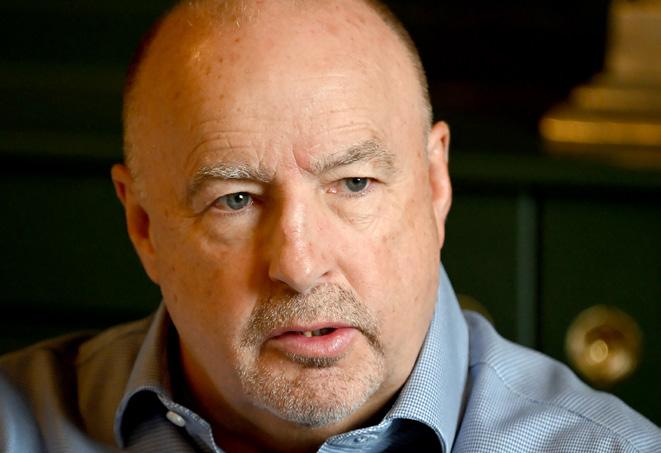
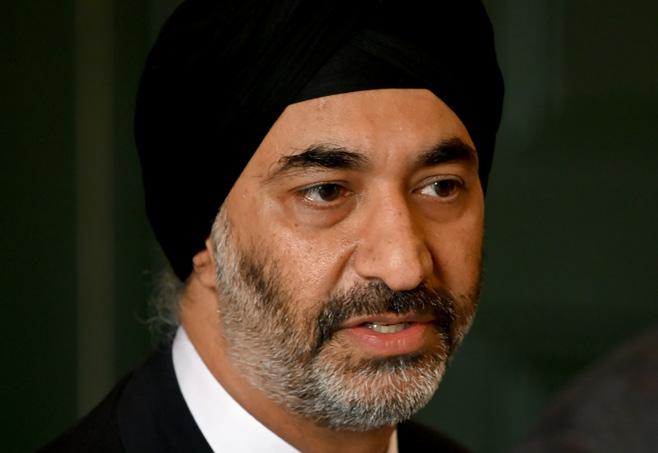
Paul Howells, CEO of Bracknellbased job board and ed-tech software business Eteach.com said he had begun succession planning with an EOT in mind and could see himself taking on a chairman/mentoring role once he had stepped down.
He said: “We have put together a new young management team and they are keen to take the business forward.
“My job is to make sure we have the right people in place. An EOT structure could work well for us as we evolve from what was a majority family-owned business.
“Our new MD is learning fast and has made a great start and our management team is building for the future and pivoting from a simple job board and recruitment offering to an industry-leading edtech provider.
“Our software and management tools for schools and colleges to hire staff saves them the time and money they desperately need.”
The tax-free consideration for a business may catch an owner’s eye initially, however those who sell a business into an EOT purely for tax purposes are unlikely to see a successful outcome in the long term.
John Palmer of Shawbrook said: “If someone says that they are entering an EOT primarily for tax purposes then it raises a red flag. What we see in successful EOT businesses is strong employee engagement and culture where
an EOT has been set up for the benefit of the employees.”
This point was also echoed by Neil Palmer of Fieldfisher who said moving to an EOT was a sign of faith and trust in your business to deliver a successful earn out.
“Some people get blinkered by the tax relief, but tax relief is only one of the many benefits of doing this”, he said.
“You take a credit risk until you are paid back and you are basically putting your money where your mouth is by saying I trust my business to be successful and to pay me back over a number of years.”
The roundtable also discussed the importance of communication and when to inform employees.
Shaun Goodwin of Barton Fabrications announced the company’s move to an EOT alongside issuing a Christmas bonus.
He said: “I chose to announce the move to EOT after it was completed as I didn’t want to scare my employees.
“There is a tax-free bonus incentive with EOTs so I was able to gather all the company together and say the old owners have decided to sell the business. I said ‘we are the new owners’, the only thing that changes is that you have an indirect stake in the business going forward.
“There are no new overlords. I’m staying here. I’m going to take care of you all.”
The successful creation of an EOT and lasting out of the earn-out period requires key elements to be in place, including a strong management team, cohesive culture and robust finance function.
Neil Palmer of Fieldfisher underlined this point. “Some people come to us with the business structure in place and say let’s go”, he said.
“Other people have been on a journey to get to the starting blocks. Others still need time to get the right structures in place. Every transaction is different, however you have to be a good business to do this.”
The roundtable heard from Harmeet Ahuja, CEO of Middlesex-based Sun Mark Group, about the Management Buyout (MBO) of the firm from a family business.
Harmeet says the company is now in the right position to consider a potential move to employee ownership.
He said: “One of the key drivers for the change to MBO was that there was a company culture which couldn’t sustain the level of growth which was possible.
“The family culture had served the company well and taken us to a really good place but it needed updating with new skills and capabilities.
“With the MBO came a professional management team which will drive the next stage of growth of the company.
“I’m now thinking who’s the most deserving to be in our journey over the next few of years, who deserves a piece of the pie?”
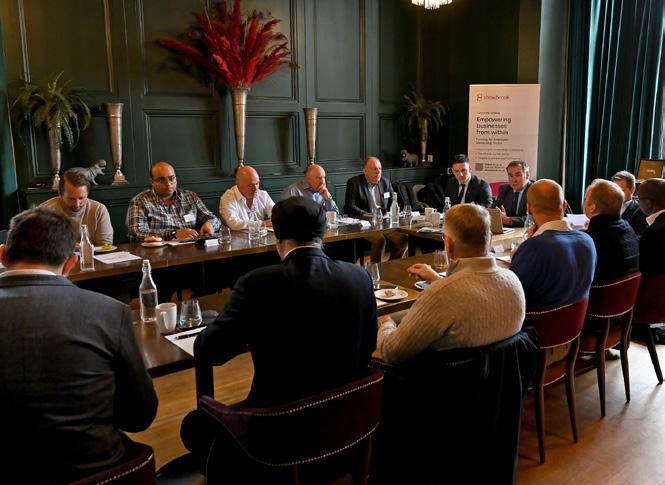



Moderator:
Stephen Emerson, Managing Editor, The Business Magazine
Neil Boxer, Managing Director, Airsys
Elaine Harding, Founder, AugmentAero
James Monk, Group Finance Director, BAP Pharma
Shaun Goodwin, Managing Director, Barton Fabrications
Gary Neild, CEO, Blue Sky Financial Planning
Edwin Bessant, Group CEO, Ceuta Group
Clare Miller, Finance Director, Cordell Health
Mark Gearing, Partner, Fieldfisher
Neil Palmer, Partner, Fieldfisher
Frances Miles, Director, Jobshop UK
Kim Sanders, Operations Director, Keytek Group
John Gurd, CEO, Market Measures
Nella Pang, Founder, Omega RE
Oliver Jenkins, Director, Shawbrook
Paul Miller, Associate Director, Shawbrook
Stuart Robertson, Managing Director, The Canopy Studio
Bill Bullen, CEO, Utilita Energy
An Employee Ownership Trust (EOT) can be a catalyst for positive change within a company through empowering employees to take charge and make a difference.
This was one of the key messages delivered at The Business Magazine’ s second Employee Ownership-focused roundtable held at the Harbour Hotel in Southampton and attended by business owners considering an EOT and those that had completed the process.
Advisers from law firm Fieldfisher and directors from specialist lender Shawbrook were on hand to answer participants’ questions.
Gary Neild, founder of Poole-based Blue Sky Financial Planning, transitioned his company to an EOT in December 2022 and will remain in post for five years to ensure a smooth handover.
“Employee Ownership is a catalyst for change which can be daunting, but done properly, of course, it can be really exciting.”
“It’s been interesting with the team because

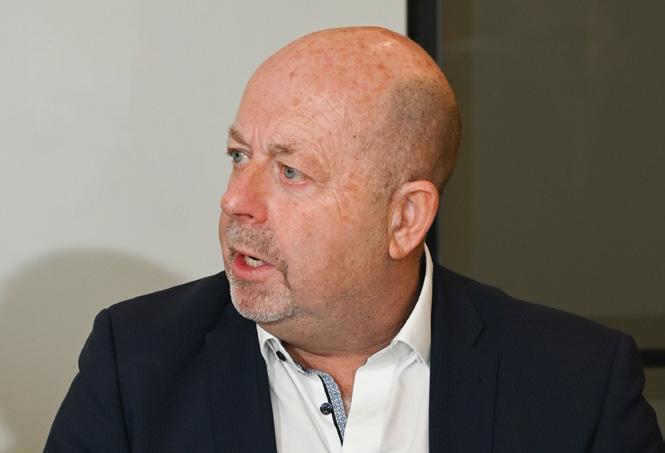 Gary Neild
Gary Neild
they are now indirect owners, although at the start, some were unsure as to what was expected from them.
“The key has been empowering them and it’s great seeing the progress they have made in their roles and in driving the company forward.
“Staff firmly believe in the ethos; they are proud to be part of something dynamic,” he added.
Other options for founders looking to exit their companies include selling to private equity (PE) or opting for a trade sale.
However, many founders around the table spoke passionately about the desire to protect their employees and the value that had been built up under their watch.
Managing Director of Bristol-based Barton Fabrications, Shaun Goodwin, said he had considered going down the PE route, however he had convinced the company’s owners that an EOT would be a better option.
He said: “I felt that if we were bought out by private equity there would be a threat to the culture.


“There is a ceiling to growth when you’re being spun up and chewed out by investment companies every four years. I didn’t want to work that way. That’s not for me. I wanted to grow the business organically and we’ve been doing very well at that.”
Gary Neild echoed Shaun’s point and said the fate of competitors who had opted for PE or a trade sale had convinced him to try a different route.
He said: “What was really important was to protect the legacy of the company and its strong relationships. Like a lot of companies, we looked competitors that had consolidated and felt that we just couldn’t do it”
“Particularly so because, as financial planners, we have strong in-depth relationships with our clients and believe we have a huge responsibility towards them.”
In preparation for the company’s move to employee ownership, Gary arranged for his employees to write a book which identified the company’s culture.
He said: “Every company has an HR folder, but nobody really looks at it unless something goes wrong or when they join the company at outset.
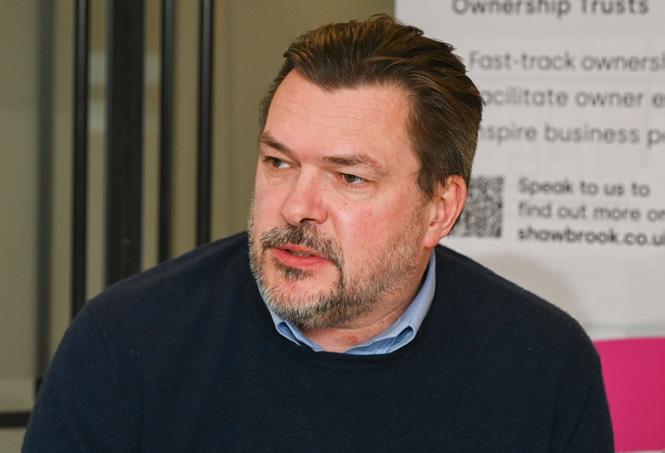
“I wanted something that resonated with the team on a day-by-day basis so I gave them the opportunity to highlight and reinforce the behaviours that binds us all together in the form of a ‘book of culture’. I had no part in the creation of this book, it was written by the team guided by our external HR consultant.”
CEO of Bournemouth-based Ceuta Group, Edwin Bessant, has worked with private equity companies throughout his time at the brand outsourcing firm and said that relationships were key if companies opted for this route.
He said: “With private equity, you have really got to know the person sitting opposite you at the table.
“You have really got to make sure that you like them and that the chemistry is good because you have to be partners, otherwise it will never work.
“There also has to be an alignment of ambition and purpose in your business and that of the investor.”
CEO of Eastleigh-based company Utilitia Bill Bullen, which employs more than 1,400 people in multiple locations, said that one of the draws of moving to an EOT was retaining staff, but questioned whether his organisation was too large for the model.
“Retaining staff is one of the attractions of an EOT for us,” he said. “We have a good company, good management team and already have some share incentives in place.”
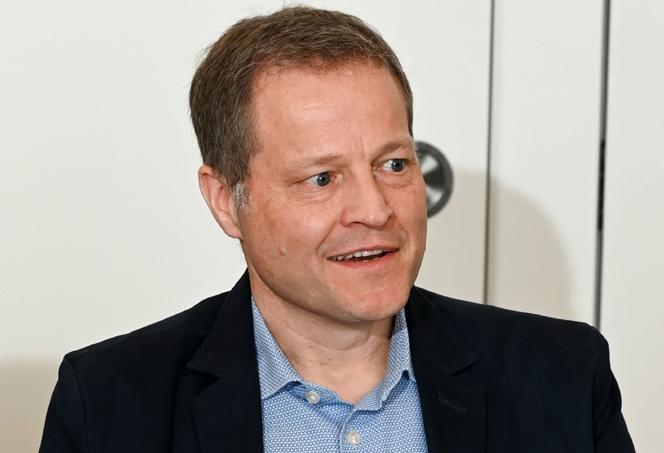

“Is there a point at which a company can be too big to do this?”
Neil Palmer, Partner at Fieldfisher, said converting a large enterprise to an EOT presented challenges but is not impossible.
“The bigger the company is, the more complex it is to structure the EOT and how the consideration is paid, he said.
“You have to think creatively and consider the financial aspects carefully to optimise how this can be done.
“We have been involved in very large EOT sales - it is a challenge selling at this level as you are looking at a significant sale price potentially, but with careful financial modelling this is achievable.”
The importance of culture was again a key conversation topic.
Oliver Jenkins, a director at Shawbrook, said culture played a big role in the continued success of the business.
He said: “Culture is fundamentally important in the transition to an EOT because you are reliant on the staff, who are now the owners, to deliver the plan for the business.
“You also have to consider the role of the founder and the impact of them leaving the business, in terms of impact on both the culture and performance of the business.
“The founder should gradually withdraw from the business and ensure that a strong management team is ready to replace them.”
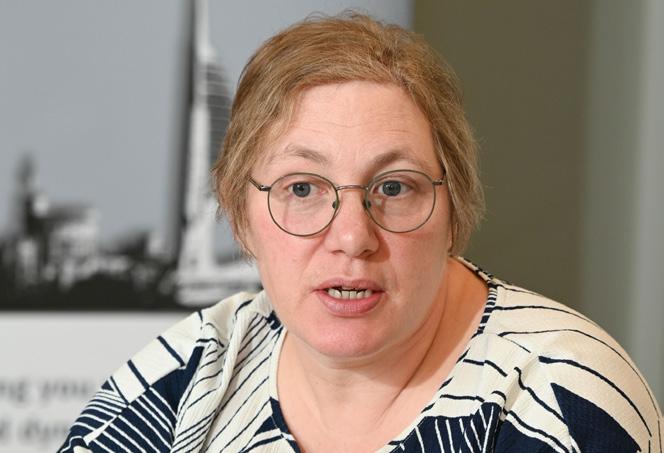


Culture is fundamentally important in the transition to an EOT because you are reliant on the staff, who are now the owners, to deliver the plan for the business
Clare Miller, Finance Director at Portsmouth-based Cordell Health, which delivers occupational health services, said that its founders were pivotal to the company and its culture.
The founders came from the military and when they left, they were quite disheartened by the corporate delivery of occupational health services. They therefore set up a social enterprise to deliver services in a different way.
“Given their role providing not only leadership but embedding the culture, if we were to go through an EOT, our founders are likely to stay in the business in some form for around 10 years, and then slowly phase out their involvement.”
John Gurd, CEO of Winchester research firm Market Measures is keen to protect the family firm and put in place a succession

strategy rewarding those that had helped to build up the company.
He said: “Market Measures was set up by my father 40 years ago and I have worked here for 20 years.
“I don’t think my sons want to take the business on, so we are looking into a sensible transition strategy that also benefits our loyal workforce.”
Frances Miles, Director of Poole-based Jobshop UK, had strived to develop an inclusive culture and would want to see it continue when she left the business.
She said: “Developing a good culture has always been important to me as is ensuring that the people who come into the business share these values. A good culture makes a massive difference to a company as people love going to work.
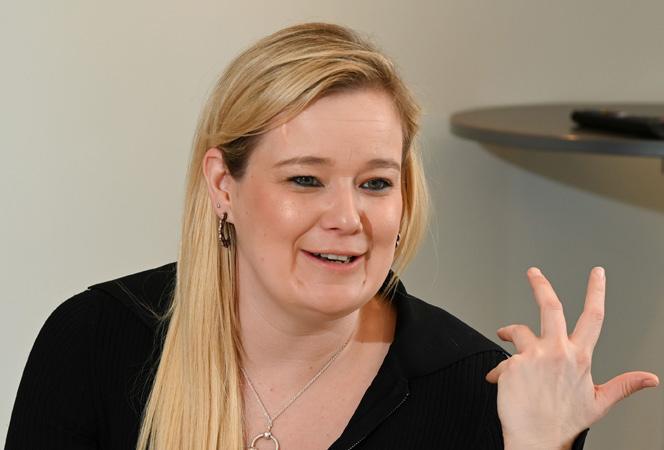

You need to decide how much you want to sell. If you are selling to an EOT, to make tax relief work, then you must sell a controlling interest
“Previously I had a restaurant business that developed a really good name. I came out of that business and then it was sold before folding very quickly. I would not want to see this happen to Jobshop.”
Nella Pang, Founder of Southampton property firm Omega RE, said employee ownership helps attract staff in a competitive marketplace. “Employee ownership also fits our business objectives as a B Corp – to put people over profit.”
The value of employee ownership in attracting staff was echoed by Elaine Harding of Hampshire aviation tech company AugmentAero. She said: “I am looking at employee ownership as a way of getting buy-in from my team so they can have some skin in the game. I am also interested in share options for some members of my team.”
The importance of a strong finance function was again highlighted in the Solent discussion.
Paul Miller, Associate Director at Shawbrook pointed out that moving to an


EOT may be the first time that the company has taken on debt.
He said: “Some businesses transitioning to an EOT may never have had debt before, and with that debt comes financial reporting requirements to the lender. If the finance director has experience of dealing with bank debt and the associated financial reporting, that always helps.
“You need to make sure that your reporting is not just a set of numbers produced each month, but are used as a tool to monitor prior performance and forecast ahead. We look at a combination of P&Ls, balance sheets and cash flow statements, especially where we are providing cash flow. The cash flow generation of a business is very important, including how it is performing against budget and what the future business performance looks like.”
One benefit of an EOT is flexibility when it comes to equity in the business. A founder can retain a stake in the company and allocate shares to team members.
Mark Gearing, a Partner at Fieldfisher explained this meant key employees could benefit directly from a future company sale, even if that may not be envisaged when the EOT is established.
He said: “You need to decide how much you want to sell. If you are selling to an EOT, then you have to sell a controlling interest if you want to claim the tax relief. The minimum that can be sold for the tax relief to be available is 50.1 per cent, so there is a lot of variation in what you can sell. You could sell a higher percentage to the Trust and hold a minority stake so you

can get protective rights and share in the capital growth.”
Neil Boxer, Managing Director at Romsey-based communications company Airsys, said his business was based on relationships. A move to employee ownership would help with this.
He said: “We have had relationships with many suppliers and customers since we were founded 31 years ago. Many have gone through changes of ownership themselves.”
Roundtable participants quizzed advisers on how an EOT trust would work. The trust will effectively own the business after an EOT and represent the interest of the employees.
Oliver Jenkins said Shawbrook closely scrutinised the make up of the trust board before lending and took a more negative view of those made up of too many vendor representatives.
He said: “As a funder, we expect to see professional trustees on the board who are independent of the day-to-day activity of the business, while also acting independently for the employees. The professional trustee will not obtain an advantage out of being on the board and can focus on the objectives of their role to ensure they fulfil certain requirements.”
Mark Gearing added that typically, as a minimum, an EOT’s trustees comprise one founder seller, an employee and an independent. He expects new legislation this year that will prohibit founders from comprising a majority on the trust board. Marks feels this is a welcome development of the EOT regime.”



Having been the sole manufacturer of Sterling banknotes for more than 20 years, De La Rue has lately been working with the Bank of England to introduce new designs featuring King Charles III.
From June 5, the new polymer banknotes are set to circulate alongside those featuring the late Queen Elizabeth II, which will remain legal tender.
As before, the notes are printed on De La Rue’s durable SAFEGUARD polymer substrate.
And while they’ll still feature the likenesses of Winston Churchill, Jane Austen and Alan Turing, these figures will be joined by His Majesty on the front and in the see-through security window of each note.
A series of charity auctions will be held over the summer at Spink & Son of lowserial numbered notes, with proceeds going towards charity.
Headquartered in Basingstoke but with global operations, De La Rue has also issued new banknote designs recently in Samoa, Macau and the UAE.

The last MINI Clubman has rolled off the production line at MINI Plant Oxford.
Since its introduction back in 1969, more than 1.1 million Clubman cars have been built – half of them at the Oxford plant.
The model went on hiatus in the late Seventies after a busy decade, but was updated in 2007 while retaining the characteristic style of its predecessors –most notably, the signature split rear doors.
In 2013 came the Morris Mini Van-inspired MINI Clubvan, while last year saw the launch of The Final Edition to give the model a proper send-off.
Now the carmaker is turning its attention to electric vehicles, with a new all-electric MINI Cooper and MINI Countryman both making their debut this year.
Dr Markus Grüneisl, CEO of the Oxford and Swindon MINI plants, said: “We’re incredibly proud to have built the MINI Clubman at Plants Oxford and Swindon over the last 18 years for customers all over the world.
“With its departure, we welcome members of the new MINI family to our Oxford and Swindon lines, including a new convertible model which we’ll start to produce at the end of this year.”
A new MOD contract worth £135 million is set to equip the Royal Navy with new decoy launchers to counter missile and drone threats.
Picking up the contract are Systems Engineering & Assessment Ltd (SEA) in North Devon, which has partnered with Chess Dynamics in West Sussex. Both are part of Reading-based Cohort plc.
Together they’ll provide trainable decoy launcher technology which can be operated without the need to alter
course, sustaining up to 150 jobs across the South Coast in the process.
James Cartlidge, minister for defence procurement, said: “In a time of global instability, it’s vital we protect the Royal Navy in the best possible way to ensure national security.
“With recent attacks towards HMS Diamond and HMS Richmond in the Red Sea, it’s crucial our sailors have the latest technology to best defend themselves and the fleet.
“The new technology is an improvement on speed and agility and highlights more excellent work from UK companies in backing UK defence.”
The contract will see Type 26 and Type 31 frigates, as well as Type 45 destroyers, fitted with a new launcher system.
It fires a range of countermeasures, including chaff, flares and ‘corner reflector’ rounds to target hostile missiles.
Lead quality engineer Guy Elliott with the MINI Clubman
Understanding businesses and building strong relationships have never been more important according to Paragon Bank’s John Phillipou
By Stephen Emerson, managing editorIf a farmer’s gate was held together with string, then you wouldn’t lend money because if they couldn’t take pride in their gate, then they are not going to take pride in their loan and their equipment
You can tell a lot about how well a business is run by the small details of its operations, according to John Phillipou, who has made a career of backing winners when it comes to lending.
John, who lives in Fleet in Hampshire, is Managing Director of SME Lending at Paragon Bank.
However the road to his current role began navigating rural farm roads in Hampshire and Dorset in the Nineties –long before the smartphone era.
His role then was for JCB Finance, selling lease agreements for tractors and other equipment to farmers.
“It’s the tiny observational things that build up a picture of how businesses are set up,” he said.
“If a farmer’s gate was held together with string, then you wouldn’t lend money because if they couldn’t take pride in their gate, then they are not going to take pride in their loan and their equipment.
“If I arrived at a printing company, and it’s a new business looking for a first investment loan, but the two directors have gone out, bought Porsches and they are sitting with their feet on the desk, then you know that it is going to go wrong.”
John’s first introduction to the South Coast came when he studied economics at the University of Portsmouth, where he met his wife, who was studying pharmacy.
The Cardiff native, who has two grown-up children, has spent much of his career in lending and leasing, working his way up from an administration role at the Bank of Scotland.
Leadership roles at JCB Finance, Citi

Deutsche Leasing
His big step up the ladder came when he visited an Irish customer in Cosham, Hampshire.
“This was a customer that would eat sales reps for breakfast and he was known for being a tough negotiator,” he said.
“I went in there as this upstart 24-year-old, he was quite feisty but I stood my ground. He was buying 10 JCBs and JCB finance had never lost a deal on a new JCB.
“They funded everyone who wanted a JCB, however this young upstart working for the Bank of Scotland branch in Portsmouth took a quarter of a millionpound deal off JCB Finance.
“Two weeks later they (JCB) recruited me.” John spends at least two days a week at Paragon Bank’s office in Eastleigh, which overlooks Southampton Airport, and where its asset lending division is based.
The rest of the week is spent at the London office, travelling to meet customers and managing Paragon’s subsidiary leasing companies which include Iceberg in Poole and Specialist Fleet Services in Northampton.
He said: “I tend to be out and about more than I was before the pandemic and I rarely work from home.
“I’m very conscious that there is value in interaction with staff and they like to hear and see that their manager is involved in the business.”
John is very much a believer in the values of traditional banking and its emphasis on relationships. This people-centric approach was instilled early on in his career.
He said: “One thing I learned very early on was that if you believed in a customer who was buying their first machine and you backed them then you would have them as a customer forever.
“They will remember that you were the one that helped to get them started.”
John says that this loyalty is even more valued by companies in today’s economy.
He said: “It is quite challenging for businesses at the minute, and you have got to help companies through it.
“We are quite a traditional bank, we are not fairweather friends and we get to know our customers.
“If people go looking, they can probably find a cheaper deal, but those banks might not be interested in them in a couple of years when things aren’t going so well.”
You have to understand a lot of different industries
John says it is the variety of the role that has kept him in the industry for three decades, while he also holds the position of Chair at the Finance & Leasing Association.
He said: “What I love about my role is that you have to understand a lot of different industries.
“You have to be a bit of a chameleon. If I am talking to a construction customer, I am visualising myself in steel toe cap boots, then the next minute I could be speaking to a FTSE 250 financial director, and I then have to get into a different frame of mind.”
“You have to understand the dynamic of the business you are meeting and how they operate.”
Understanding the businesses you are working with also allows you to spot opportunities, and John points to a deal struck during the time he was financing cranes used to build Terminal 5 at Heathrow while working for Citi Group.
He said: “I had financed flat top cranes used in the development of airports for Heathrow.
“It was a very niche asset and no bank
You have to be a bit of a chameleon. If I am talking to a construction customer, I am visualising myself in steel toe cap boots, then the next minute I could be speaking to a FTSE 250 financial director, and I then have to get into a different frame of mind

wanted to touch it. What would you do with them after the project finished?”
“I structured the deal and completed.
“However, I also joined the dots and realised that those same cranes could go to the next big airport project globally, which was in the Emirates and due to start three years after the Heathrow project.
“I had never done international business before, but I contacted the Arab conglomerate behind the build to see if they wanted the cranes and they agreed to go ahead.”
John has overseen significant growth in lending to SME customers since 2019, with the bank lending more than £447.9 million in its last financial year. This increase, John says, is down to having
the right people on board and being focused on the right markets.
He said: “When I came in, there were lots and lots of different companies that had been bought and they needed to be pulled together.
“The reason for growth is that we have got the right people in the right place and the right roles.
“You have to focus on the right areas of the market because asset finance is a little bit counter-cyclical.
“There are a lot of headlines about low growth rates in the UK economy. However in many of the markets we serve, we are just carrying on but with heads-up awareness.
“There’s a plethora of equipment that, regardless of the state of the economy, will wear out and need replacing.”


Small but mighty; how a local law firm in Surrey is paving the way for the legal industry to do better
If you think of a law firm, or even the legal industry in general, what first comes to mind? If your thoughts instantly take you to long processes, slow replies, incomprehensible jargon, exorbitant fees and unfriendly faces, Hartley Law is on a mission to change that impression.
In a bid to create a unique experience for their clients, Hartley Law is not only providing fast, affordable legal support, with unbeatable responsiveness and 24/7 availability, but the firm has set out to be a good business and make a real difference by giving back.
Nowadays, it’s not enough to get the job done. Clients look for service providers that will put them first, offering a personable approach and a friendly hand to guide them along the way. Gone are the

days when clients are merely an invoice to cash in at the end of the month.
Hartley Law does things differently. If you call the firm’s office, you’ll be greeted by the CEO herself, Karenjit Dhaliwal, founder of the company. Priding herself not only on her extensive expertise but on her ability to build real relationships with her clients; every interaction reflects her compassionate and approachable demeanour.
The firm is steadfast in its approach; quality over quantity – every time. Working


with a variety of clients that span from luxury retailers and household names to startups and independent businesses, the team takes the time to build and nurture lasting relationships founded on trust and compassion, no matter the size of the business. It’s not about numbers or high-profile clients, but rather ensuring a individuals walk away feeling heard, understood and valued. Clients sit at the very heart of Hartley Law, its growing reputation evident through the everincreasing, outstanding reviews.
The team is also available to assist in-

house legal teams whether in-between recruitment gaps or to help clear a heavy workload.
Hartley Law is available 24/7. Having worked in businesses instructing law firms where the responsiveness of external lawyers was often overlooked, this was a priority for Karen from the very inception of the firm. Understanding that urgent, last-minute requests and unforeseen deadlines can often creep up on business owners, the firm works around the clock to ensure pressing needs are addressed no matter the day of the week or time of day. Peace of mind is prioritised and projects are moved forward swiftly, with the team informing clients of the progress made throughout.
Hartley Law is also changing the way clients interact with the law. Understanding that legal terminology and jargon can be confusing and even frustrating at times; the team simplifies the process and the use of language entirely. Empowering clients to make informed decisions and ask the right questions should they need to, is key.
Karen and her team provide practical advice, thinking beyond the legal realm of each individual project and devising a hands-on, real-world approach. Paired with wider support and guidance to fit individual needs.
You would be wrong to think this level of service comes with a hefty price tag, The firm is committed to making services affordable, as part of its ethos
of accessibility, ensuring everyone can access exceptional legal services without financial barriers. Value for money is about helping others, and recognising reasonable pricing can not only help smaller firms grow, but also ensure they too have access to invaluable legal support when they need it.
On a mission to do good, Hartley Law is embracing its commitment to making a positive imprint in society, prioritising the well-being of its employees, and ensuring environmental sustainability.
Hartley Law provides pro bono legal services, actively collaborates and contributes to local and national charities, has embedded a number of sustainable principles across its operations and works closely with local colleges, taking part in career fairs and work experience opportunities to nurture the next generation of talent.
Although the firm is proud to be making great strides in giving back, Karen and her team are continuously searching for ways to do more and do better –understanding that being a good business is never a tickbox activity.
Hartley Law recently became B Corp certified, which means that the firm is part of a global community of businesses
that meet high standards of social and environmental impact, leading a global movement for an inclusive, equitable, and regenerative economy.
Becoming a certified B Corporation is no easy feat. It includes undergoing a rigorous impact assessment that sets out to measure a variety of factors in areas such as governance, workers, community, customers and the environment.
The legal world is often considered to be an industry where profit is typically prioritised over other important factors, and the numbers speak for themselves.
With a total of 17 law firms officially certified by B Lab in the UK out of a total of 11,500 registered law firms in 2024, Hartley Law is pleased to be among the few to commit to doing better.
Hartley Law recognises the role law firms play in shaping society and believes that with power comes responsibility –becoming a B Corp being a first big step towards aligning business practices with the firm’s values.
Karen is eager to inspire others to join the movement, sharing Hartley Law’s experience and encouraging business service providers in working towards the common goal of doing good.
In today’s legal landscape, clients are now seeking businesses that prioritise exceptional client care, understand their concerns, and align with their values –offering exceptional support throughout. But that’s not all, clients increasingly choose firms that not only excel in legal services but also give back to the community and uphold ethical practices. At the intersection of exceptional service and social responsibility, lies the key to forging lasting client relationships.
Hartley Law is bridging this gap by providing unmatched legal support without overlooking the ever-growing number of additional factors businesses nowadays should strive to encompass within their operations and ethos. It is challenging the status quo and truly making a positive difference that benefits both clients, and the society we live in.
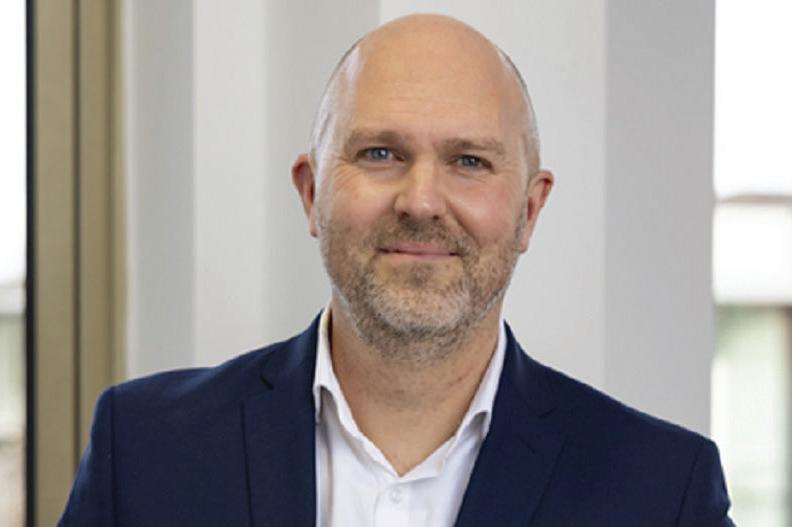
01 EV charging network Instavolt make CCO appointment
Basingstoke-based InstaVolt, the firm behind one of Europe’s largest rapid EV charging networks, has appointed Simon Smith as Chief Commercial Officer. Simon brings more than 20 years’ experience in senior leadership roles, including most recently with eEnergy Group, where he headed up the energy efficiency division.
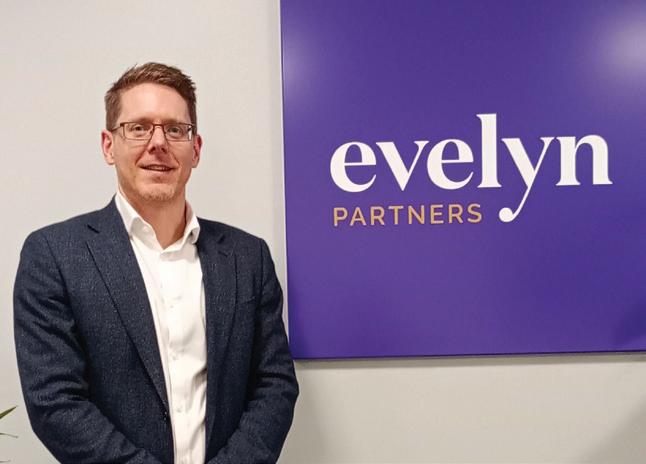
02 Evelyn Partners makes Surrey push
Certified financial planner Reinoud Noorduijn has joined the Guildford offices of Evelyn Partners as the group looks to grow its Surrey client base. Reinoud joins from Sheraton Financial Planning in Fareham, where he spent more than two years as an associate financial planner.

03 Ryan steps up to MD at Transense Technologies
Transense Technologies, the Bicesterbased provider of specialist sensor technology and measurement systems, has appointed Ryan Maughan as MD. Ryan joined the board at Transense as part-time business development director in 2021. He now steps up as full-time MD with additional responsibilities covering business development, engineering and operational activities for the company.

04 From Fork to Farm for Will
Vertical farm innovator GrowUp Farms has hired ex-Ella’s Kitchen boss Will Howard as UK MD and CCO. Previously managing director of baby food brand Ella’s Kitchen, Will arrived at the Sandwich-based business in February. He’s also held roles at Innocent Drinks, Red Bull and PepsiCo.

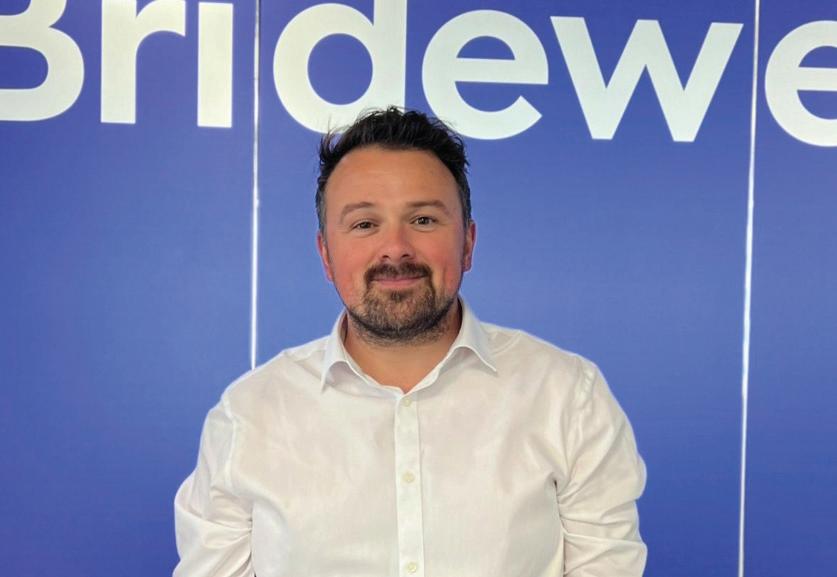
05 Bridewell looks to expand into new markets with new CCO
Reading cybersecurity firm Bridewell has appointed Ben Vaughan as Chief Commercial Officer to help the firm expand into new markets. Ben’s career spans senior sales, marketing and general management roles in cybersecurity across the UK, US and Western Europe.

06 Liquid Link appoints Head of Commercial Development
Liquid Link, the financial division of Portsmouth-based Liquid Friday group, has appointed Bobbie Knight to help expand its portfolio of supporting the growth of recruitment companies by improving cashflow solutions.

07
Hampshire Chamber makes non-exec appointment
Donna Jones, police and crime commissioner for Hampshire and the Isle of Wight, has joined the board of Hampshire Chamber of Commerce as non-executive director. She’s set to work alongside chief executive Ross McNally, president Peter Taylor, and her fellow directors in shaping the chamber’s strategic growth over the coming years. Born in Portsmouth, Donna worked in banking and investment management before her election to Portsmouth City Council in 2008, where she served as executive leader from 2014 to 2018.
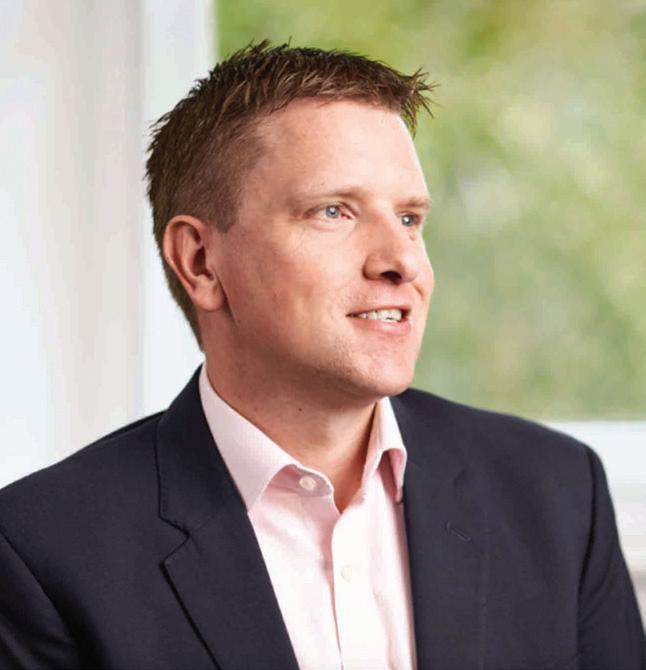
08 YFM make senior appointment
Jamie Roberts has been appointed Chief Investment Officer at YFM Equity Partners responsible for all the private equity house’s UK activity. Jamie has been with YFM, which has offices in Reading, for close to 12 years and was previously at Lloyds Bank where he worked in acquisition finance.

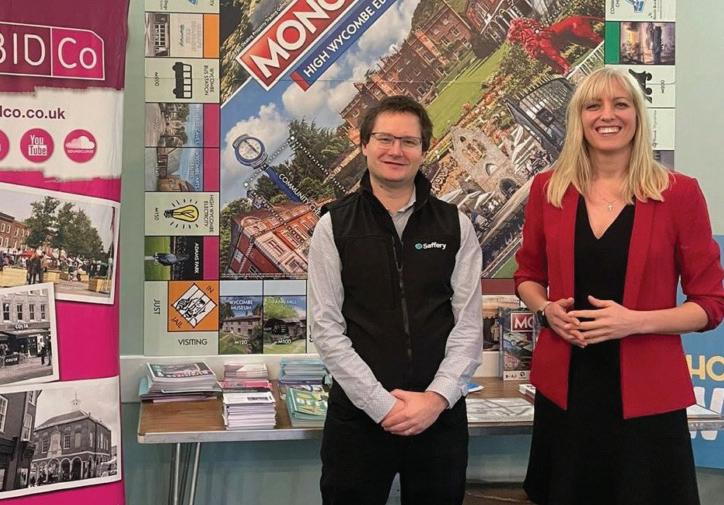
09
High
Luke Hanratty, Audit Director at Saffery in High Wycombe, has been appointed Vice-Chair of High Wycombe Business Improvement District Company after joining the organisation’s governance board just over 12 months ago. Luke’s key responsibility is to ensure oversight of the responsible spending of the BID’s income worth more than £1.8 million, for the benefit of 700 businesses operating within High Wycombe’s town centre.

Merlin Entertainments has appointed Karim Hajjar as CFO to spearhead the Dorset company’s financial and investment strategy. Karim will report to CEO Scott O’Neil and work to drive growth across Merlin’s international brand portfolio.
He brings more than 30 years’ financial experience, including in the energy, resources and chemicals industries –most recently with Solvay, where he spearheaded record financial performance for the Belgian firm.
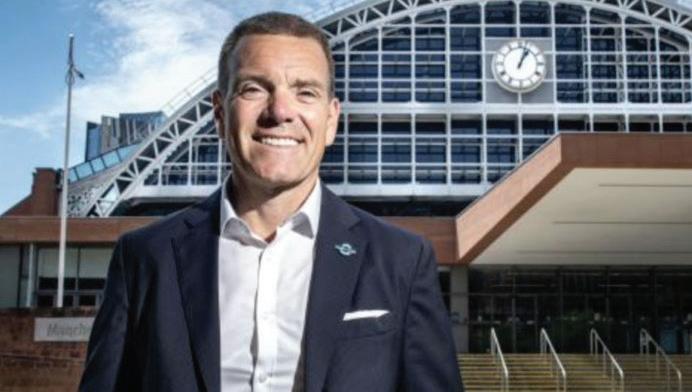
New CEO rides into Newbury
Shaun Hinds has been appointed as the new Chief Executive of Newbury Racecourse and will take up the role in June. Shaun is currently CEO at Manchester Central, an award-winning venue in the centre of the city.
Prior to joining Manchester Central, he led international operations at BridgeStreet Global Hospitality and has more than 25 years’ experience working across hospitality, property and business service sectors.
Law firm Gardner Leader, has appointed specialist employment solicitor and senior associate, Vicky Schollar, as its new Head of Employment, bringing with her more than 20 years of experience. Vicky has held positions at Blandy and Blandy and Blake Morgan LLP, where she spent more than 15 years.


An acquaintance of mine once told me of his frustrations with his former company’s HR department, whose guidelines restricted his ability to phrase job adverts as he wished. A new law regarding ageism meant he could not give a minimum age for the role of commercial manager. Some editing and creative licence was required, and he managed to get away with “… it is unlikely that anyone below 35 will have reached the required level of cynicism for this role…”. Mark Wheeler, CEO of Diales takes at look at the role of cynicism in major projects.
Some cynicism can be a healthy thing. It comes with experience. It makes you want to test things, not take them at face value. Qualifications in cynicism are freely available from both the school of hard knocks and the University of Life. I have been fortunate enough to work on some of the world’s largest projects in recent years, and I have seen all kinds of new technologies deployed and a wide range of management styles and techniques employed. When I have seen these projects as an independent expert, in the context of a dispute, I almost always find very significant, often shocking, deficiencies in the records and documents.
It is not uncommon to find a 3D or 4D model that contains missing data, BIM that has not been set up correctly and has gaps in its data, and progress records on file that contradict the Primavera programmes in significant ways. I have seen both drawings extracted from models that are undated and without a revision reference, and drawings dated later than earlier drawings, but with far less detail on them and no record of any change. Data often conflicts between systems and sometimes even within the same system. The projects that have these issues are not being run by small companies, or those without good reputations. These issues exist on major projects run by some of the world’s leading contractors and consultancies.
So, what makes keeping construction data complete, accurate, and up to date such a challenge; and what can we do about it?
The first thing to do, is to accept that the data will come in many different formats, and that there will always be compatibility issues.
This is where there is a need for experienced construction professionals to work with top IT experts, to ensure that the requirements are clear and the integration requirements are identified for the IT team to assess and derive a solution.
There also needs to be a robust end-to-end test of the systems that have been installed, to ensure that they work, and an ongoing audit to ensure they will continue to work as intended. This is where cynicism comes into play – as the quality check. Cynicism will assume that the systems don’t work, and aren’t complete, until proven otherwise. Then you should check again, and again once more. If you change the systems, you need to do the checking again.

I have advised on record keeping and software a few times and I usually suggest a four-stage approach.
Setting out a briefing document which details what will be recorded and created, by whom, and in what format, what connectivity is required, and what will be the overall architecture for storage, retrieval, and reporting. This can be an involved process, but there is nothing more frustrating than a beautiful dashboard, that is obviously wrong. The types of software and file formats will need to be reviewed and analysed. One particularly useful strategy can be to create a data archive, which acts as a Single Source of Truth. This is then connected to all of the systems, rather than attempting to constantly translate formats directly between software.
This process should be straight forward from a well-defined brief, especially if you are using standard industry software packages. There really is no need to re-invent the wheel as all of this already exists, from record gathering apps to data storage and archiving, programme software to design suites. The real challenge is making it work together. Properly.
STAGE
This is the place for the cynics. Check it all, check it twice, then check it again based on real time tests, with real data input. I have been told more than once how time entry works, only to insist on being shown it there and then, and watching it fail at every entry. Only when fully signed off by the stakeholders can you progress to the next phase.
Operation is going to depend on the training of the operatives. Many problems are rooted in a lack of training and are often termed as ‘PICNIC’ problems. This acronym is used by computer experts to describe user issues. ‘Problem In Chair Not In Computer’.
Things change, software is upgraded, people leave or retire and are replaced, so make sure you get your cynics back once a month to ask some tough questions and verify that you are still working at the desired level of accuracy.
On any project, record keeping, document control, and the integration of software systems is important. Critically important. Cynical checking is therefore required, and on mega projects, mega-cynicism is needed and on giga projects, well you can guess, so get in touch – mark.wheeler@diales.com
 Mark Wheeler, CEO of Diales
Mark Wheeler, CEO of Diales

The University for the Creative Arts (UCA) in Surrey is leading a new initiative to support the region’s thriving regional games development cluster.
PixelRise will raise industry standards, help establish new studios and develop talent.
Surrey County Council’s Cllr Matt Furniss, cabinet member for highways, transport and economic growth at Surrey County Council: “We need to recognise that strategic collaboration is critical for all of us to work together to develop the talent that we need in this industry.
“That’s why we collaborated with UCA to commission a report to understand the barriers and opportunities to our local games cluster and how we can attract that growth in the area.
“We’ve seen a huge amount of grant income coming into the county, particularly
“We’ve seen a huge amount of grant income coming into the county, particularly in the crea-tech sector, so it’s a truly exciting time for Surrey’s games industry”
in the crea-tech sector, so it’s a truly exciting time for Surrey’s games industry.”
The report, compiled by Steve Cuss of The Game Plan Consultancy, highlights the potential of Surrey’s games cluster.
Surrey is home to more than 60 game studios which are responsible for some of the most iconic characters and more than 4,000 games. Companies such as EA Games, Ubisoft and Supermassive Games have made the county a hotspot for the gaming sector.
Steve said: “If we look at the priorities of games developers in the region and the commercial environment, what we need is an initiative that unites and unlocks this potential across a diverse range of stakeholders.
“We believe that PixelRise provides this strategic solution, fostering an environment to address the challenges of the industry and take advantage of the massive potential in the cluster.”

The initiative comes as part of the Games and Innovation Nexus (GAIN) project, which saw UCA and the universities of Surrey and Warwick secure £1.5 million funding from Research England.
Surrey County Council has also committed a further £240,000.
A portion of that funding will be made available via “innovation vouchers” to game developers, studios or those looking to start a career in the industry.
“We’ll be opening a call for people to apply for innovation vouchers,” said Sophy Smith, director of the School of Games & Creative Technology at UCA.
“Along with that, applicants will have access to our resources, VICON motion capture, virtual production facilities and research expertise throughout the university.”

is hoping to move up the career ladder with Kent-based homebuilder Vistry Group after her potential was spotted while she was working on site as a cleaner.
The 30-year-old from Southampton applied for the job of welfare cleaner with Taurus cleaning at Vistry’s Boorley Green in Botley near Southampton in 2020.
Just a year later, having asked to start labouring alongside her cleaning work, she caught the attention of managers, and was offered the chance to train as an assistant site manager.
She said: “I put down my toilet brush on the Friday and picked up a laptop on the Monday.”
This summer Gemma will have been training for three years, and hopes that to be made assistant site manager.
She had previously worked as a horse groom and had a string of retail jobs, but lost her last role at the height of the Covid pandemic, before starting as a cleaner at Boorley Green.
Although Gemma has encountered other women working at the development in office or health and safety roles, as far as on-site construction work goes, she is the only one there.
“Most of the men I’ve worked with have
always tried to help me rather than say ‘oh, it’s a girl!’ There are some old boys who you might think would have an out-of-date attitude with a woman on site, but I can’t fault them. I’ve never had a problem.”
Her training is a combination of learning while working on site, as well as online tuition, and she says Vistry Group has given her opportunities to do the courses she needs.
Her day-to-day tasks involve overseeing work, problem solving and walking the site to ensure health and safety procedures are being followed.
She said: “It’s fascinating and you appreciate that one day you’re in a muddy field and then you’ve got these plots that have gone up and you’ve been part of overseeing everything.”
She said: “I want to work my way up. I didn’t know I wanted to do it when they offered it to me, but when they did, I thought this is a career opportunity. I wish I had done it before.”
Gemma has recently moved to work at Vistry’s Whiteley Meadows a few miles away from Boorley Green.
Lucinda Box, marketing manager for Vistry Southern, said: “Gemma’s story is a great example of how we spot commitment and talent and help it grow. Her energy and enthusiasm are a credit to her.”
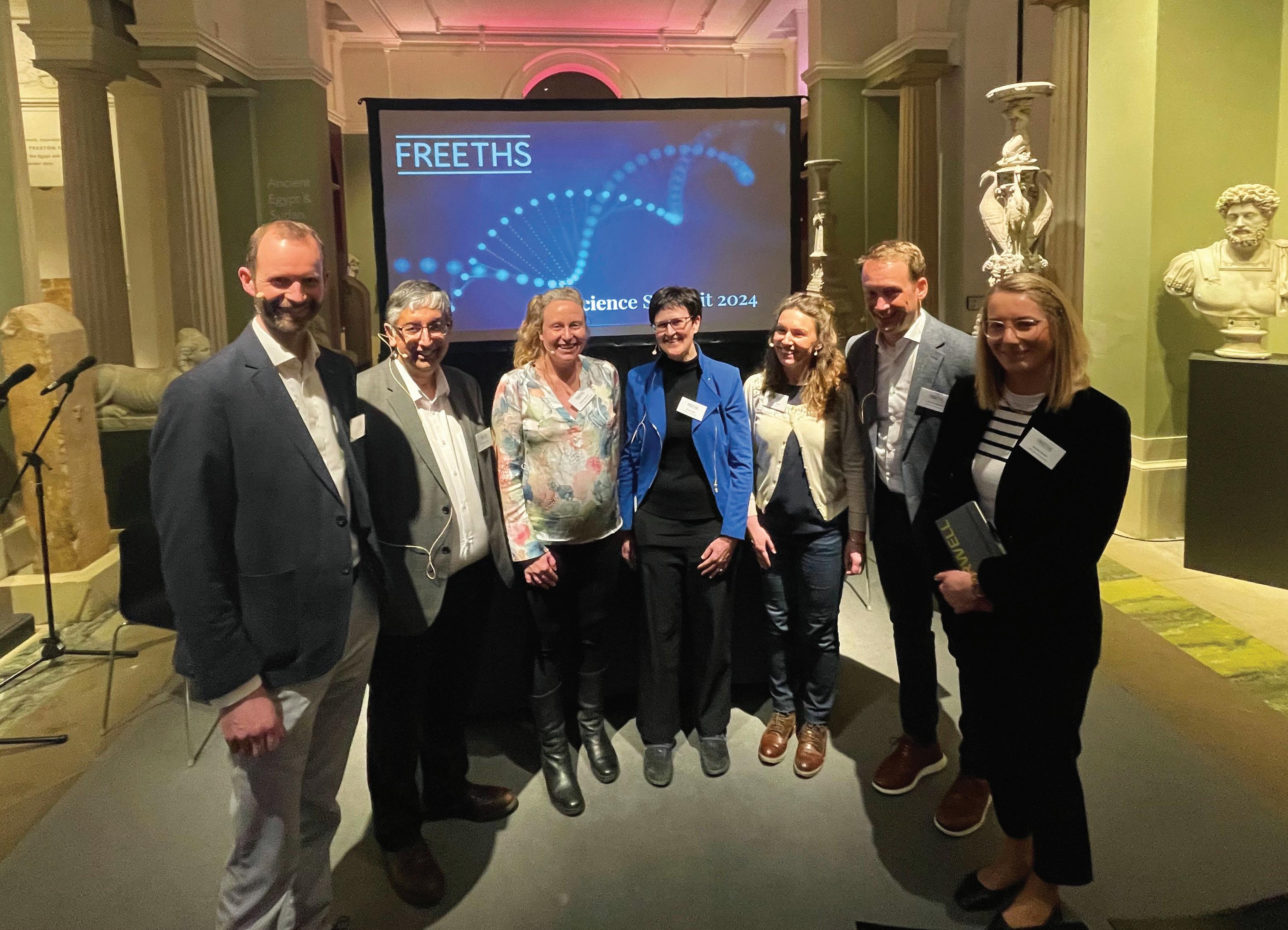
At the annual Freeth’s Life Sciences Summit, held at the Ashmolean Museum, Oxfordshire’s life sciences community came together to discuss the sector’s issues.
It all starts with the science of course –researchers in university laboratories realising the potential of their work – so support for universities is vital.
Then it’s about developing and protecting the intellectual property around it.
And you can’t do anything without funding – so a supportive fiscal environment to encourage investors is absolutely essential.
More research and development and testing, more investment to secure regulatory approval and so on.
And at the very heart of every stage of the process, it’s about the right people in the right roles, at the right time.
Chas Bountra, Pro Vice-Chancellor for Innovation at the University of Oxford, gave the keynote speech where he highlighted
the millions of pounds in research funding secured by the university over the last few years.
And it is eye-watering. In 2021, the University of Oxford attracted £875 million in research funding – more than any other university in the country.
That year the university created a total of 31 companies – more than any other university on the planet.
In that year, the companies spun out of the University of Oxford alone attracted £1.4 billion of venture capital funding. The rest of the UK pulled in just £1.2 billion.
In 2022, spin-outs from the University of Oxford sold for more than a total of a billion pounds.
Last year the success continued, including a staggering £96 million in seed funding (probably the highest seed fund raise ever in Europe) raised by Beacon Therapeutics, a spin-out from Syncona and the University of Oxford. Beacon was founded by
Professor Robert MacLaren, “an absolute genius”, according to Chas Bountra.
He says it is the genius of the scientists and researchers which has made the University of Oxford arguably the fastest-growing ecosystem on the planet.
But where will the next generation of geniuses come from? Chas highlighted a global programme backed by the government and spearheaded by The Global Talent Lab.
“The initiative is called BIG – Backing Invisible Geniuses and aims to identify and support young people still at school and link them with undergraduate opportunities at top universities. These could be future Bill Gates and Elon Musks, who will be building the science to drive industries of tomorrow.”
Panellist Ros Deegan is CEO at Oxfordbased mass spectrometry biotech OMass
Therapeutics. “My previous job was based in Boston, Massachusetts but when I was looking around for a CEO role, I met with OMass in Oxford and loved their technology – and their senior team. Since I joined, we’ve attracted people from across the world. I think the UK has a fantastic environment to build a biotech and while talent often gets raised as an issue, I don’t see that as the barrier to growth that some others think it is.
“More of a challenge at times is infrastructure, but I think that’s true of any growing ecosystem.”
Also speaking on the panel was Leasing and Business Development Director at Harwell Campus, Monika Zemla, who agreed with Ros. “At Harwell we now have around 700,000 sq ft of commercial space and will be adding another 600,000. It is exciting to be speculatively delivering so much space to enable innovation – a great improvement on just a few years ago.
The Oxfordshire science campus is also keen to encourage the next generation of talent. Monika added: “This year we are inviting in pupils from less privileged areas, from schools who may not have thought of places such as Harwell and a career in STEM and showing them how much goes on.”
Director of Platform Technologies at Astra Zeneca, Laura Ferguson, added: “At Astra Zeneca’s Cambridgeshire headquarters we also invite in schools. I arrived at the campus the other day and there were children everywhere. It’s great to see this in action.”
However, Laura also highlighted the issues of keeping the doors between academia and the commercial world open, so that researchers can move back and forth through their careers.
“It’s that porosity which is really important,” she said. “Talent should be able to move both ways.”
To continue to attract global talent (and investment), Oxfordshire should do more to promote itself across the world the panel agreed.

Athene Blakeman, General Counsel at venture capital company Oxford Science Enterprises, said: “What goes on in Oxford is extraordinary, and I think that globally it is not recognised as much as it should be. With greater recognition, the UK has the potential to attract more capital flows and talent.”
Adam Stoten, Site Head at drug discovery company Evotec’s Dorothy Crowfoot Hodgkin Campus at Milton Park, said: “We are a bit behind the USA in terms of building that cohort of talent that can form multiple companies, and there’s more capital available to support them in the USA as well.
“But if I reflect on the Oxfordshire ecosystem that I’ve been a part of for the last 20 years on both the university and spin-out side, that critical mass is coming. What will be transformative is a spill-over of talent. We have acquired life sciences companies which have teams who have been successful in previous companies and gone on to create new ones. Their experience has meant that they have been able to secure funding.
“I am confident that we will see that spillover from companies such as Oxford Nanopore. Immunocore is now a billiondollar market capitalisation company, and there’s Adaptimmune as well. We do have some companies of scale – not a trillion
dollar one yet, but we are hopefully at that tipping point where we will see these entrepreneurs coming out of existing companies.
“Then it’s about how we support them – and we do have a growing cohort of experienced CEOs such as Ros Deegan who they can approach for mentoring.”
Ros added: “And it’s easier in Oxfordshire to find those people because it’s smaller. In Boston it’s harder to get traction because it’s so much bigger.” (The population of Greater Boston is more than four million, compared less than that of 800,000 across Oxfordshire).
Panel moderator John Blackwood, Vice-President of Biology at Samsara Therapeutics, said one thing that Oxfordshire does have is a strong network of young founders.
“Just having that network of advice, knowing who to talk to, is really valuable.”
Chas Bountra agreed: “All these young companies need the same thing at certain points.
“And the university has an important role to play in this, supporting talent and recycling it into new companies, as well as spreading the net wider across the whole university, and indeed other UK universities, to support departments where there hasn’t been such a strong history of recognising ideas and spinning out companies.”
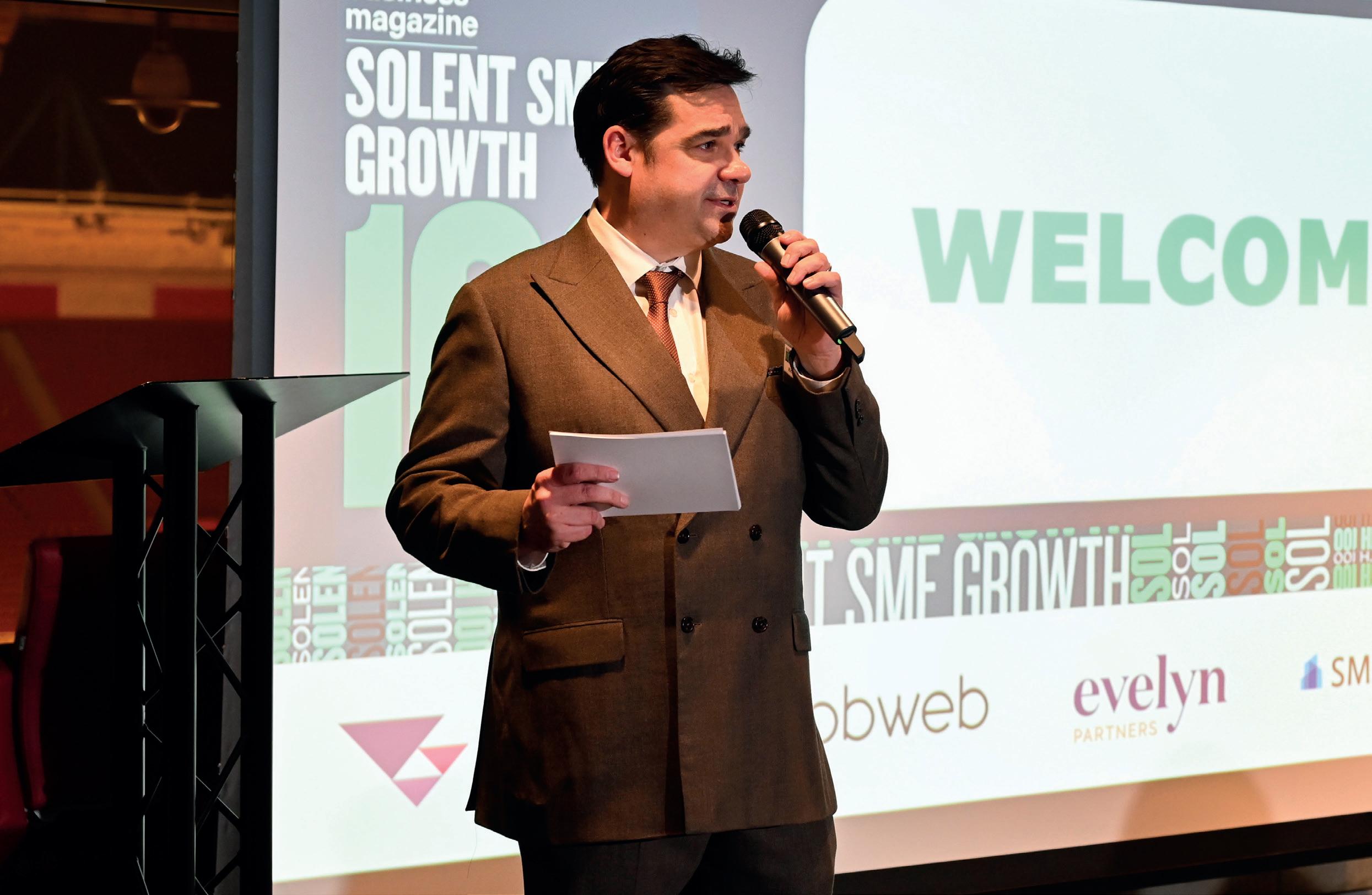
A diverse range of Solent businesses were honoured at the Solent SME Growth 100 dinner and awards for their commitment to driving the region’s economy.
The Halo lounge at Southampton FC’s St Mary’s Stadium played host for the evening, providing the finalists, sponsors and guests with a great networking opportunity.
Richard Thompson, Managing Director of The Business Magazine, said: “Cumulatively, these fast-growth companies employ more than 10,000 people in the region and generate a turnover of more than £1.5 billion. This ranking is a testament to the vibrancy of the region that we live and work in.”
Jo Whittle, Operations Director at The Business Magazine, thanked the finalists

Cumulatively, these fast-growth companies employ more than 10,000 people in the region and generate a turnover of more than £1.5 billion
for their “willingness to get involved and for readily opening your doors to our judges and sharing your stories. Your passion and enthusiasm for what you do made judging these awards extremely difficult.”
She also thanked the sponsors of the Ranking: SME Capital, Cobweb Solutions, Chilworth Partnership and Evelyn Partners.
Guest speaker for a ‘fireside chat’ was Jamie Noble, Founder of Noble Company Holdings, providing rope access work for abseiling down structures to carry out maintenance and repairs. He talked about the company’s rapid growth in the infrastructure sector.
The Halo lounge at Southampton FC – the setting for the Awards dinner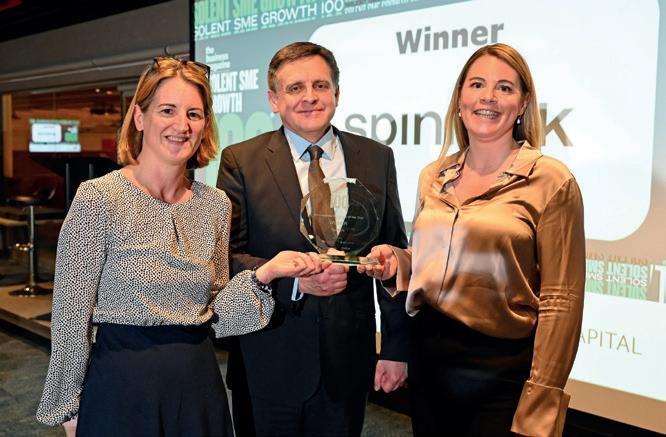
INTERNATIONAL BUSINESS OF THE YEAR
WINNER: Spinlock
FINALISTS: A.J Wells & Sons | Mar-Key Group | Pascoe International | Vikoma International

MOST OUTSTANDING FINANCE TEAM OF THE YEAR
WINNER: boatfolk
FINALISTS: SMS (Southampton Marine Services) | HIPPO (Waste Management Services) | Langmead Herbs | Saltus Partners

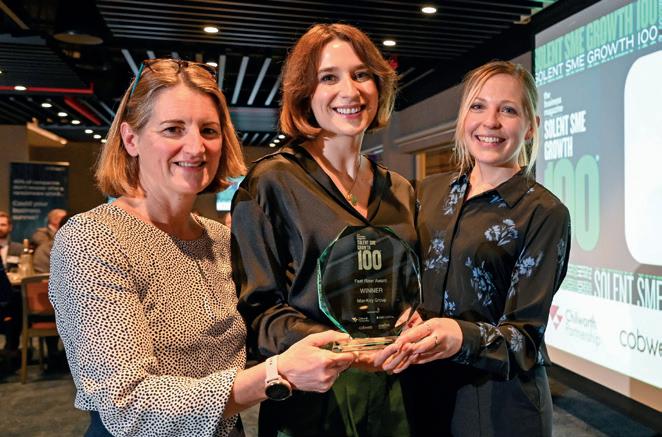
FAST RISER AWARD
WINNER: Mar-Key Group
FINALISTS: boatfolk | Dolphin Motor Homes | Fence Stores | Saltus Partners

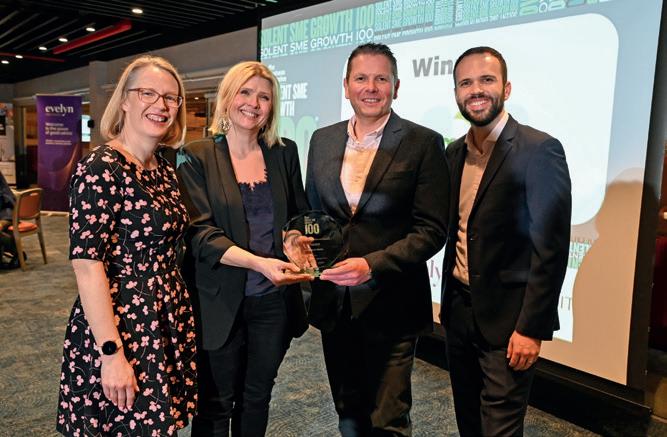
GROWTH & RESILIENCE AWARD
WINNER: Langmead Herbs
AWARDED FOR SPECIAL ACHIEVEMENT


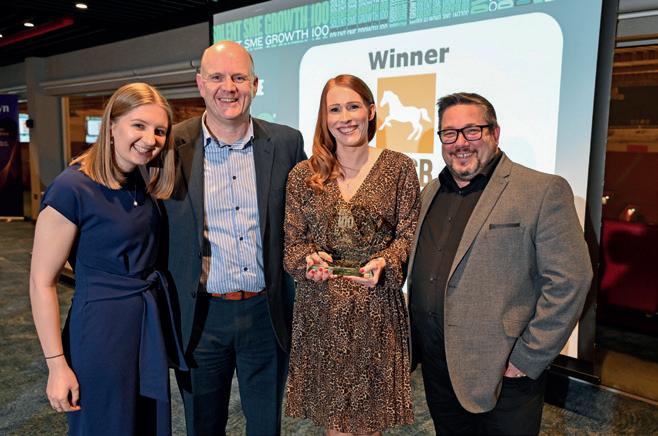
LEADERSHIP TEAM OF THE YEAR
WINNER: NMSB
FINALISTS: Caspian ONE | Paragon Education & Skills | Paris Smith | Spinlock
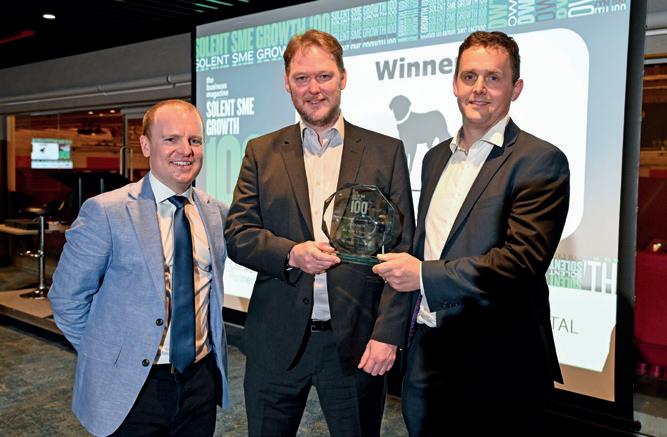
OWNER-MANAGED BUSINESS OF THE YEAR
WINNER: A.J Wells & Sons
FINALISTS: Caspian ONE | Fence Stores | Spinlock | Tailor Made Technologies
FOR FULL GALLERY AND TO READ MORE USE THE QR CODE BELOW




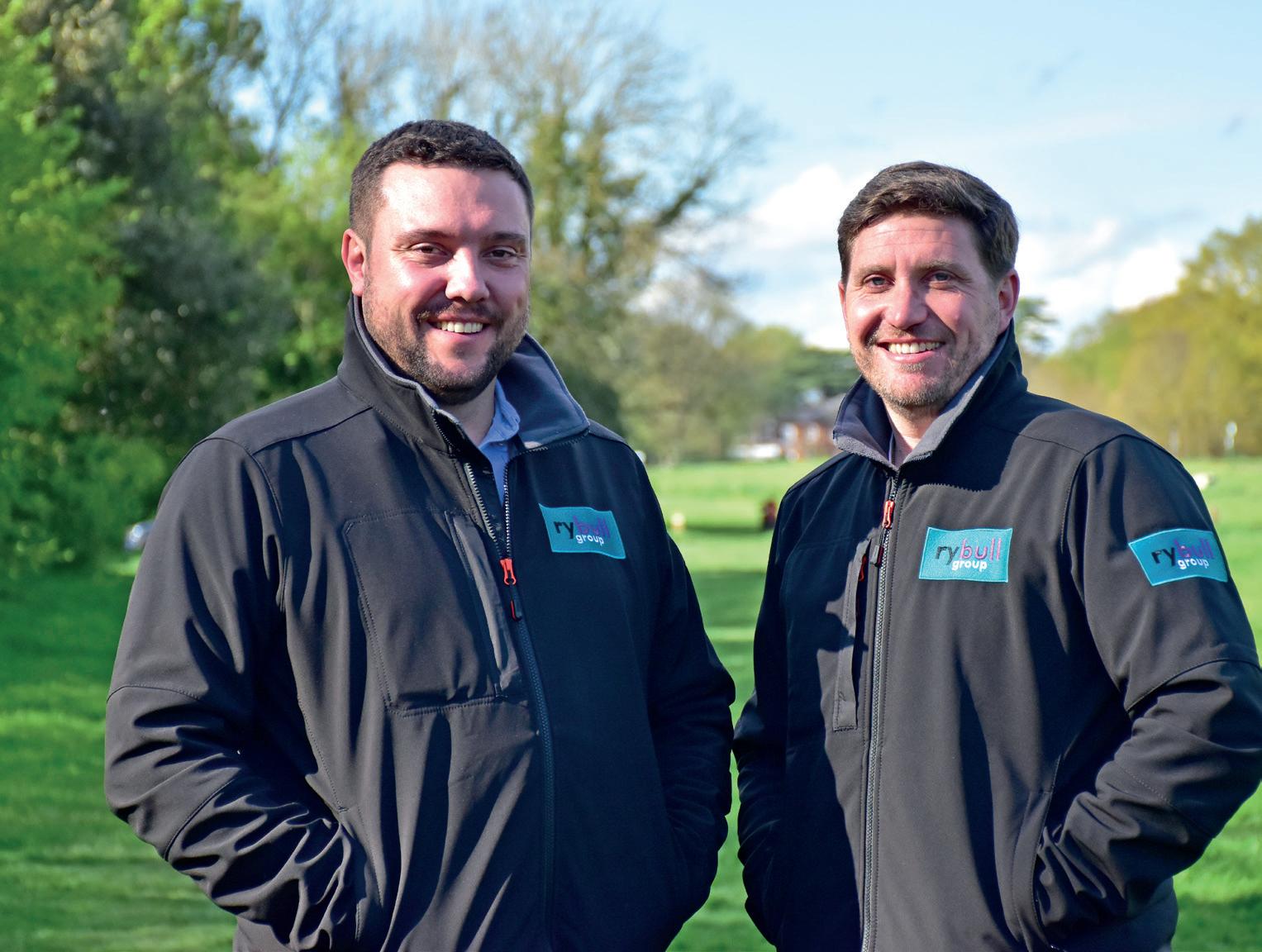
In a recent interview, Chris Ryall and Ian Bullimore, founders of rybull group, shared their enthusiasm for the company's inception following the merger of trademyland and Clutch Property. "This merger is an exciting opportunity to combine the strengths of two established companies and offer our clients a more comprehensive and dynamic property service," remarked Chris.
Ian echoed this sentiment, emphasising the proven success and combined strengths of the two entities. "trademyland and Clutch Property have built strong reputations in commercial and residential sales, lettings, and land transactions," he stated. "Now, as rybull group, we're leveraging our collective resources and expertise to better serve our clients."
Highlighting recent achievements, Chris cited notable transactions such as a commercial sale and leaseback in Hertfordshire, a significant industrial site acquisition in Essex, and multiple option and promotion agreements over strategic land in the Home Counties. "Our portfolio reflects our versatility and reach across a range of property sectors," he added.
With a focus on becoming the go-to agency for property needs across the UK, rybull group aims to provide clients with a personalised approach tailored to their specific requirements.
"Whether you're buying, selling, letting, or developing, our team is committed to delivering a smooth and stress-free experience," emphasised Ian.
At the core of rybull group's philosophy lies a dedication to building relationships based on trust, integrity, and honesty. Values possibly born from the fact both founders have previously worked for the Metropolitan Police Service. "We believe in creating opportunities that benefit everyone involved," Chris stated. "Our clients aren't just transactions – they're partners in our journey towards success."
rybull group stands ready to support clients, whether they're seasoned investors or first-time buyers, with local knowledge, industry expertise, and a commitment to exceptional customer service. "Join us as we shape the future of the UK property market together," Ian invited.
As rybull group moves from strength to strength and with a strong pipeline future proofing the business they are looking to bring in new talent and are actively seeking dynamic property professionals to join the team. If you’d like to have conversation they can be reached through enquiries@rybull.co.uk.
In addition to their professional pursuits, Chris and Ian are devoted to giving back to the community. From charity golf days to supporting industry events like the Thames Valley Property Awards, they’re actively involved in initiatives that go beyond business.
Not all heroes wear capes... some just have great ideasBy Daniel Face, reporter
The telephone. Chocolate bars. An Aston Martin DB9. Three British innovations which also happen to have been picked as luxury items on BBC’s Desert Island Discs. (Elton John, Dame Kelly Holmes and George Michael respectively, in case you were wondering).
If there’s a point there – bear with me –it’s that these things, to some extent or another, have successfully entered into and transformed our daily lives.
The landscape for innovators is different now. It’s hard to imagine Alexander Graham Bell enrolling on a science park incubator programme or pestering Innovate UK for a grant.
But one thing has remained true – a good idea simply isn’t enough.
In this feature we’ll meet a handful of innovators from the South East, many of whom have had little formal training in or contact with the business world prior to pitching their products.
For them particularly, one of the most daunting tasks on the journey to commercial


success has been convincing investors not just of the practical application, but the value and market potential of their ideas.
Because any investor worth their salt has no doubt been burned before by a once promising start-up fizzling out with nothing to show for the time and money poured into their master plan.
Let’s say the investors, with a pinch of cautious optimism, are happy to come aboard for the ride. What can they bring to a fledgling brand? It’s not all blank cheques and pound signs – it’s also publicity, connections, mentors who have been there and done that.
But even the greatest start-up guru will face a new challenge with each new product. Every innovation will target a slightly different market – and some, entirely new markets.
One in a million ideas might be so revolutionary, they’ll sell themselves. For the rest, there’s a whole potential customer base out there who’ll not only need to find this innovative new product but believe in its value to their daily lives.
What separates our heroes from the rest of the pack is their proven ability to land the leaps of faith between drawing board, prototype and commercial product
Sound familiar? It’s not just investors that need convincing – they’re only the start.
Even with all the backing in the world, many innovators just can’t bridge that gap to the customer.
What separates our heroes from the rest of the pack is their proven ability to land the leaps of faith between drawing board, prototype and commercial product.
Some have just made the jump, others are successfully finding their footing on the other side – but they all have something brilliant to show the world.
We all know the drill by now – refillable flasks, paper straws, those fiddly caps attached to bottles to make sure they get recycled together. It’s the least we can do to protect our already heavily polluted oceans.
We also know that many other things are entirely beyond our control as consumers. Because it isn’t just household waste that ends up where it shouldn’t.
“A lot of people are talking about plastic bottles and straws”, said Xavier Warburton, co-founder of Portsmouth pet products brand Tangle.
“But around 46 per cent of the Great Pacific Garbage Patch is ghost net material from fishers” – ghost nets being those abandoned, lost, or discarded out at sea.
“I helped on a lot of boats while I was at university, so I saw first-hand the plastic pollution problem in our oceans. It was ticking away in the back of my mind for six or seven years.
“Then one day, I was looking at all the different products in a pet store and thought, ‘there must be a better way’.
“The material they make fishing nets out of is built to last in the depths of the ocean, so it’s really durable. And people are looking for waterproof products for their pets, so it’s pretty much the perfect material.
“I’ve spent so much time out in the rain walking my dog, and I hated how the lead would stink afterwards. That’s how the whole thing came together.”
And so it was that in 2022, Xavier teamed up with fellow co-founder Sam Cartwright to launch Tangle.
The duo were keen to stop the problem at its source, so they began offering fishers incentives to trade in their old nets rather than throwing them overboard.
Tangle then breaks the material down into small green pellets, which can be

“We also offer a guarantee that if it breaks, you can send it back to us and we’ll send out a new one, as well as recycling the old one. It’s about setting up a circular life cycle”
remoulded into a variety of different forms. Bowls and leads are the two key products for the moment.
“We want to make something people don’t want to throw away”, said Xavier, “so the design needs to be sexy and sleek, but also practical and functional.
“We also offer a guarantee that if it breaks, you can send it back to us and we’ll send out a new one, as well as recycling the old one. It’s about setting up a circular life cycle.”
Last year alone, Tangle saved 1,800 sq m worth of fishing nets from a ghostly fate, the equivalent of seven tennis courts.
They also took part in the relatively new Amazon Sustainability Accelerator (yes, that Amazon) alongside 16 other growing UK climate-tech businesses, helping the brand reach more customers.


For the past 25 years, Monty Ravenscroft from Selborne, Hampshire has made a name for himself designing sliding roofs and other (un)hinged architectural elements for billionaires across the world.
But with any luck, he could soon have another successful venture to add to his portfolio.
Hidealoo is the world’s first retractable toilet frame, capable of rotating out 90 degrees from within a cupboard or cavity space.
In terms of plumbing, it swaps the usual rigid pipes for a bespoke flexing system using marine-grade rubber, which in testing has breezed through more than 250,000 full rotations. The frame itself can
comfortably bear a 400-kilo load without buckling.
It’s taken more than five years to get to this point, with a patent secured along the way. But far from being a diversion from his day job, Hidealoo is very much a product of Monty’s lifelong design philosophy.
“I’ve always just jumped in. I don’t quite know why.
“Around the mid-nineties, my sister used to work for an architect, and he tried to organise lots of things that moved in projects.
“He’d get someone to make the wheels, someone to make the glass, someone to do the water sealing... and none of them would
tie together, so it never really worked.
“I got involved and started mopping up the messes, and I suppose I’ve made a business out of doing that for other people.
“I bridge the gap between the ‘art’ of the architect, which is generally impossible to be practical, and the clunky solutions of the engineers, which actually work but look horrendous.”
Over the course of his career, Monty’s taken bits from boats and tractors and stuck them in the roof, and he’s bent glass far further than anyone thought possible.
But to turn that prototype into an actual functioning business is pretty much a miracle

The project for which he’s best known – and that’s partly down to the slew of non-disclosure agreements that come with commissions for VIP clients – is a tiny property in Peckham, which featured on Channel 4’s Grand Designs.
In fact, it was voted by viewers as one of their top 10 builds of all time. Monty reckons it was an empathetic project for DIYers, with the whole thing – plot, structure, interior – costing less than £220,000.
“The main living space in that house only has light coming through the roof, which opens up to turn the room into a courtyard.
“The bed slides away to reveal a bath underneath. The basin is hidden in a drawer that pulls out from the wall. And the showers are inside light fittings in the ceiling.
“The only thing that didn’t yet move in that house was the loo.”
At the same time, the health of Monty’s father was failing, and he found himself struggling to get to the toilet. So along came an idea fit for both the Peckham House and his dad.
This was the first apparent commercial use case for Hidealoo. Monty reasons that, if an elderly relative were to join the family home for, say, a year of palliative care, there’s a good chance they’d need a bathroom close by.
The Hidealoo is a little over twice the price of comparable static mounting frames, coming in at £1,125 excluding VAT. But when compared with the installation costs of even a basic bathroom, it’s proving to be an appealing alternative.
“We’ve got an ageing population who need better facilities, ideally, to stay at home with their loved ones in their frailer years.
“Anything that helps us do that in a dignified and practical way will save money for the state and the individual, let alone the moral or psychological side of it.”
And that’s not to mention real estate. It soon became apparent that Monty’s pocket-sized Peckham House wasn’t the only property in the world to put such a premium on space that the Hidealoo would offer a cost-efficient trade for just a few more square feet.
In the notoriously cramped metropolises of Japan and India the demand was obvious. But the United States – land of the free and wide-open space – surprised Monty as a strong early market.
Many have taken to installing the Hidealoo in a utility (or ‘lootility’) room cupboard.
Others have looked to capitalise on the dead space in attic-style bedrooms where a sloped ceiling meets the floor.

“It’s often said with design that ideas are quite easy. Then, making a prototype is really hard work, and it’s a long, difficult road. But to turn that prototype into an actual functioning business is pretty much a miracle.
“It’s an enormous undertaking to give confidence to investors – not that the idea or even the execution is good, but the process and the infrastructure behind it. That’s what really counts in business.”
One of the latest to jump on board has been the British Design Fund, a source of investment for ‘purpose-led British product businesses’ backed by Sapphire Capital Partners.
They, like all the others, took some convincing, but have since brought crucial publicity to the venture and provided business mentors to help Monty scale up.
“We’re very committed to being Britishmade because we can really control the quality. That’s one of the things the British Design Fund wanted.
“Hidealoo has been an intriguing
challenge for them because there isn’t anything else quite like it – it truly is a ‘first’. Most of the other products they’ve backed have been an evolution of something that came before.
“It’s also slightly odd because it’s a part of people’s lives that no one is particularly proud of. It’s a moving bog!”
In many ways, Monty’s using the novelty to his advantage. Hidealoo proved a crowd favourite at Europe’s biggest bathroom show in Birmingham earlier this year, earning them the People’s Choice Award and a runner-up spot in the Judges Award for Innovation.
“It’s early stages for us, so we’re not selling in the tens of thousands. But it’s going all over the world – Singapore, Italy, Romania, Bulgaria.
“In Europe, we buy 29 million toilet pans a year. Our business model is to try and reach 0.1 per cent of that market in the first couple of years.
“We’re primarily looking only at Europe and North America to start. Then, having established a customer base and a reputation, we can look to move further overseas.”
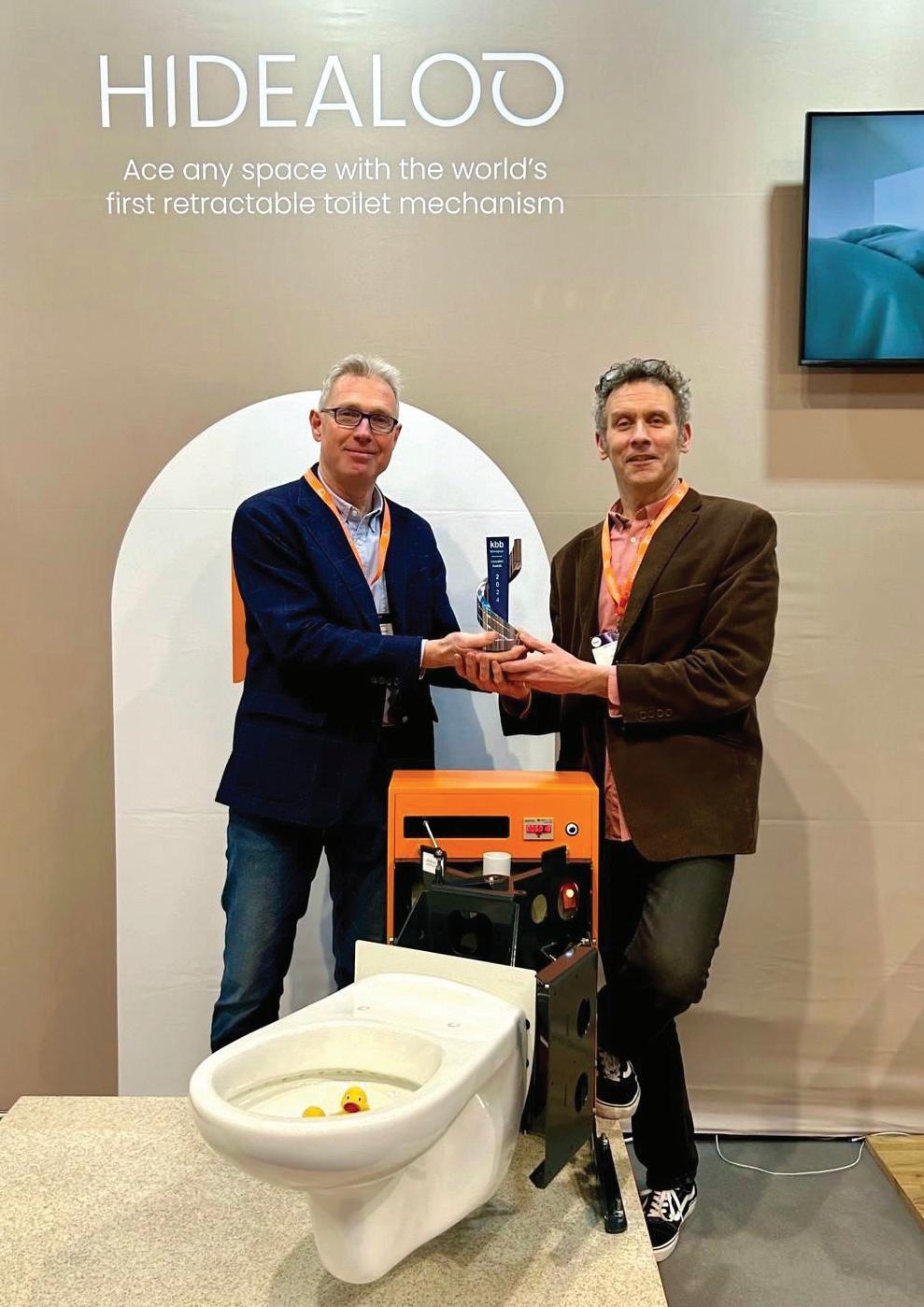
With sales and awards now coming thick and fast, Monty and his investors are optimistic for the future. But they also accept the inevitable risk that comes with getting there first.
“Sometimes great ideas get missed, whether by time or circumstance or fate. I don’t know where the Hidealoo will sit in that – only history will tell.
“The one thing I do know is that the market is vast and totally futureproof.”
Mark Foster has headed up engineering projects for the likes of Red Bull, Mercedes and Williams Racing. It’s safe to say he knows his way around a car – and the track.
Who better, then, to recreate the experience at home.
A few years ago, Mark set out to build a simulation racing cockpit with zero preconceptions. The result was the RSR-21, a wooden structure made to mimic the interior of a vehicle.
Inspired by the design of aircraft bulkheads, it offers a higher range of adjustment than most competition on the market, with a configurable seat, pedals and steering mount.

Crucially, too, the structure remains consistently stiff on sharp turns and harsh brakes. That’s because it’s made of sturdy birch plywood – a unique alternative to the typical steel and aluminium frames which, as a bonus, is sustainably sourced.
Mark doesn’t provide the simulator itself, of course. The cockpit is pre-drilled for hardware from Fanatec, Thrustmaster and Logitech, and supports flight simulators and video games.
Motion capture, or mocap, is a great tool for film studios looking to reproduce realistic movements and gestures in animation.
But for smaller projects without the time or money to hire a studio or actors, there have traditionally been just two solutions – a generic library of premade assets, or a costly and sometimes logistically tricky on-site shoot.
The alternative, from a start-up operating out of Fareham Innovation Centre, is Performit Live.
Launched last September, the Perfomit Live mobile app connects animators with professional performers, from generic actors to contortionists and martial artists.
Both parties agree to meet, Zoom-style, over the app at a prearranged time. The performer will then appear onscreen as a
virtual avatar, with the user able to see and direct their movements in real time.
For £36, users get 20 minutes – ideal, say the developers, for a short fight sequence or TikTok-style dance. Spend more and they can have one, two or even four hours with a performer to get the choreography just right.
No matter the window, it’s a cheaper and convenient solution for bespoke mocap.
“What’s incredible about the app is that performers can execute their directed moves in the comfort of their own home, outdoor space or workplace” said Jon Dalzell, who founded Performit Live alongside James Banfield. “There’s nothing like it in the UK.”
The duo lead a team of five and have served customers as far away as Peru and Seattle.
The RSR-21 is the flagship product of Oxfordshire-based Rock Solid Rigs. Last year was a busy one for the business, with the launch of a new ecommerce site and opening of an R&D building in Bicester to host prototyping and business development activities.
Mark’s also secured the backing of Innovate UK and begun making a name for himself and his brand on TikTok.

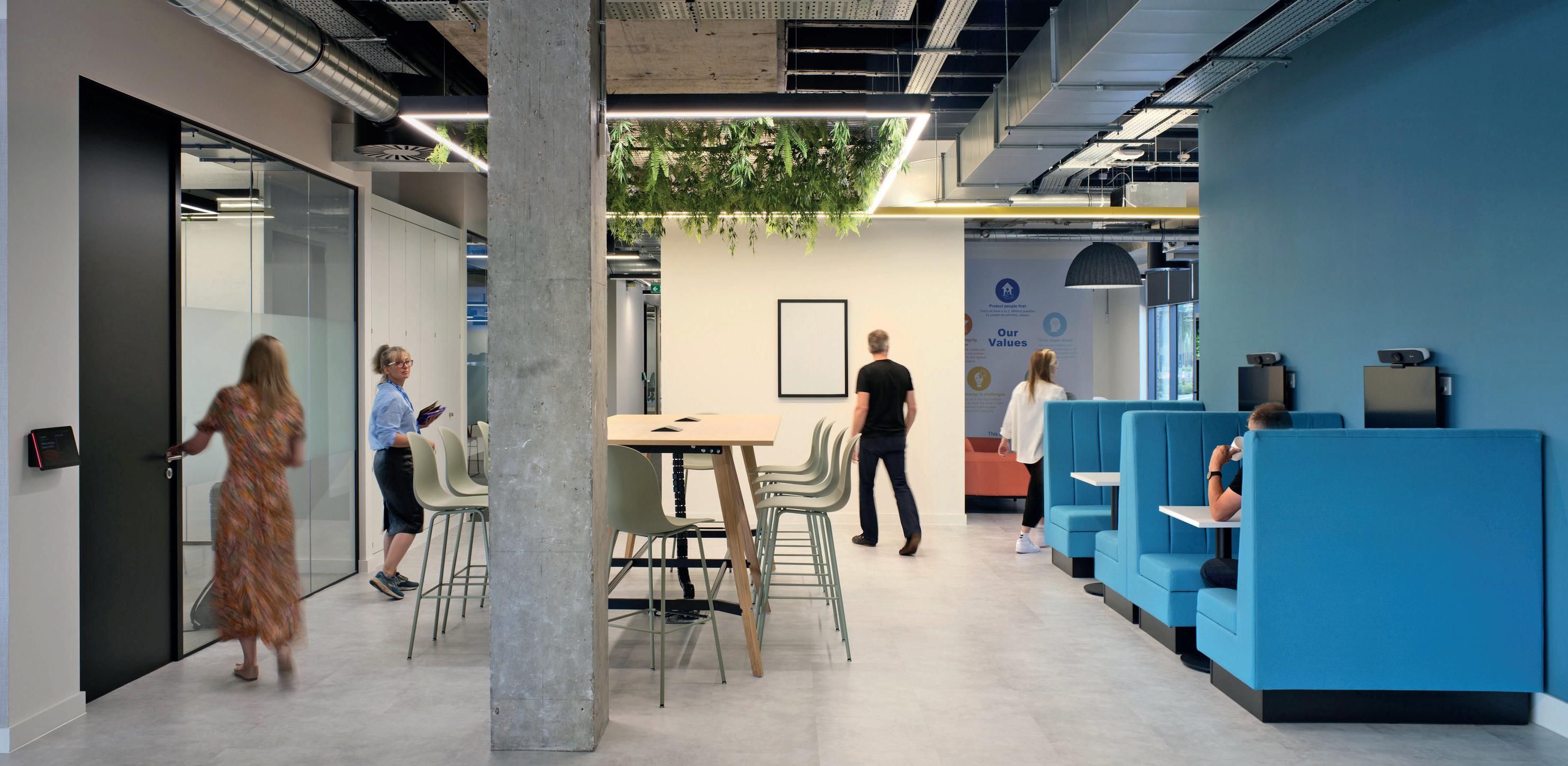
While everyone’s talking about the impact of artificial intelligence (AI) in the workplace, we’re looking at its potentially transformational effects in office buildings, which shape how we work and our motivation to commute there in the first place.
old, the new, the hybrid
For many companies, the office space has languished for decades beyond its shelf life, failing to attract the talented people who want more than a token plant on their pre-Covid desk. The fact is the next generation of workers expect AI in the workplace. For younger workers, the idea of having to schlepp to an office to use the photocopy machine is a thing of period dramas. Older workers also want more bang for their commuter buck. After all, this is a world that’s seen stay-athome mandates and the perks and possibilities of working from the kitchen table.
The office has never had to work so hard to draw people in
AI is a compelling differentiator that will only become more so as people’s homes get more and more high tech. With virtual assistants at the behest of every whim, our houses are already fitted with more AI than your average skyrise can dream to match. When it
does, there’ll be competition between employers to out-AI our homes – and to out-AI each other. AI has been poking around the workplace for a while – whether we’re aware of it or not – and is on the cusp of taking off. Here we look at the many ways we can harness AI to enhance the office experience for employees and their clients, while offering flexible, sustainable and cost-efficient options for those making the decisions.
First on the decision makers’ to-do list: choosing an office building. This has traditionally meant perusing visuals – photos, floor plans, energy performance charts – and a rudimentary background check.
AI opens up a whole new galaxy of information to help tenants, landlords, agents and even sectors make the best selection for their base. AI can do an instant scan of everything in a building’s vicinity – from amenities and demographics to air quality, travel times, crime statistics and more. It can
also examine both historical and realtime market data to identify trends in property values, rental rates and demand for specific types of buildings.
It can then use algorithms to create predictive models showing a building’s future value or performance. How much will it cost to run in five years’ time? What will the area look like ten years from now?
Inside the building, AI can help architects and interior designers to visualise and map out space. Taking a floor plan, these teams can use AI to suggest optimal layouts according to people flow, sun position and workspace requirements on any given day, as well as scenarios for every permutation of work model. AI can then generate test fits and virtual reality simulations of the office layout – and umpteen future adaptations –before construction begins.
It can also help us optimise energy usage, lower costs and reduce our
carbon footprint – from deciding which walls, design features and furniture items are absolutely necessary (and/or fit for multipurpose) to choosing the most ecofriendly materials and sustainable building practices.
In short, AI can show and recommend how to build, use, grow into, reconfigure and repurpose a building for the years to come – and how to hand it over with the least possible waste.
AI is a cosy and clever addition to the office team
Once the contractors have gone and the occupants are in, AI can make a building so inviting it may lure even the most office-shy worker out of the house.
Firstly, there’s comfort. Smart office tech can customise a workspace according to personal preference and productivity. We’re talking heightmemory desks and automatic controls for temperature, lighting and music. Virtual meeting assistants can set up collaborative whiteboards for teams of remote and in-office workers, then take notes, make suggestions and order coffee along the way.
These digital aids are likely to grow for individuals too, as they’re able to access all our files, trawl heavy data and do the mundane and monotonous without effort or complaint. Tasks like data entry and timesheet submission.
AI offers foresight, flexibility and financial savvy
Aside from adding ambience and convenience, AI tools deliver significant cost savings. Smart sensors can optimise the lighting and heating based on natural light, climate and desk traffic from one day to the next. As AI in buildings will be lowering operational energy, this will make spaces more sustainable.
Intelligent tech can provide a constant cost analysis of office usage – staff movement, weekly activity, seasonal trends – and look at these in relation to energy consumption, market forecasts and supplier quotes to identify both cost-saving opportunities and ways

to adapt the space for now and projected growth.
AI can also predict when office facilities need an update or maintenance check and schedule these tasks. It may not be long before AI-powered robots actually carry out such jobs, along with cleaning or moving furniture to adapt to changing needs.
In terms of security, AI can use biometrics to control both physical and data access. It could even use voice and face recognition to monitor the emotional health and wellbeing of staff, and potentially adjust environmental factors to boost mood and productivity.
AI is not without its challenges, but nor is it optional
On the flip side, AI brings security risks too, with exposure to hacking as well as ethical concerns about surveillance, monitoring and data collection. Companies will need a raft of new policies to address privacy and compliance – and to be proactive with AI training.
But this is all part of running a business. And, like the internet before it, AI is not a nice-to-have. For employers wanting to stay competitive, it’s a must-dosoon whose absence will drive a bigger wedge in the case of home versus office – and company versus company.
The future is a happy and exciting blend
While offices will still be designed and fitted out by people, we see many benefits to using AI at different stages of the process – from selection and design to sustainable build, occupant experience and eventual hand over –thanks to its deeper and faster insights and analytics.
AI can streamline the fit out process, making it more eco-friendly and cost efficient, more customisable and collaborative, and altogether more conducive to employee wellbeing and productivity. Companies can scale without adding headcount and effortlessly adapt their workspace for changing business needs.
Beyond the workspace, we might even share our office data with the wider community for the benefit of all. For example, if we and other office buildings deduce that Wednesdays are a high people-traffic day, we could liaise with local companies, such as transport providers and sandwich shops, who may decide to scale up their services in line with our footfall.
But first things first. We need building infrastructure to catch up with all this tech – and for companies to invest in the notion of office life. For some, it may seem unrealistic to return to the big commute. But, with the right culture and AI capability, we believe the office could be entering a whole new level of water cooler love.
In 2022, there were 6,850 life sciences companies operating in the UK, together generating more than £108 billion in turnover.
And if the UK is to become the science superpower that the government wants, there must enough laboratory space for them to launch, thrive and grow.
A big opportunity for the commercial property sector, then. As demand for research laboratories and, to a slightly lesser extent, life sciences manufacturing facilities rises, more developments are getting investment and construction is ramping up.
The south east continues to have the UK’s highest share of both life sciences industry employment and turnover, accounting for 23 per cent of total employment and 30 per cent of total turnover in 2021-22, according to a report published by the Association of the British Pharmaceutical Industry last December.
But other regions around the UK, notably in the West Midlands, Birmingham and Bristol, are catching up.
In fact, demand in many areas is expanding more quickly than developers can build.
According to Ben Green, Director at commercial property company Eddisons: “Before the pandemic, there was a
real shortage but since then there has been substantial investment and a spurt of development which is now coming through.”
And what has been completed is being taken up immediately, he adds. Ben cites a raft of laboratory developments across Cambridgeshire, where he’s based.
Most recently, in March, experienced investor-developer Bruntwood SciTech got the green light for its proposed £250 million Melborn Science Park.
And there are significant developments already under way at the other end of the “Golden Triangle” in Oxfordshire. Drive along the A40 into Oxford and, at Wolvercote, the landscape is changing fast. This major new development being undertaken by Thomas White Oxford, the development company of St John’s College, will see a completely new life sciences and innovation district for the city. The joint venture between Ontario Teachers’ Pension Plan will invest around £700 million to deliver 939,000 sq ft of laboratory and workspace along with residential space, amenities and infrastructure.
Across the city, The Oxford Science Park has started work on building three new office and laboratory buildings to the west side of the park.
Elsewhere around the city, Begbroke Science Park is expanding with two new buildings for office and laboratory space,
and Oxford University Developments is consulting local councils on a 190-hectare site, five miles north of Oxford, for a new Begbroke Innovation District.
ARC Oxford (The Advanced Research Clusters Group, a UK network of science and innovation clusters), is creating a science campus at Garsington, Oxford. Property investment and development company MEPC has recently started on a £40 million research and development scheme at its huge Milton Park science and technology campus near Didcot. The 80,000 sq ft development will combine high-tech, flexible R&D spaces with offices.
Even Oxford’s former Debenhams department store looks like it will become a life sciences hub too. Property developer Pioneer Group is reportedly close to sealing a £30 million deal on the building for a 175 year-long lease on the building is close to completion.
At Culham Campus, near Abingdon, the UK’s Atomic Energy Authority is building a £40 million science and engineering and office complex, scheduled to be finished this year, while at Harwell Campus, more than one million sq ft of projects are currently under development or have been completed. By 2027, the campus will have delivered more than 1.5 million sq ft of labs, offices and advanced manufacturing space alongside a new hotel, conference centre, homes and amenities.


“We needed separate lab space and support from those operating between academia and the commercial world”
And property investor Kadens is building new laboratory space at Abingdon Science Park.
But the laboratory development bonanza isn’t restricted to the Golden Triangle. The Midlands is home to the largest cluster of health/med tech companies in the UK.
The region’s health and life sciences supercluster generates an estimated £20.5 billion GVA per annum. And more than half of recent foreign direct investment into high growth firms in the sector in the UK were made in the Midlands, according to the Midlands Engine Pan-Regional Partnership.
Birmingham Health Innovation Campus (BHIC), in the heart of the city’s critical cluster of health excellence, is being developed through a long-term collaboration between the university and Bruntwood SciTech.
In Bristol, the university is working with the city’s deep tech support organisation Science Creates on an £8.5 million major new incubator in the heart of the new Temple Quarter Enterprise Campus. This
will be Science Creates’ third deep tech incubator with the university.
Science entrepreneur Dr Harry Destecroix, founder of Science Creates, said: “We have been working with the University of Bristol to help improve the conditions for deep tech spin-outs for nearly a decade.”
Hampshire’s life science sector has also grown significantly over the last five years. More than 150 life science companies are based in the region, many at Southampton Science Park.
Discovery Park, Kent, the thriving life sciences and technology science park based near Sandwich is another one of the UK’s most important science parks and home not only to global pharmaceutical company Pfizer, but also to more than 160 start-ups, scale-ups and established businesses – from bio-techs to healthcare, technology, professional services and more.
The science park covers more than 220
acres and is also home to a Barclays Eagle Lab, one of the UK’s largest co-working and incubator networks.
The government is supporting this expansion of science facilities. Last year it promised £103 million to help upgrade the UK’s research infrastructure.
Locations to benefit include Cambridge, Bristol, Warwick and Southampton.
This is good not only for the construction sector building the laboratories, but for the life sciences companies themselves. More dedicated lab space for start-ups means that they can focus on their research.
Bristol’s Science Creates founder Harry Destecroix founded the deep science startup incubator because he’d struggled to find lab space for his biotech start-up Ziylo, which he sold in 2018. If Ziylo’s discovery fulfils its potential to improve the lives of millions of diabetes sufferers around the world, the deal could eventually be worth more than $800 million.
“We had nowhere to put the company, we were paying a lot for the lab space at Bristol University, and we wondered – how do we commercialise the technology and give it back to the world?
“We needed separate lab space and support from those operating between academia and the commercial world,” Harry added.
So even while developing Ziylo as a start-up, Harry also designed his own incubator.
“We found a building in Bristol, hired an architect who we still work with, and designed our own research facility on Albert Road.”
Eight years on and the commercial property sector has recognised the value in creating new laboratory and manufacturing space for the life sciences sector, so it doesn’t have to be left to science entrepreneurs like Harry to do it themselves.

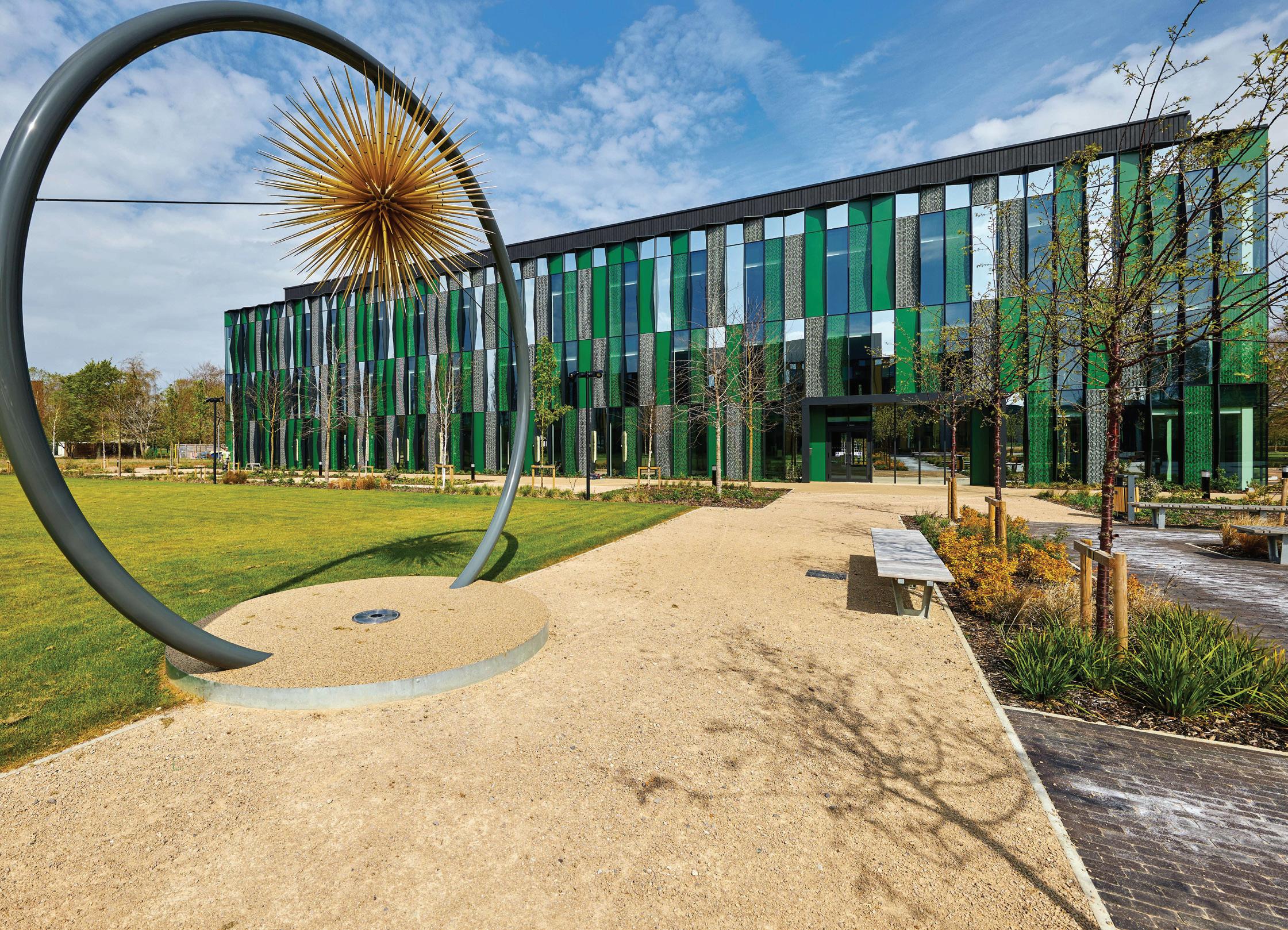
The UK Space Agency has relocated its headquarters to Harwell Science and Innovation Campus near Didcot, bringing it closer to major players in the sector.
This June, the team will move into a 10,500 sq ft space in the Quad Two building.
They’ll join commercial space organisations like Astroscale and Oxford Space Systems, as well as public sector organisations including the European Space Agency, RAL Space (run by the Science and Technology Facilities Council, STFC) and the Satellite Applications Catapult.
Stuart Grant, chief executive of Harwell Campus, said: “We’re delighted to welcome the UK Space Agency to the thriving space cluster of more than 100 organisations at Harwell Campus.
“Their presence cements the campus’ position as a leading international space hub and will help leverage synergies,
drive innovation and foster partnerships with key industry players.”
Valued at more than £17.5 billion a year and employing more than 45,000 people, the UK space sector is growing faster than the rest of the nation’s economy.
Harwell Campus is home to one of Europe’s largest space clusters. It offers a funded scale-up and accelerator programme. The Science and Technology Facilities Council has supported more than 100 space-related organisations through the programme, maintaining an 87 per cent survival rate.
Dr Paul Bate, CEO of the UK Space Agency, added: “This is a transformational moment for both the UK Space Agency and UK space innovation.
“The UK space sector is growing rapidly, and moving closer to the industry we serve will boost growth, improve relationships with regional organisations and support a strong, diverse and resilient sector.”
The Natural History Museum has got the green light from Wokingham Borough Council to bring a new collections, research and digitisation centre to Thames Valley Science Park in Reading.
Work is expected to begin early next year and finish in 2027, although the centre won’t open its doors until 2031.
By then, the 25,000 sq m site will be kitted out with high-tech labs, workspace for museum scientists, and purpose-built storage for 28 million specimens.
This represents around a third of the museum’s entire collection and transporting it all to Shinfield will mark the largest move of natural history specimens in the world.
Tim Littlewood, executive director of science at the museum, said: “This new site will enable us to secure irreplaceable collections in a purpose-built storage facility, provide new scientific infrastructure to accelerate research and digitisation, and act as a base for new collaborations and partnerships.”
The project has been made possible by a £201 million grant from the government as part of its push to invest in science, research and development.


Hartwell Plc, the automotive and property development company, has unveiled emerging designs to deliver new carbon efficient lab and workspace buildings for small and medium-sized science and technology companies and amenities at Wootton Science Park, south-west of Oxford.
Hartwell has owned the park since 1975 and built the first office building in 2005. It has recently completed Origin, a two-storey CL2 laboratory building.
The proposed £35 million Scott Brownrigg-designed masterplan will deliver around 106,233 sq ft across five new commercial buildings along with connected amenities, which will include high quality landscaped areas, secure bike storage, a bistro and gym.
James Hilton, property director, Hartwell
Plc said: “With an unprecedented increase in the University of Oxford’s spin-out companies involved in life sciences, quantum, AI, sustainability and more, we believe that the park’s future lies in answering the demand for high-quality grow-on lab and workspace and providing amenities to not only support those working here in their innovation and discovery, but also the wider community.
“Our masterplanning work has focused on creating a well-rounded environment promoting wellbeing for all those who work here and visit.”
Wootton Science Park is accessed by the A420 or A34. The consultant team is Scott Brownrigg, Gerald Eve, IMA, Macfarlane and Associates, Aspect Ecology and Hoare Lea.
Frimley Health NHS Foundation Trust has secured planning approval to begin work on a £25 million NHS diagnostic centre at Upton Hospital in Slough.
Planned to open early next year, the Community Diagnostic Centre will operate seven days a week, 12 hours a day, providing up to 150,000 extra tests a year for the community.
It will be kitted out with MRI and CT scanners and ultrasounds.
Chief strategy officer James Clarke, who’s heading up the project on behalf of the trust, said: “This centre will greatly benefit the community by offering convenient access to diagnostic tests, reducing hospital visits and enabling early detection and treatment of serious illnesses.
“Its services will enhance local health and support our longer-term strategy of reducing pressure and improving services at our main hospitals.”
The centre will be accessible for all patients and located a 10-minute walk away from Slough railway station, or a five-minute walk from the nearest bus stop.
Cllr Dexter J Smith, leader of Slough Borough Council, added: “I’m confident that the proposed Community Diagnostic Centre will have a positive impact in contributing to reducing health inequalities in Slough, improving overall health outcomes, and delivering a better, more personalised diagnostic experience for patients.”


BARRATT DEVELOPMENTS, COMPRISING BARRATT HOMES AND DAVID WILSON HOMES (BDW), IS ON A MISSION TO BECOME THE UK’S LEADING SUSTAINABLE HOUSEBUILDER AND SEES THAT COMMITMENT AS GOING BEYOND JUST GREENER POLICIES, AND INSTEAD CULTIVATING A LEGACY OF SUSTAINABILITY AND SUPPORTING OTHER ORGANISATIONS TO DO THE SAME.
BARRATT’S COMMITMENT TO SUSTAINABILITY BEGINS AT HOME
Recognising its vital role in sustainable building practices, leading UK housebuilder Barratt not only aims to build high quality homes that are energy efficient and sustainable, the company makes sure its working practices are too.
The company’s ‘Building Sustainably’ framework prioritises nature, places and people, which means preserving the natural world by using resources responsibly, while designing great places to live that meet the highest quality standards.
It also applies to people, both in and outside of BDW, and aims to support human rights and treat people with respect. This pledge revolves around nurturing diverse talent and prioritising the safety and wellbeing of people working at Barratt, as well as those living and working across its developments.
BDW Southampton division is currently building brand new homes across the Dorset, Hampshire, Isle of Wight and West Sussex patches. A lot of time and resource has been spent talking to customers to understand their ever-changing life needs, so that they can be reflected where possible into BDW’s modern home designs.
Each of its homes has green features built in that are up to 64% more efficient compared to an older property, so homeowners can
save up to £2,200 per year on energy bills. Also, built-in water saving appliances can help homeowners reduce their water consumption by 26% per person per day, compared to the national average.
According to a recent survey by BDW Southampton division of 1,000 people aged between 25 and 60 living in Dorset, Hampshire, West Sussex and the Isle of Wight, 54% said saving money on energy bills was the main motivator behind making lifestyle changes. 56% said they made more efforts to cut energy consumption and 54% said they were more conscious of water usage. 60% of survey respondents said they engage in sustainable practices every day to make sure they conserve energy and reduce water usage.
Far from removing green space, BDW actually added 372 hectares of green space in 2023 (that’s 532 football pitches!) by doing things like restoring or renovating areas that were previously unusable, or bringing private land into public use for all to enjoy. It all starts with Barratt’s ecologists, who do a thorough study of the area to find out which features need to be enhanced in order to encourage local wildlife, like ponds, shrubs, trees and hedgerows.
Walking the dog or playing football with the kids at the weekend is all part of enjoying where you live and it’s one of many reasons why BDW brings these spaces into use so that they can be developed into gardens and shared community spaces.



BDW’s green commitment doesn’t just stop at its developments, as the company’s aim is to create inspiring communities of tomorrow by respecting the environment in which they are built in today.
Part of that aim is to support the local communities in which they build, either through investment of local roads and infrastructure or provision of local jobs. Barratt also has an active community engagement programme which works with schools to provide various education facilities, such as improvements to play or classroom facilities, and educational opportunities. It also offers placements and workshops for older children and young people, covering things like interview techniques and learning new skills outside of a traditional classroom setting.
BDW’s community focus also extends to wider community projects. Each month, the company donates £1,500 via its Community Fund to support worthy local projects. Plus, BDW Southampton division’s chosen charities for 2023/24 are the Hampshire-based Mountbatten Hospice and children’s charity, No Limits. The division also works closely with the Saints Foundation, the charity arm of Southampton Football Club, which focuses on making positive changes to people of all ages to lead happier, healthier and more active lives, and value their physical and emotional wellbeing.
In total during 2023, BDW Southampton division raised £250,000 for worthy causes in the region.
Included in that impressive total was a £40,000 building project at Vermont Special Educational Needs (SEN) school in Southampton. The three-week refurbishment saw Barratt volunteers work to overhaul the school’s outside area and transform a storage room into a sensory room for its children to unwind.
The company’s dedication to sustainable practices now extends further, as it seeks to help support and recognise companies that are on the same mission to improve their surroundings and make more sustainable decisions that impact both their business and the community.
Last year BDW Southampton signed up to become an Ambassador for the prestigious inaugural Big Sustainability Expo and Awards. Held at the Hilton Ageas, the Expo and Awards highlight and celebrate businesses’ achievements in creating or supporting greener methods of working. It was such a success that the Big Sustainability Expo and Awards will be making a return in 2024 and promises to be even bigger and better than before.
And, hot off the press, BDW has just announced it has taken on the role of sponsor for the ‘Sustainable Development Project’ category at the South Coast Property Awards and the ‘Sustainable Green Investment Award’ at the Hampshire Business Awards, both of which are organised by The Business Magazine.
Involvement in these categories not only allows Barratt to share its extensive knowledge and understanding of sustainability, but also allows them to connect with businesses that have the same goal in mind.
BDW has already met with some superb companies that are creating products and services that not only help them make more sustainable choices, but are actively encouraging customers and suppliers around them to do the same.
LOOKING AHEAD: CULTIVATING A SUSTAINABLE FUTURE
According to BDW Southampton’s recent survey of 1,000 people living in the area, 66% of respondents said they would actively seek out or support companies with strong sustainability initiatives – so it is really important that all of us do our bit to reach that common goal.
THE COMPANY IS ALWAYS INTERESTED IN CONNECTING WITH BUSINESSES AND INDIVIDUALS THAT ARE STRIVING TO MAKE A DIFFERENCE TO THEIR COMMUNITIES. IF YOU KNOW SOMEONE WHO MIGHT LIKE TO LEARN MORE ABOUT WAYS IN WHICH BDW CAN OFFER SUPPORT, PLEASE GET IN TOUCH – BARRATTHOMES.CO.UK AND DWH.CO.UK.


Sector must sell the strengths of locations and harness technology if it is to thrive
Participants

Moderator: Stephen Emerson, Managing Editor, The Business Magazine
Simon Numphud, Managing Director, AA Media
Robin Hay, Director, Bennett Hay
Katie Childs, Chief Executive, Chawton House
Emily Simmons-Wright, Head of Venue Sales, Farnborough International Exhibition and Conference Centre
Rachel Duncan, Partner, Herrington Carmichael
Sherry Fitzgerald, Partner, Herrington Carmichael
Cesare McArdle, Partner, Herrington Carmichael
Darren Smith, Partner, Herrington Carmichael
Kyle Wilks, Co-founder and CEO, Labl.IT
Sarah Banks, Director of Sales, Leonardo Hotels Southampton Cluster
Sam Sutton, Owner, New Forest Activities
Sheryl Davis, Partner, Saffery
Whether you’re a B&B or a big hotel, you need to create a destination for the customer and bring in all the things around you to make it more appealing to visit
Hospitality businesses must collaborate to create “destinations” and embrace opportunities provided by new technology if they are to prosper in an increasingly uncertain post-Covid economy.
This was one of the main points heard at The Business Magazine’s hospitality roundtable held in partnership with legal firm Herrington Carmichael at its Farnborough offices and attended by key industry figures.

Simon Numphud, Managing Director of Basingstoke-based travel media company AA Media, said: “Every business has to create its own narrative to win business and no one can rest on their laurels.
“Whether you’re a B&B or a big hotel, you need to create a destination for the customer and bring in all the things around you to make it more appealing to visit.
“This gives the customer a clear view of what there is to do when they visit so that they can plan their trip better and instead of staying one night, stay for two.
“Consumer research shows that people are interested in the hyper local when they visit somewhere. They want to know everything about it, which I think is a big opportunity.”
This point was shared by Emily SimmonsWright, Head of Venue Sales at Farnborough International Exhibition and Conference Centre, who said that there was demand from conference organisers to link up with nearby attractions.
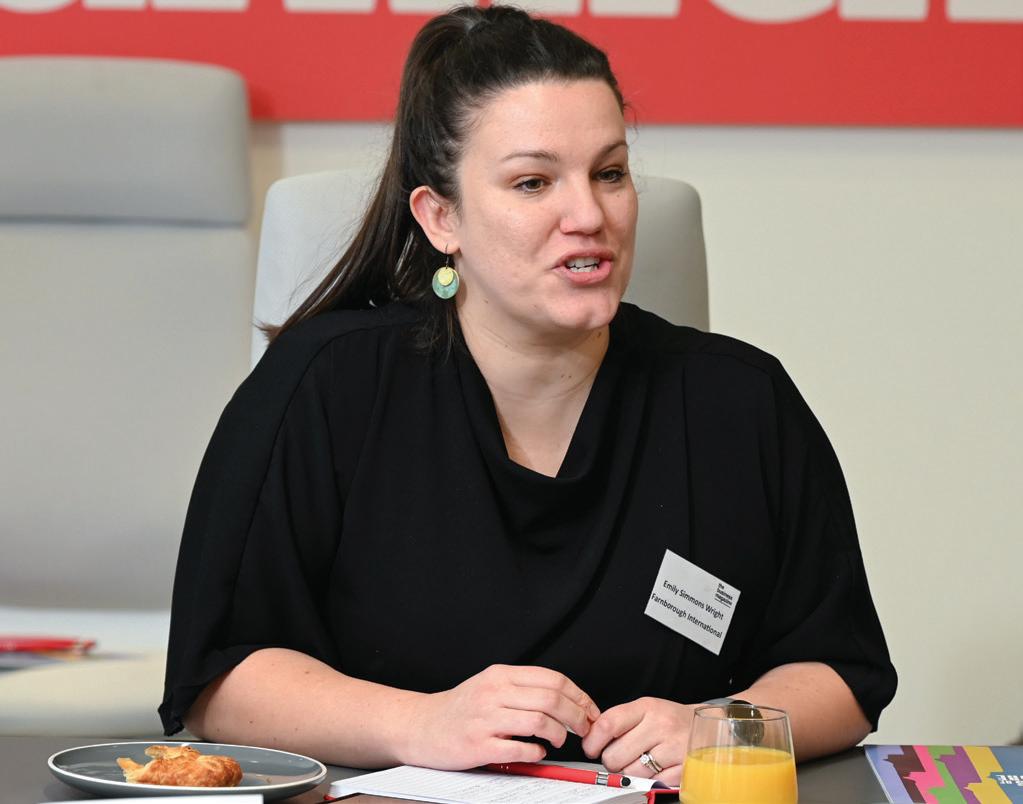
She said: “We are working on our proposition as a destination for people who book trade shows or conferences with us over a number of days.
“We suggest visiting nearby attractions in the New Forest or Southampton.
“We have been working with Visit Hampshire and Tourism South East to help create this story.”
Kyle Wilks, Co-founder and CEO of kitchen tech firm Labl IT, said technology could be used to automate mundane tasks and allow the industry to focus on service levels.
He said: “We need to look at the pieces within the industry that are easily automatable but don’t take away from the human element.
“Automation of the manual processes that people have to do day-in and day-

out allows them to spend more time with customers.
“I think we are a long way off from Artificial Intelligence (AI) servers. People enjoy the personal experience of hospitality, and I don’t think that will ever change.”
Cesare McArdle, a Partner at Herrington Carmichael, agreed that people were central to hospitality and said that technology should be used to amplify the strengths of a hospitality business.
He said: “I don’t think the customer-facing experience will change, at least not in my lifetime.
“What you will get is people using AI to amplify the unique selling point of the business such as using it to generate a tailored menu.
“What Covid taught us is that flexibility is key to survival in business and AI can be used to predict trends and then order supplies based on that data.”

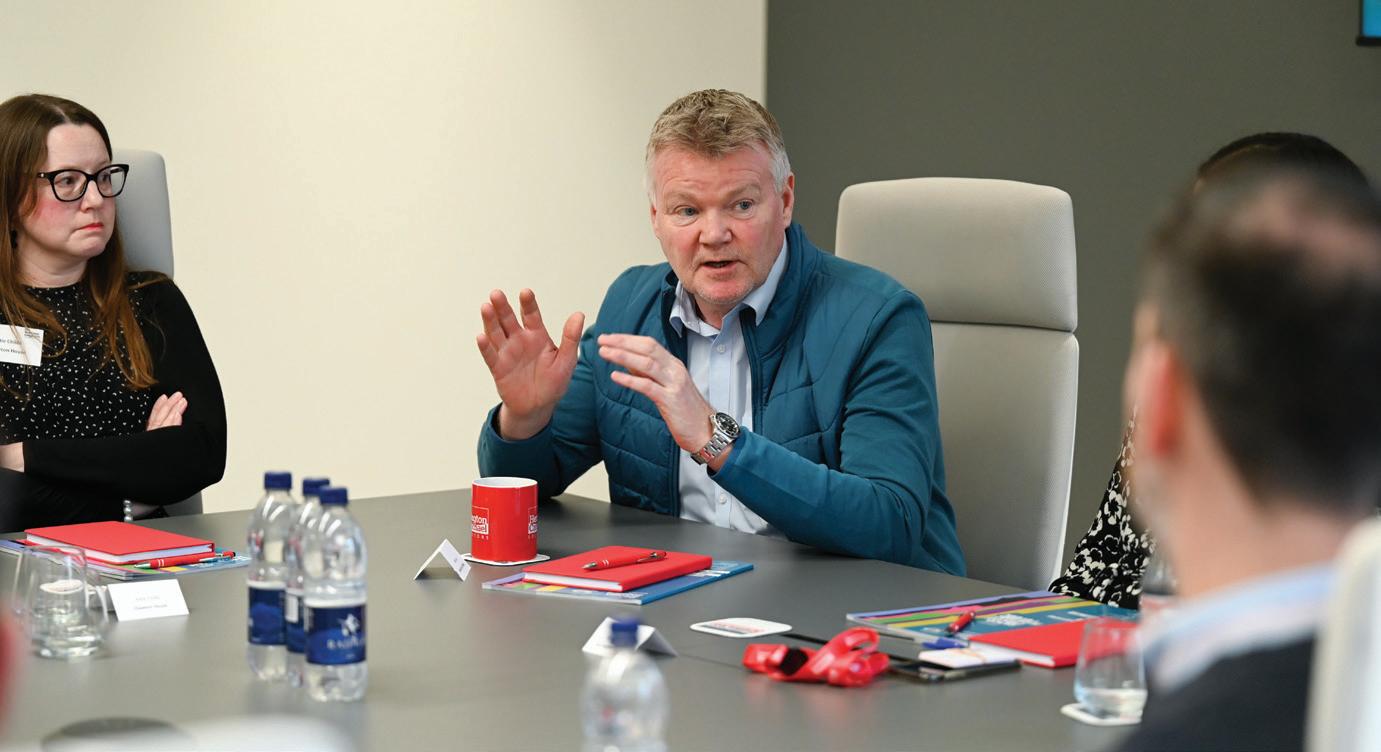
Front of house automation solutions have been around for years, according to Robin Hay, a Director at London-based bespoke caterers Bennett Hay, but they had not captured a mass market.
He said: “There have been a number of AI solutions for reception desks that have come on the market, even before Covid, however they are not getting traction yet.
“People using buildings, I feel, still prefer to be welcomed by a human being. I thought it would have a bigger market share by now, however it may be coming.”
Simon Numphud agreed that the industry had advanced its use of technology in recent years, however many companies were operating in technology ‘silos’ that had limited their ability to collaborate.
He said: “It is all about connectivity and the ability of hospitality businesses applications to talk to one another because then you can collate all of the data and analyse it properly.
“If you have different applications that don’t talk to each other, that creates a very clunky guest experience.
“One of the problems that the industry has to overcome is having a holistic approach to creating a seamless guest journey.”
Access to capital in order to make technology investments was an obstacle for many hospitality businesses according to Sheryl Davis, a Partner at Saffery, the chartered accountants, tax and business advisers in High Wycombe. However, there are favourable capital allowances available to provide tax relief on any such investment.
She said: “Companies struggle to make the change when they are already set up, as it can be harder to modernise existing systems than introduce new ones.
“As a result, long established hospitality businesses may find themselves left behind newer entrants to the industry who bring the latest tech with them.”
Sheryl added: “We have seen a big change in the ownership structure within the hospitality industry.
“It has moved away from lifestyle ownership towards hospitality being viewed as more of an investment opportunity.
“Your average lifestyle owner suffered a lot during Covid and many have moved out of the industry.
“This has created a lot of opportunities for creative entrepreneurs to launch more bespoke experience outlets.”
Many companies have benefitted from collecting and analysing data sources
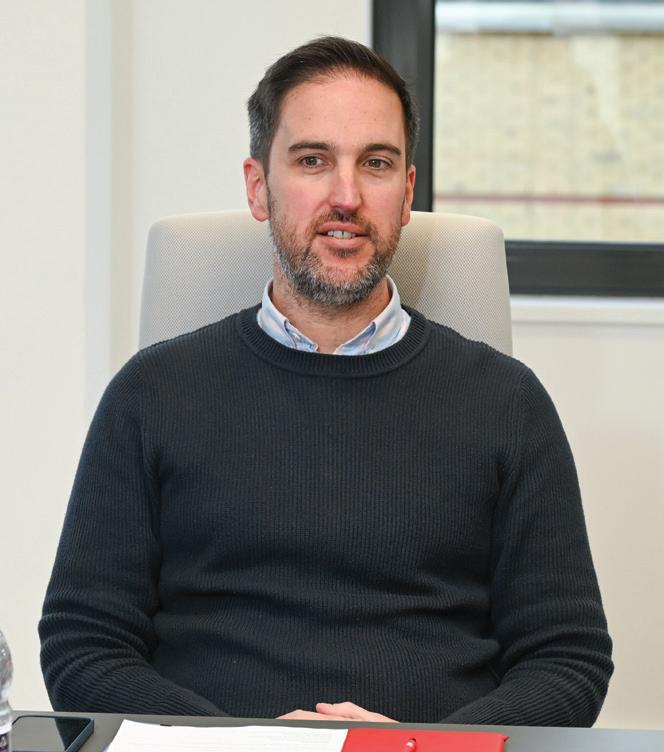
which has allowed them to make better business decisions. The roundtable agreed that the hospitality industry had been slow to embrace the opportunities afforded by big data.
Kyle Wilks said: “I think the hospitality industry has been a bit behind the curve when it comes to using big data for strategic effect.
“This is one thing that we could get better at in terms of analysing trends and making informed decisions based on the data.”
Darren Smith, a Partner at Herrington Carmichael, said the hospitality industry was not alone in failing to take advantage of the data opportunity.
He said: “I work across different industries and everyone recognises the need to analyse big data, draw assumptions and work from that.
“Everyone recognises this but people are struggling to do this.”

With global warming becoming more apparent, it is little surprise that the hospitality industry is responding to increased consumer demands for a greener offering.
Sarah Banks, Director of Sales at Leonardo Hotels Southampton Cluster, said both consumer and business customers were keen to know her organisation’s green credentials. She said: “We have seen a real growth in global demand for sustainable travel arrangements.
“We have to be able to answer every question our global clients ask. We have really focused on our green credentials across the estate, not only for corporate customers to use us but for the environment as well.”
The pressure on large corporates to off-set their emissions through green initiatives applied through ESG (environmental, social, and governance) regulation has also increased in recent years.
Katie Childs, Chief Executive of country house and arts venue Chawton House in Hampshire, said that while support for corporations was welcome, it needed to be more joined up and targeted.
She said: “Because we run an estate, the visible effects of climate change are one of the things visitors see. We get support from corporate organisations because we are a charity. There is a lot of will from companies to help, however it is entirely through the provision of new trees.
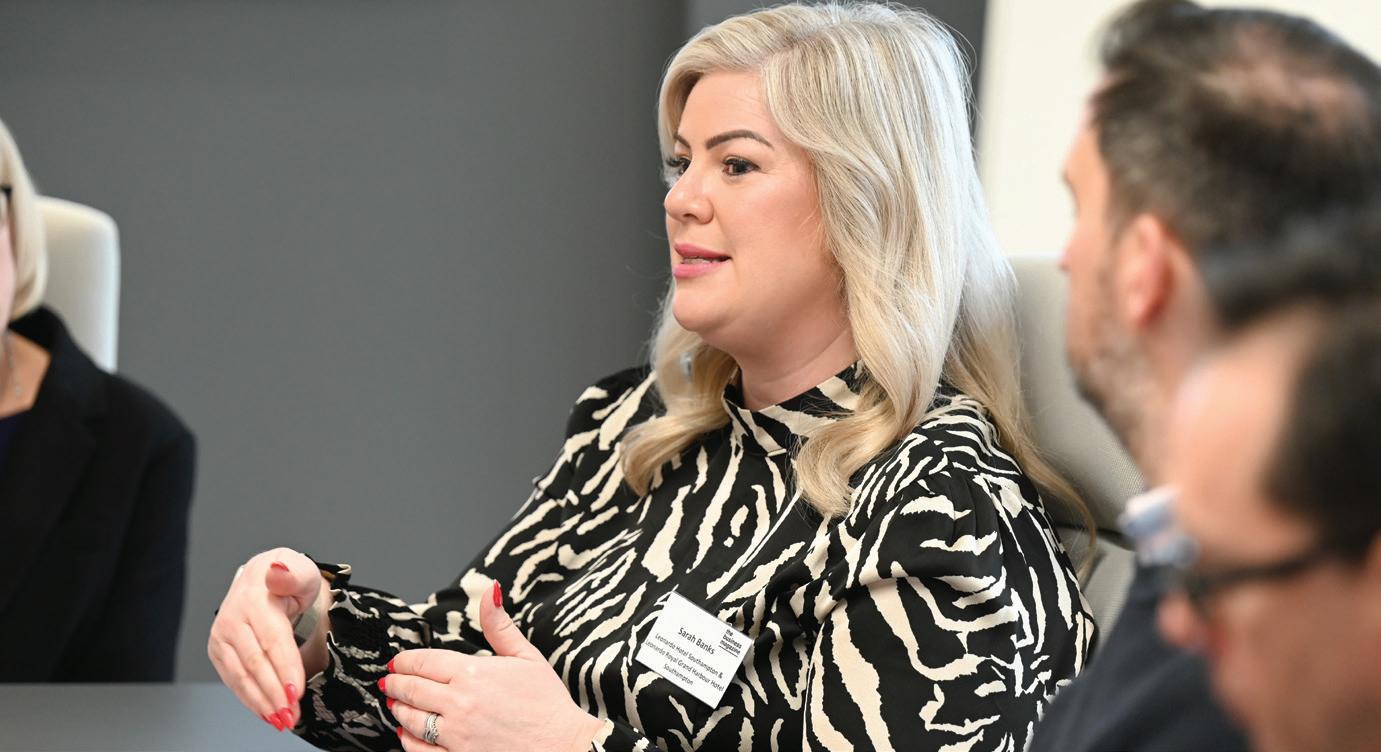
“As consumers, we have all become more conscious of eating better. Wellness is tied into this too and is one of the biggest growth areas of the market”
“I applied for 120 trees through a corporate scheme and 1,500 trees turned up.
“Corporate companies need to work closer with donors to make sure help is targeted, implementable and will make a difference.”
Rachel Duncan, a Partner at Herrington Carmichael, said that it was vital that hospitality companies had a clear ESG strategy to attract investment and revenue.“Larger corporates are increasingly looking for prominent ESG structures within businesses in which they
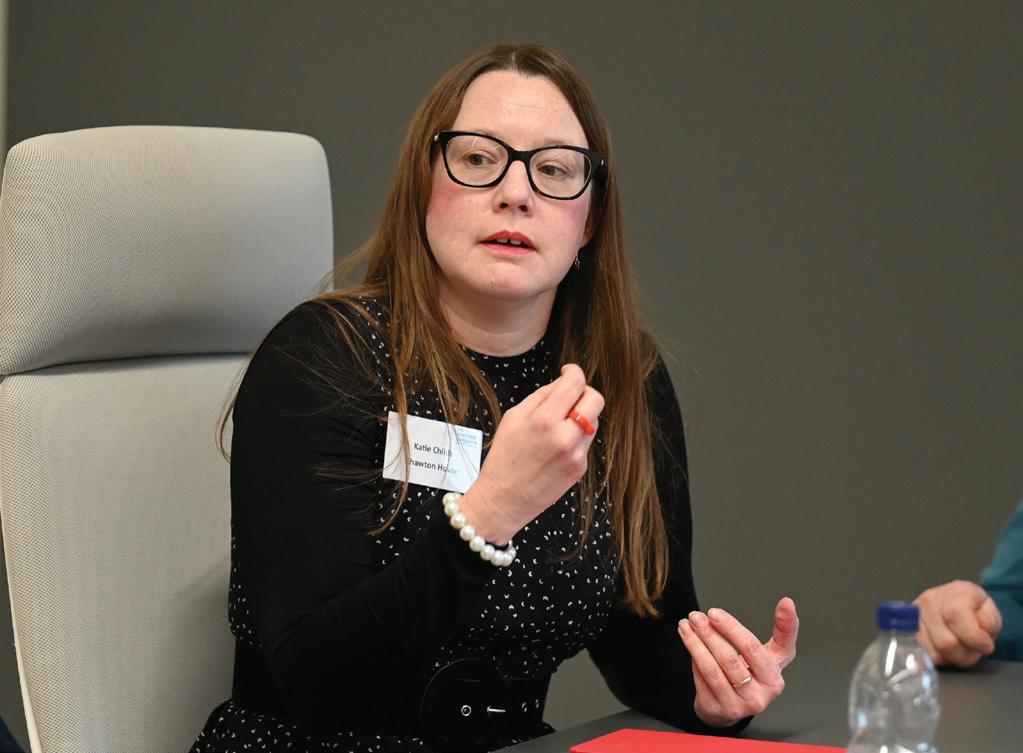
are investing or partnering. If you’re a leisure and hospitality business that can show evidence of your policy, it will be beneficial to you.”
Simon Numphud said the consumer push towards sustainability was also tied into more interest in the wellness sector.
He said: “As consumers, we have all become more conscious of eating better. Wellness is tied into this and is one of the biggest growth areas of the market. Businesses tapping into this opportunity will do well.”
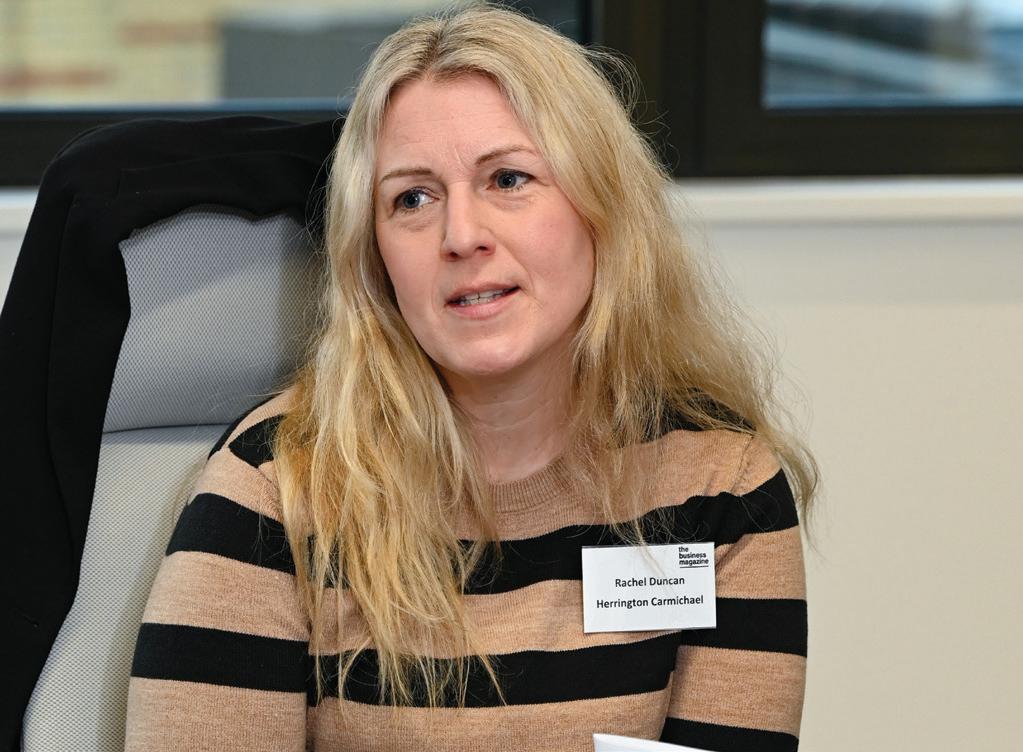
The impact of the pandemic has left a legacy on the industry, according to roundtable participants, with many arguing that aspects of the industry have been fundamentally reshaped.
Saffery’s Sheryl Davis said that the pressures of Covid had caused many owners to leave the trade.
She said: “We have seen a big change in the ownership structure within the hospitality industry away from lifestyle ownership, towards it being viewed as more of an investment.
“Your average lifestyle owner suffered a lot during Covid and many have made the decision to move out of the industry.
“This has created a lot of opportunities for creative entrepreneurs to come with experience outlets.”
Sam Sutton, owner of Hampshire outdoors centre New Forest Activities, said he pivoted his business model during Covid towards smaller groups.
He said: “We had to change our business model and go out in multiple smaller groups, as this was part of the conditions of being able to open.
“We found that customers actually really loved this and the fact that they had a really bespoke experience.”
Rachel Duncan of Herrington Carmichael said that many hospitality businesses were looking to free up money held in property.
She said: “The leisure and hospitality industry is still under huge cost pressures from Covid.
“The cost-of-living crisis is affecting consumer demand with high energy and material prices also putting pressure on hospitality businesses.
“It has never been more essential for businesses to practise careful costmanagement, particularly when it comes to buildings. Increasingly businesses are divesting non-profitable assets and focusing on parts of the business that are more profitable.
“This has created a lot of opportunities for creative entrepreneurs to come up with experience outlets.”
“People within the industry are also focused on developing stronger partnerships with suppliers rather than it being based strictly on demand and supply.”
Cesare McArdle of Herrington Carmichael said that this increased focused on partnerships in the industry was noticeable during the Covid period.
He said: “There wasn’t very much to enjoy about Covid but where I was working with the hospitality industry, the one thing that I did enjoy was the collaboration.
“If a company had breached a contract, the reaction during that time would be how do we fix this rather than going down a legal route.
“There was a feeling that we were in this situation together and we have to help each other through it. Now we are out of the other side of Covid, the clients we work with have ensured that they have up-to-date terms and conditions which are reflective of the way their business works and are flexible enough to deal with these unforeseen circumstances “
Robin Hay of Bennett Hay said city centre hospitality operators were struggling with the effects of hybrid working on footfall.
He said: “There are a number of changes happening with London. You have HSBC moving out of Canary Wharf and into a smaller space as they are adapting to how people work. There is less of a requirement for floor space.
“We are seeing people come back into the office on Tuesday, Wednesday and Thursday with Monday and Friday being the quieter days.
“We are seeing a rise in trade on Mondays, however Friday remains a particularly tough nut to crack.”
The shortage of hospitality workers is affecting every panellist’s business, and the problem can only be solved by making the career more attractive.
Sarah Banks said: “The hospitality industry is not a career choice like being a lawyer or a pilot. But there are so many options. You can move into HR, sales or be an executive head chef at a top London hotel.
“There are so many opportunities, but you need to stick at it and get the passion for the industry you work in and work your way up.”
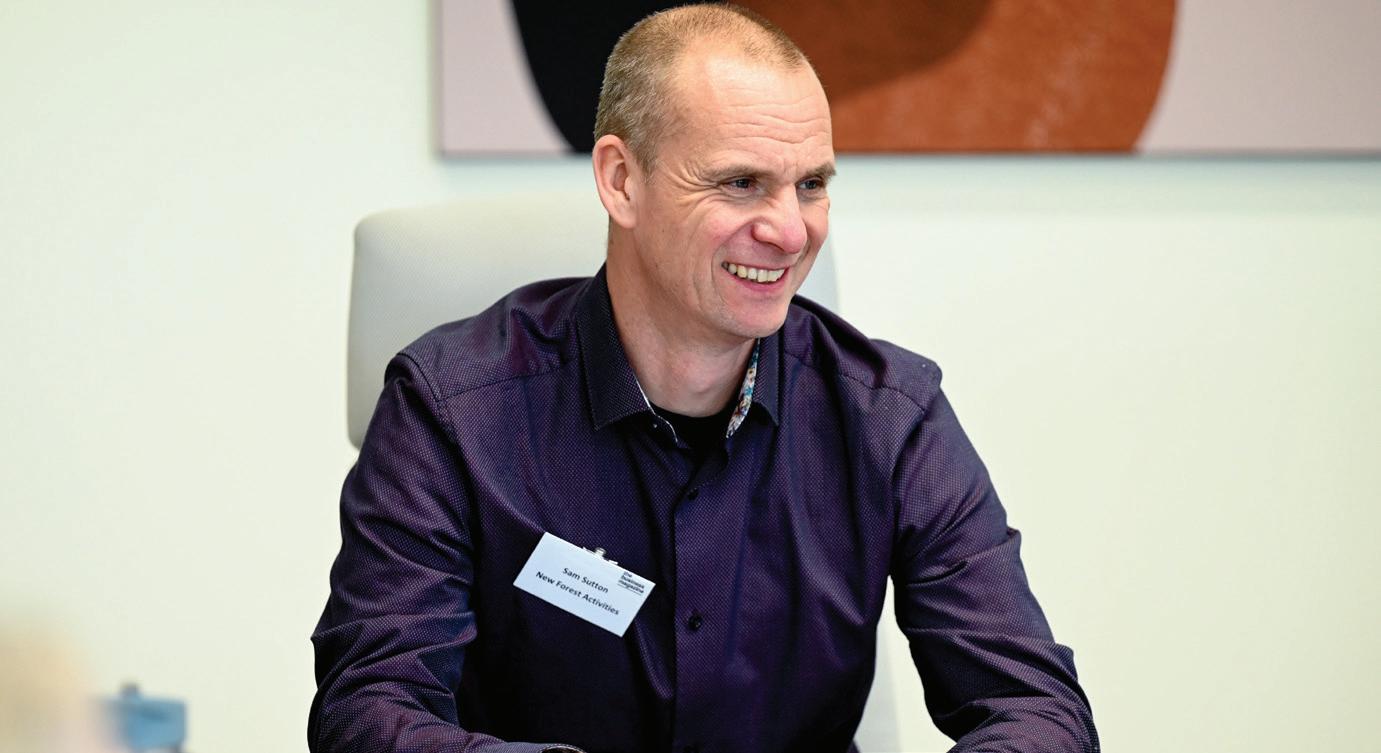

Darren Smith of Herrington Carmichael said the industry needed to promote itself as a long-term career option for school leavers.
He said: “One of the key issues is promoting the idea that coming into the industry can be a long-term thing.
“The industry is used to casual labour coming in and then leaving to go into other fields.
“How do we change that so people consider staying within the industry?”
Kyle Wilks echoed this point and said that the sector needed to get better at telling its own story.
He said: “Hospitality has to work on how to tell its story and share how people enjoy working in the industry.
“If we as an industry can tell exciting and engaging stories, that will help with the recruitment side of things.”
In April this year, the government increased the salary threshold for the skilled worker visa route to £38,700.
This has led to fears that the shortage of workers in the sector will only worsen.
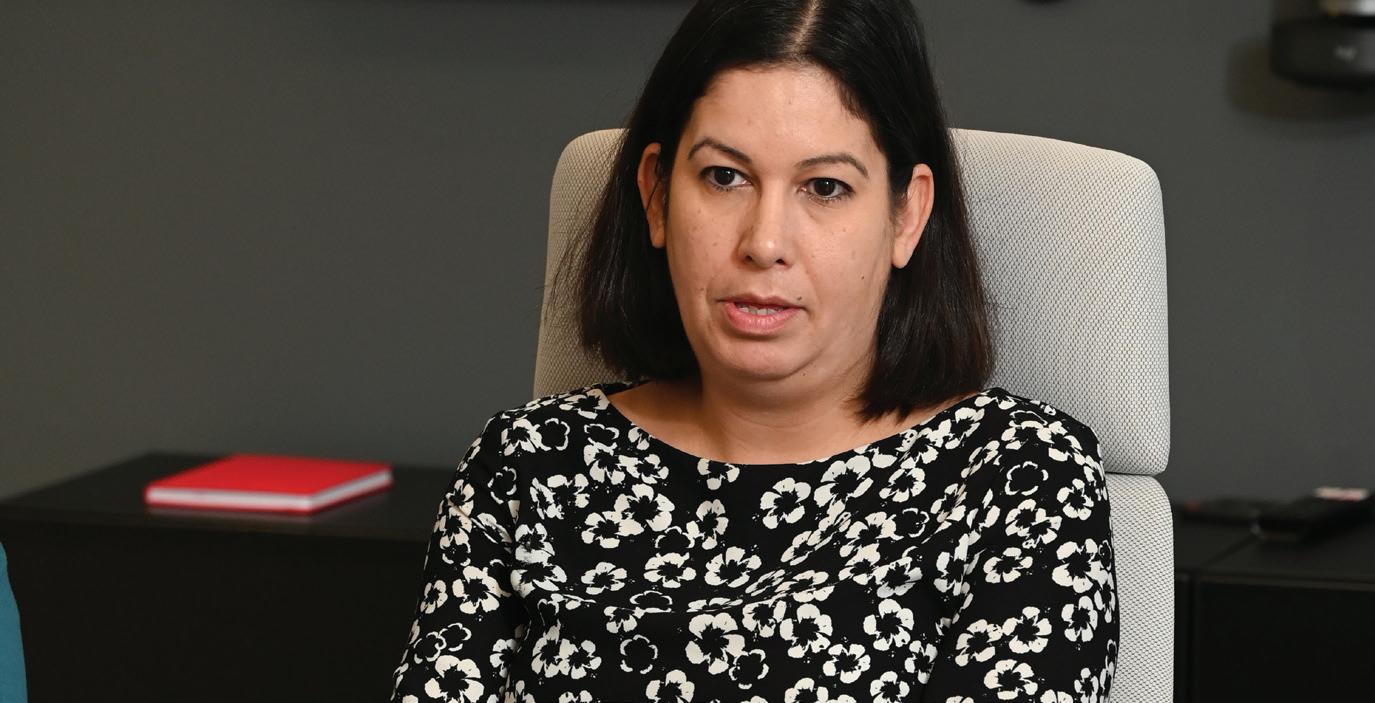
Sherry Fitzgerald said: “Businesses are already struggling with recruitment and these will be made worse by salary thresholds going up.
“They’re not going to be able to rely on that sponsorship route, so they’re going to be even more important now that they do become more appealing to the younger generation.”
The hospitality industry has long faced competition for younger workers particularly from retail, however Katie Childs said providing youngsters with career opportunities was vital.
She said: “We were really struggling to recruit to our kitchen and our tearoom.
To attract staff, I had to consider what we can offer that Sainsbury’s and Waitrose can’t because the answer isn’t going to be money.
“We structured the jobs as general assistance where we trained them in how they could support the whole operation. We discussed what their long-term interests were for study or work. We gave one experience in communications and another in performing arts.
“We then looked at how we could support them and give them opportunities that they would not get anywhere else. The trade-off is that they have to work in the kitchen or the tearoom depending on where their skill sets lie.”
Hotels offer so much more than a place to stay. We pick some of the coolest across the South East
Along with helping to draw people to the region, hotels are home away from home for the travelling businessperson.
They’re also a backbone for trade and networking, with their bars and restaurants offering a place for meetings, and large conference centres for bigger events.
With a variety of natural beauty and history on offer, along with a vibrant business community, the south east features some of the coolest hotels in the county.
In this list we’ve brought together a collection of them – featuring everything from stunning stays in the region’s most attractive locations to unique gems which stand out from the crowd.


Perched on Bournemouth’s stunning West Cliff, THE NICI recently undertook a multi-million pound refurbishment project, bringing a luxury spa, 30 metre outdoor pool, fire pits and more.
A grand building featuring sea views from many of its rooms, THE NICI makes the most of Dorset’s natural beauty to stand out from the crowd.
Based in New Milton, Hampshire, Chewton Glen oozes luxury and quality across its entire premises, complete with all the beauty of the New Forest.
One particularly standout feature are its treehouses: self-contained suites featuring kitchenettes, breakfast hampers and a personal hot tub.





Situated on a private island on the River Thames, the Monkey Island Estate is one of the oldest hotels on this list, with a history dating back 800 years which boasts the patronage of monarchs, aristocrats and artists.
Today, the site features accommodation and dining, a floating spa, and space for meetings and events in Bray, a village just five miles from Windsor which boasts two of the four 3-Michelin-starred restaurants in the UK.

Sitting among working farmlands in the Oxfordshire countryside, the Crazy Bear in Stadhampton features luxury facilities in a unique design which plays on both modern and rustic elements.
This is a theme the hotel maintains throughout with its wider offering including space for business meetings as well as tastings, masterclasses and outdoor pursuits such as duck herding, axe and knife throwing, and even a land zorb arena.

THE PIG started out with a single site in Hampshire and has since grown to 11 sites from Devon, up to Gloucestershire and down to Kent.
Above all else, THE PIG is one for foodies who want to get away from the hustle and bustle of urban areas and escape to the countryside, with all their produce either grown, reared or sourced locally.



As its name would suggest, The Vineyard in Berkshire prides itself on a fantastic wine list to accompany its food offering, with a wine cellar on full show to residents.
With a range of different sized meeting spaces available, some of which are named after vineyards owned by the Michael family (who also own the hotel), the Vineyard offers a great place to hold a conference or event.
Most of us can only imagine what life would have been like living in a castle as a member of the aristocracy.
Guests at Leeds Castle, however, can get a taste of living life in luxury, staying in rooms which have previously hosted the Duke and Duchess of Windsor, Winston Churchill and Charlie Chaplin.
The castle’s wider site also features a number of other accommodation options including lakeside lodges and glamping.


Great Fosters in Egham, Surrey is a Tudor Estate set in 50 acres of gardens and grounds complete with listed parterres, a fountain, Saxon moat, Japanese bridge and even a sundial gifted to the estate by Sir Francis Drake.
For the foodie, the hotel features two restaurants, one with a 2-AA rosette rating and another with a Michelin star. It also has events and function rooms.
Don’t fancy driving? No problem, as the estate features its own helipad, of course.
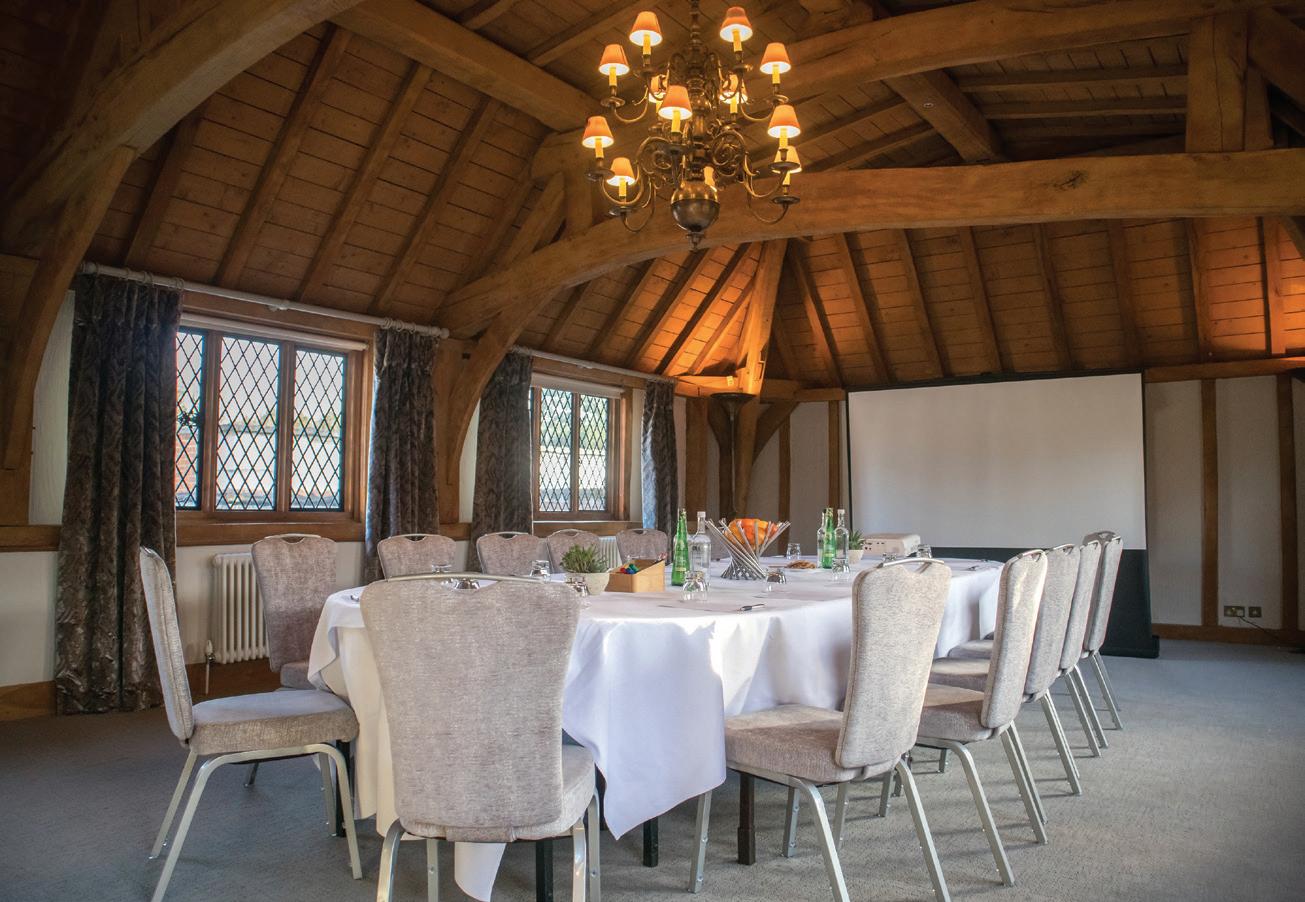
On the other end of the spectrum to many of the hotels featured on this list, and well suited to its Brighton location, the Hotel Pelirocco markets itself as ‘England’s most rock ‘n’ roll hotel’.
It features 19 individually themed bedrooms, along with space for conferences and away days, team-building, and business meetings – all a stone’s throw away from Brighton’s West Pier.

Rounding out our list with something a little different, The Mermaid Inn in Rye, Sussex dates back all the way to 1420 (that’s before Henry VIII was even born), with its cellar going back even further to 1156.
Steeped in history, the hotel has seen a variety of ghost sightings over the years. Situated in the medieval citadel of Rye, the former smuggler’s inn is surrounded by cobbled streets and independent shops.




South East edition: Oxfordshire & Thames Valley Berkshire & Buckinghamshire
Surrey, Kent & Sussex Solent & South Coast
South West & West Midlands edition: Bristol & Bath, Gloucestershire, Worcestershire & Hereford, Coventry & Warwickshire, Swindon & North Wiltshire
The region’s most influential B2B magazine, in print and online for news, features, interviews and business sector analysis.
2024 Print issues will be published in January, March, May, July, September and November
Managing Director Richard Thompson richard.thompson@thebusinessmagazine.co.uk
Managing Editor Stephen Emerson stephen.emerson@thebusinessmagazine.co.uk
Operations Director Jo Whittle jo.whittle@thebusinessmagazine.co.uk
Visit our magazine online thebusinessmagazine.co.uk
Follow us: @TheBusinessMag linkedin.com/company/the-business-magazine
Magazine Design: Origin Creative I www.origin-creative.com
Magazine Printers: The Manson Group I www.mansongroup.co.uk
Editorial
Print Editor Nicky Godding nicky.godding@thebusinessmagazine.co.uk
Research & Rankings
Researcher Laura Clarke laura.clarke@thebusinessmagazine.co.uk
Events
Events Executive Lauren McCarron lauren.mccarron@thebusinessmagazine.co.uk
Events Executive Kimberley McLean kimberley.mclean@thebusinessmagazine.co.uk
Marketing
Digital Marketing Scott Whittle scott.whittle@thebusinessmagazine.co.uk
Commercial
Head of Client Relations Peter Laurie Thames Valley peter.laurie@thebusinessmagazine.co.uk
Business Manager Alan Lindstrom
South Coast alan.lindstrom@thebusinessmagazine.co.uk
Media Sales Manager Alexandra Scrivener
South West & alexandra.scrivener@thebusinessmagazine.co.uk
West Midlands
Events events@thebusinessmagazine.co.uk
Accounts finance@thebusinessmagazine.co.uk
General Enquiries editorial@thebusinessmagazine.co.uk
Publisher: The Business Magazine Group Ltd – Company number 13202910
Registered Office: 24 Bell lane, Blackwater, Camberley, Surrey, GU17 0NW


